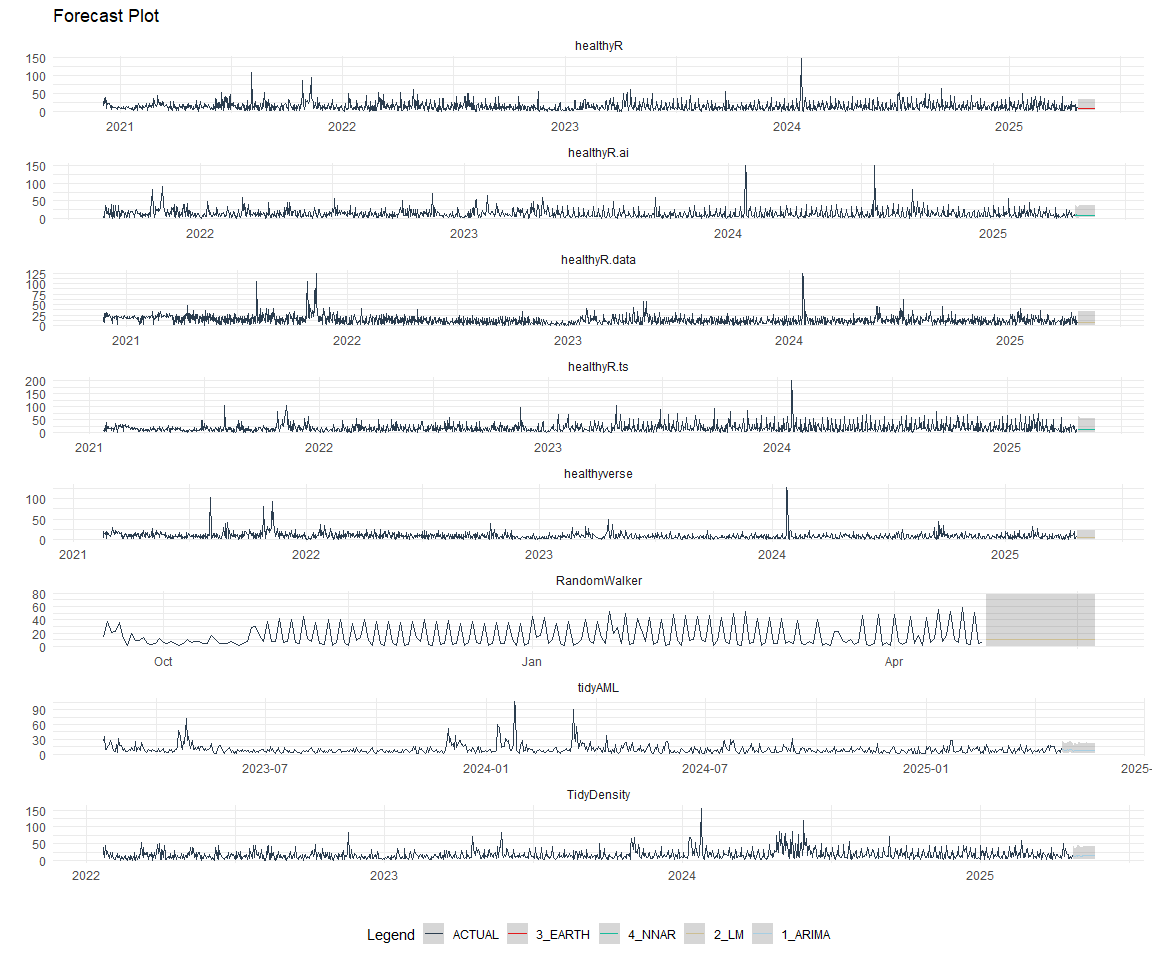healthyverse_tsa
Time Series Analysis, Modeling and Forecasting of the Healthyverse
Packages Steven P. Sanderson II, MPH - Date: 2025-12-18
Introduction
This analysis follows a Nested Modeltime Workflow from modeltime
along with using the NNS package. I use this to monitor the
downloads of all of my packages:
Get Data
glimpse(downloads_tbl)
Rows: 163,393
Columns: 11
$ date <date> 2020-11-23, 2020-11-23, 2020-11-23, 2020-11-23, 2020-11-23,…
$ time <Period> 15H 36M 55S, 11H 26M 39S, 23H 34M 44S, 18H 39M 32S, 9H 0M…
$ date_time <dttm> 2020-11-23 15:36:55, 2020-11-23 11:26:39, 2020-11-23 23:34:…
$ size <int> 4858294, 4858294, 4858301, 4858295, 361, 4863722, 4864794, 4…
$ r_version <chr> NA, "4.0.3", "3.5.3", "3.5.2", NA, NA, NA, NA, NA, NA, NA, N…
$ r_arch <chr> NA, "x86_64", "x86_64", "x86_64", NA, NA, NA, NA, NA, NA, NA…
$ r_os <chr> NA, "mingw32", "mingw32", "linux-gnu", NA, NA, NA, NA, NA, N…
$ package <chr> "healthyR.data", "healthyR.data", "healthyR.data", "healthyR…
$ version <chr> "1.0.0", "1.0.0", "1.0.0", "1.0.0", "1.0.0", "1.0.0", "1.0.0…
$ country <chr> "US", "US", "US", "GB", "US", "US", "DE", "HK", "JP", "US", …
$ ip_id <int> 2069, 2804, 78827, 27595, 90474, 90474, 42435, 74, 7655, 638…
The last day in the data set is 2025-12-16 23:04:24, the file was birthed on: 2022-07-02 23:58:17.511888, and at report knit time is 3.03071^{4} hours old. Happy analyzing!
Now that we have our data lets take a look at it using the skimr
package.
skim(downloads_tbl)
| Name | downloads_tbl |
| Number of rows | 163393 |
| Number of columns | 11 |
| _______________________ | |
| Column type frequency: | |
| character | 6 |
| Date | 1 |
| numeric | 2 |
| POSIXct | 1 |
| Timespan | 1 |
| ________________________ | |
| Group variables | None |
Data summary
Variable type: character
| skim_variable | n_missing | complete_rate | min | max | empty | n_unique | whitespace |
|---|---|---|---|---|---|---|---|
| r_version | 119920 | 0.27 | 5 | 7 | 0 | 50 | 0 |
| r_arch | 119920 | 0.27 | 1 | 7 | 0 | 6 | 0 |
| r_os | 119920 | 0.27 | 7 | 19 | 0 | 24 | 0 |
| package | 0 | 1.00 | 7 | 13 | 0 | 8 | 0 |
| version | 0 | 1.00 | 5 | 17 | 0 | 62 | 0 |
| country | 15313 | 0.91 | 2 | 2 | 0 | 166 | 0 |
Variable type: Date
| skim_variable | n_missing | complete_rate | min | max | median | n_unique |
|---|---|---|---|---|---|---|
| date | 0 | 1 | 2020-11-23 | 2025-12-16 | 2023-11-08 | 1843 |
Variable type: numeric
| skim_variable | n_missing | complete_rate | mean | sd | p0 | p25 | p50 | p75 | p100 | hist |
|---|---|---|---|---|---|---|---|---|---|---|
| size | 0 | 1 | 1124293.44 | 1487029.96 | 355 | 29181 | 310324 | 2349544 | 5677952 | ▇▁▂▁▁ |
| ip_id | 0 | 1 | 11299.48 | 21939.64 | 1 | 228 | 2882 | 11921 | 299146 | ▇▁▁▁▁ |
Variable type: POSIXct
| skim_variable | n_missing | complete_rate | min | max | median | n_unique |
|---|---|---|---|---|---|---|
| date_time | 0 | 1 | 2020-11-23 09:00:41 | 2025-12-16 23:04:24 | 2023-11-08 23:25:30 | 103225 |
Variable type: Timespan
| skim_variable | n_missing | complete_rate | min | max | median | n_unique |
|---|---|---|---|---|---|---|
| time | 0 | 1 | 0 | 59 | 12H 6M 49S | 60 |
We can see that the following columns are missing a lot of data and for
us are most likely not useful anyways, so we will drop them
c(r_version, r_arch, r_os)
Plots
Now lets take a look at a time-series plot of the total daily downloads by package. We will use a log scale and place a vertical line at each version release for each package.
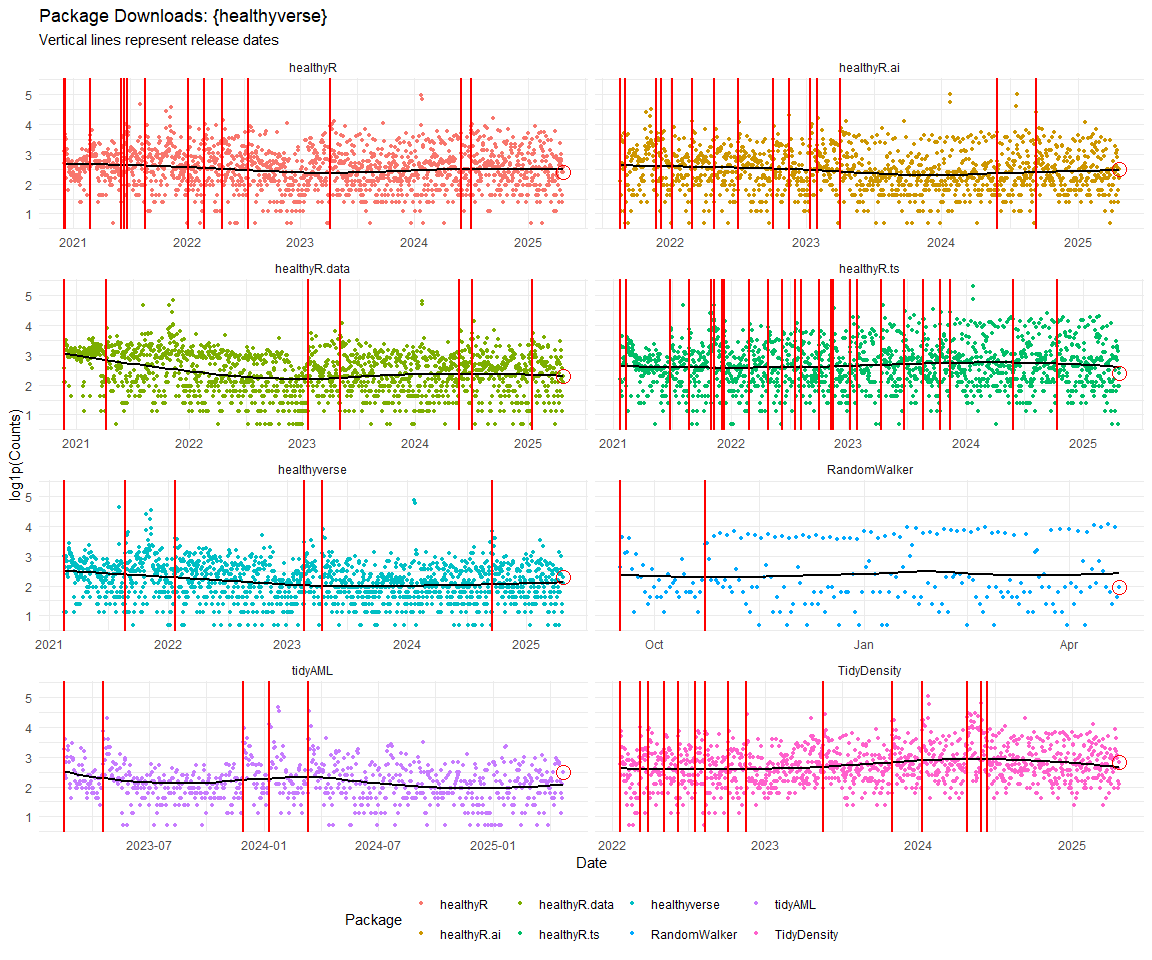
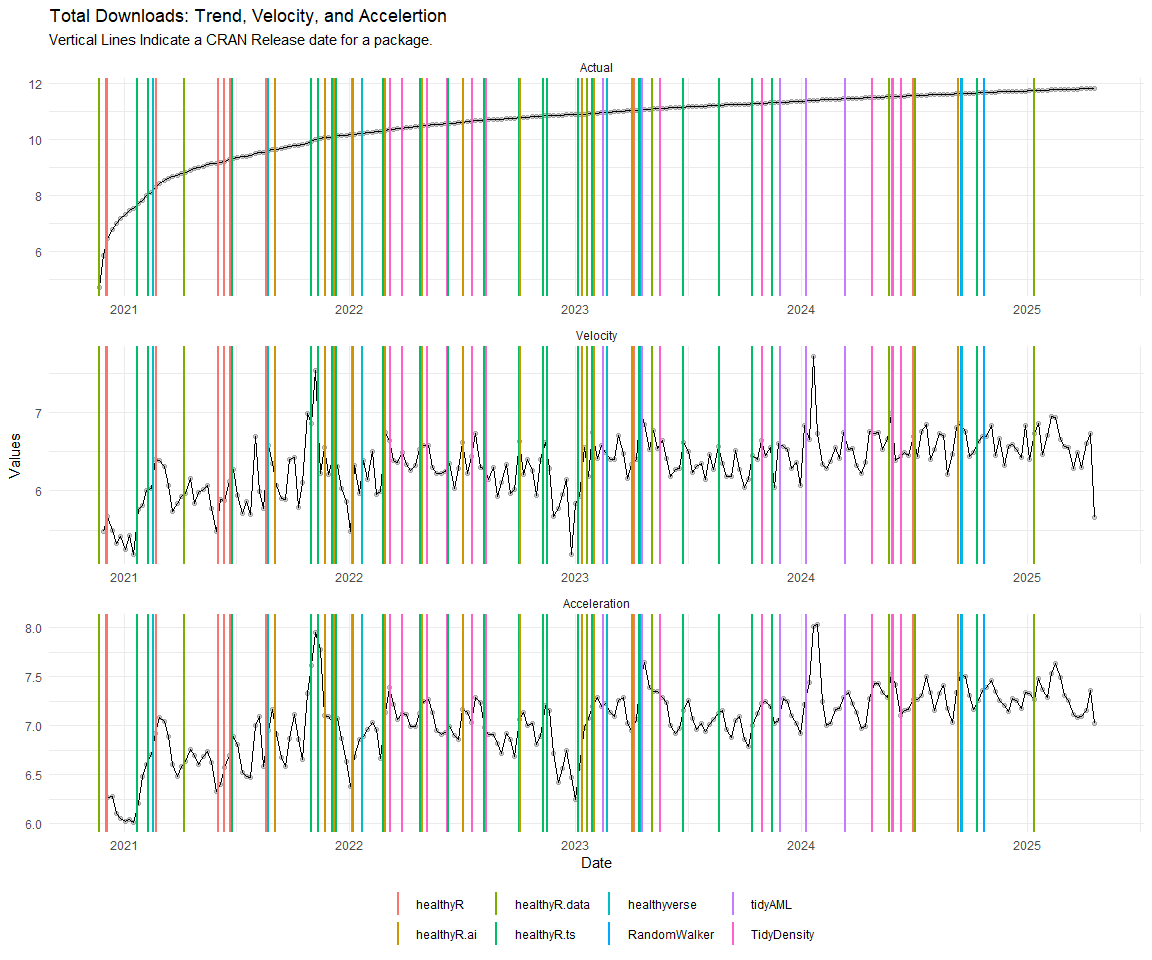
[[1]]
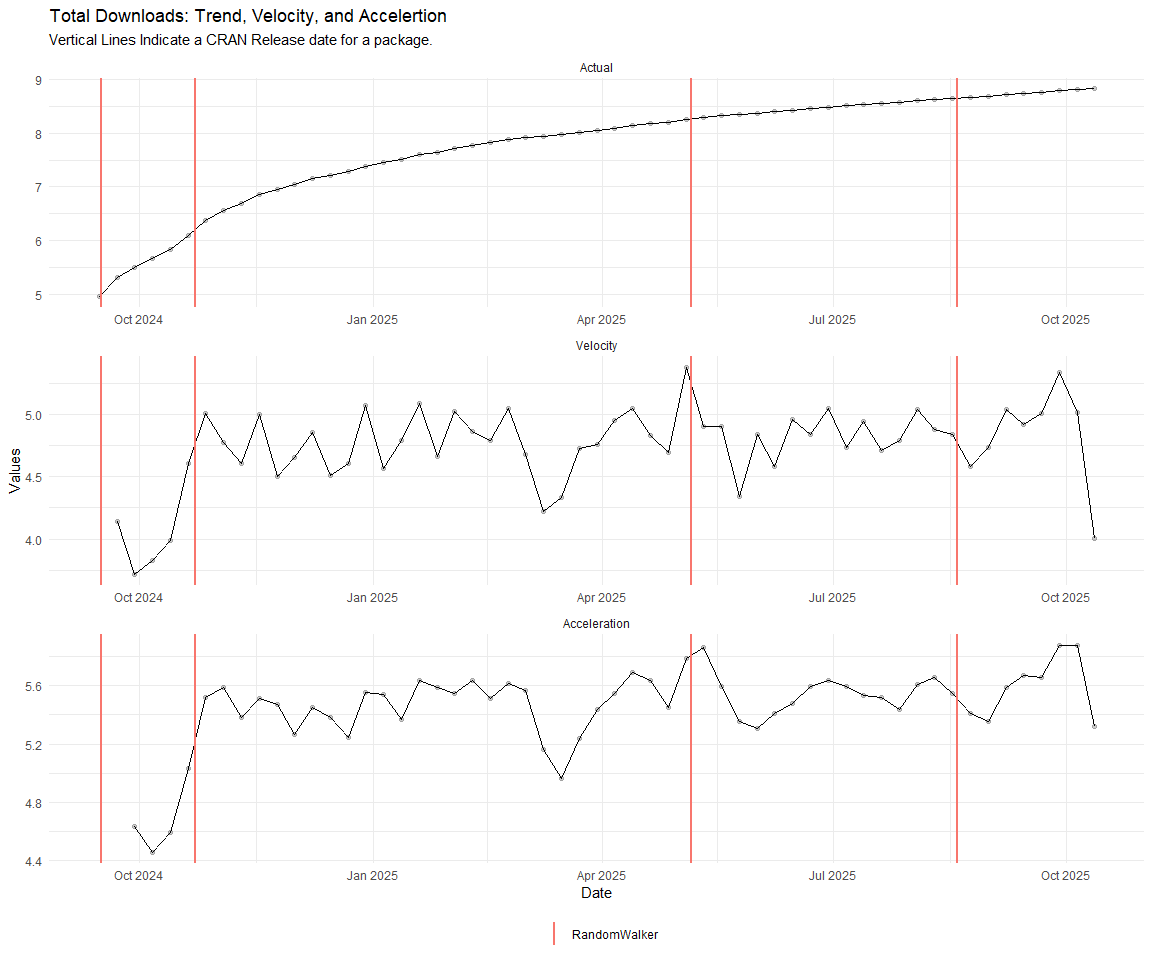
[[2]]
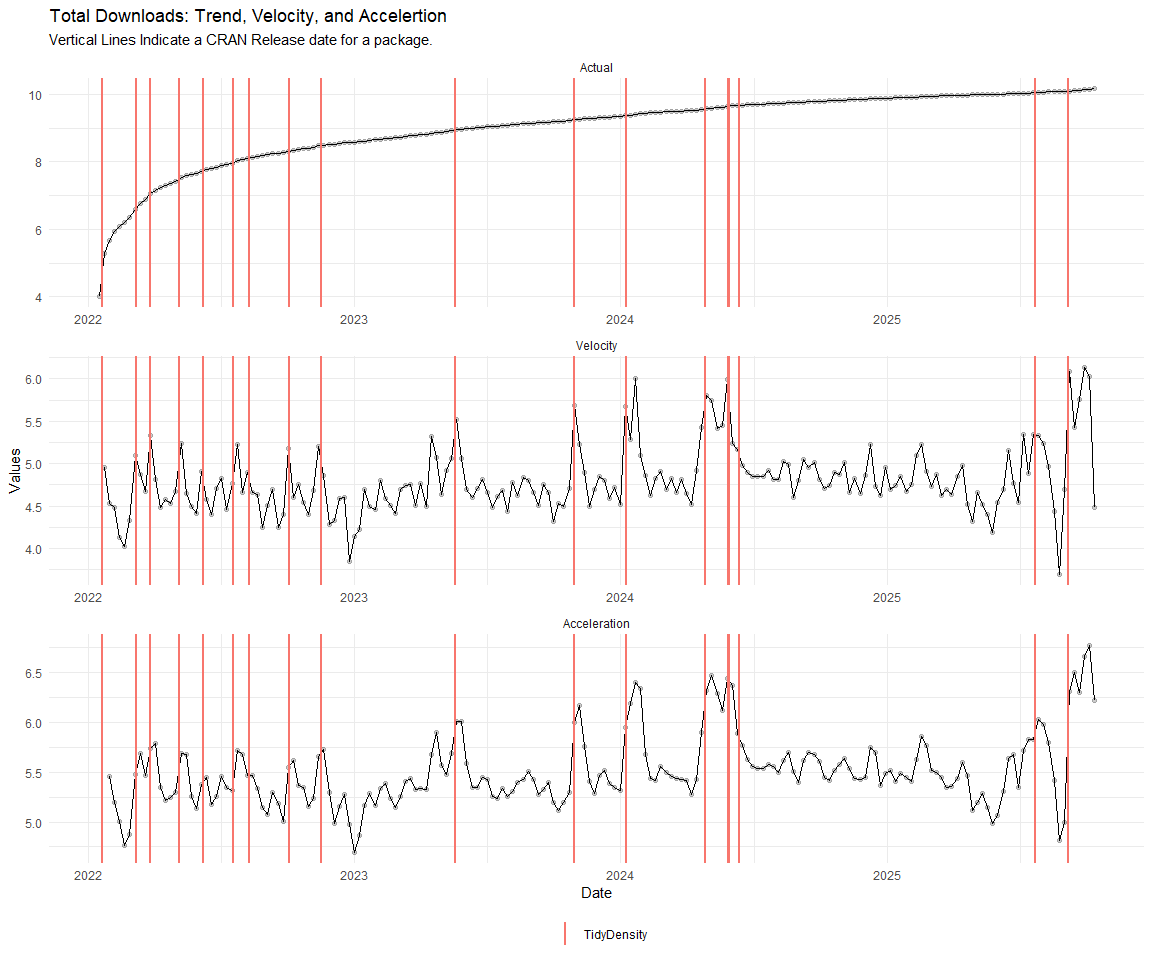
[[3]]
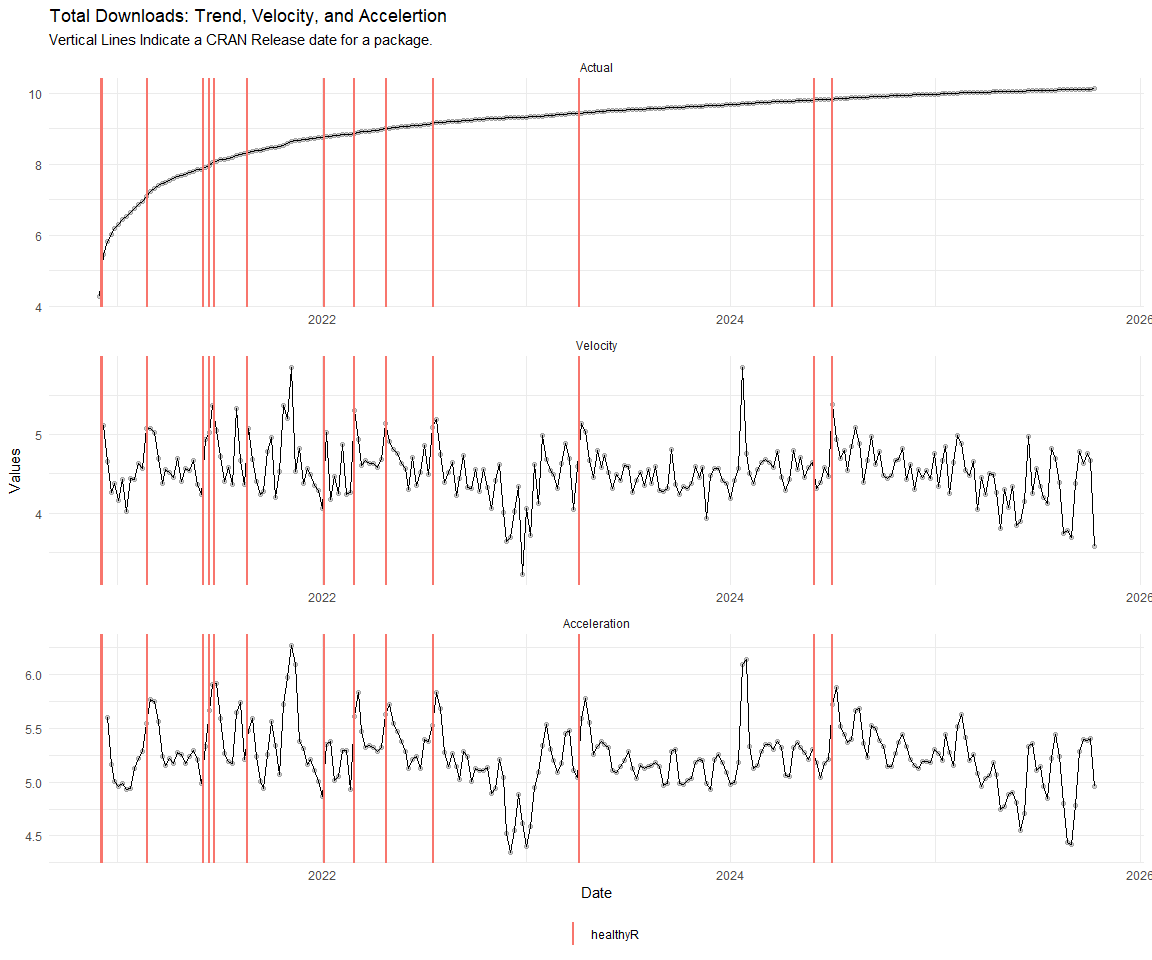
[[4]]
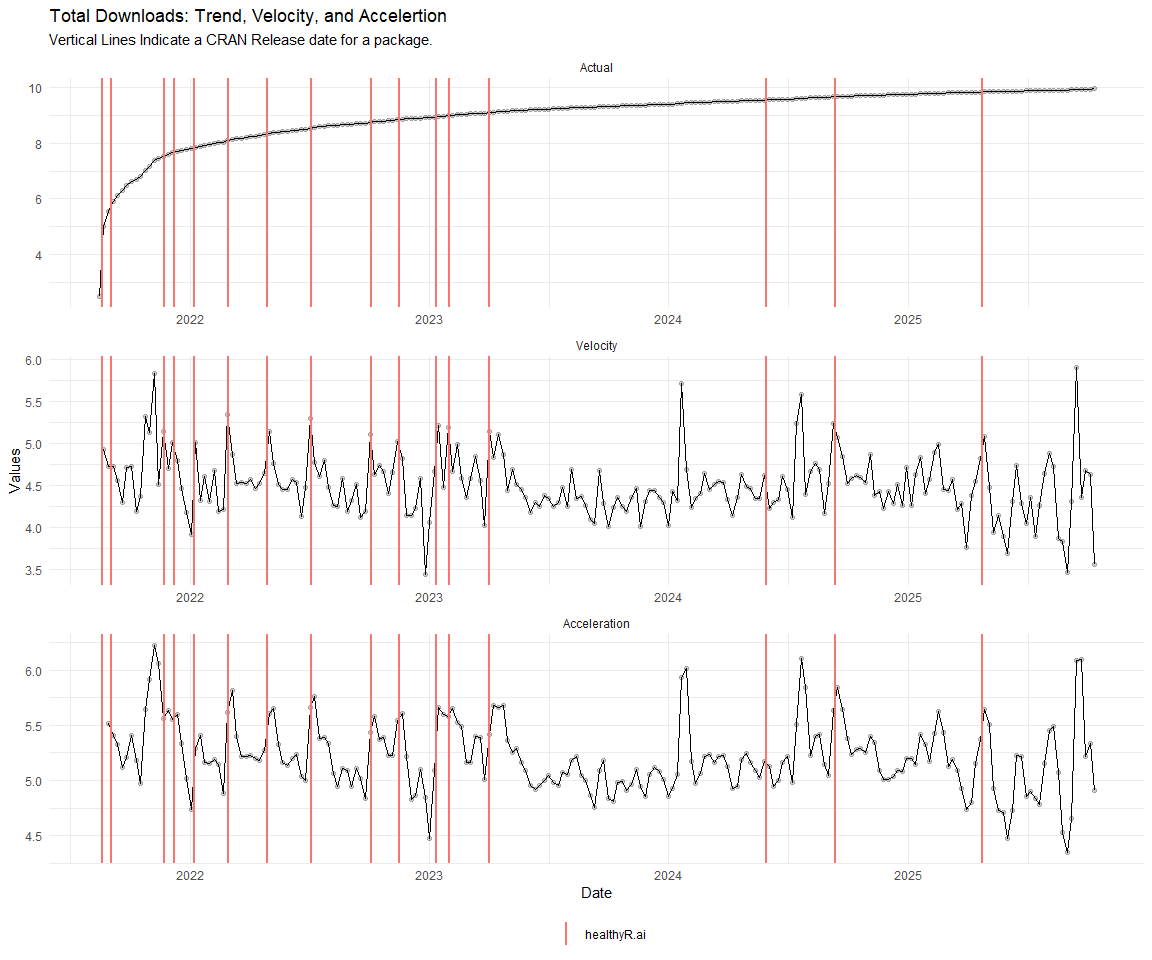
[[5]]
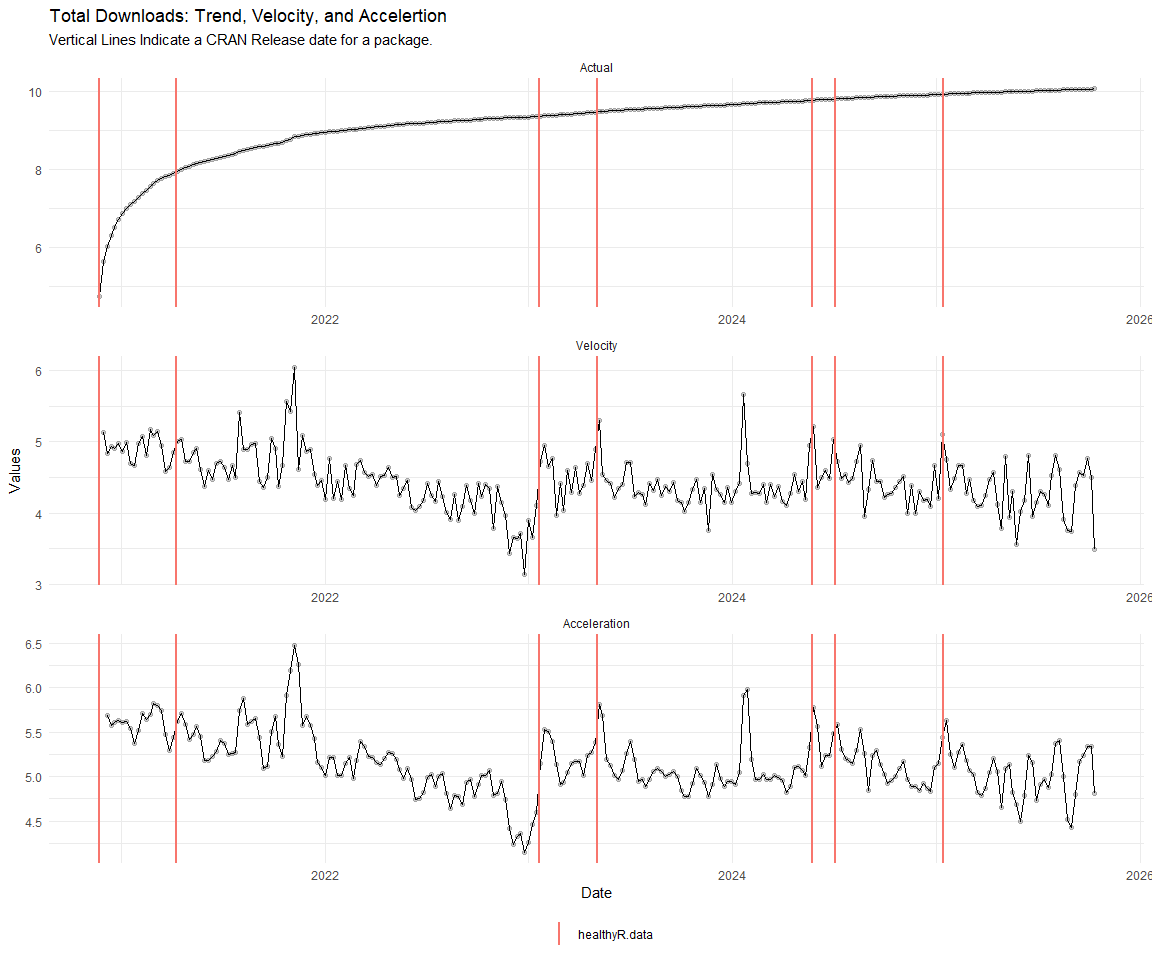
[[6]]
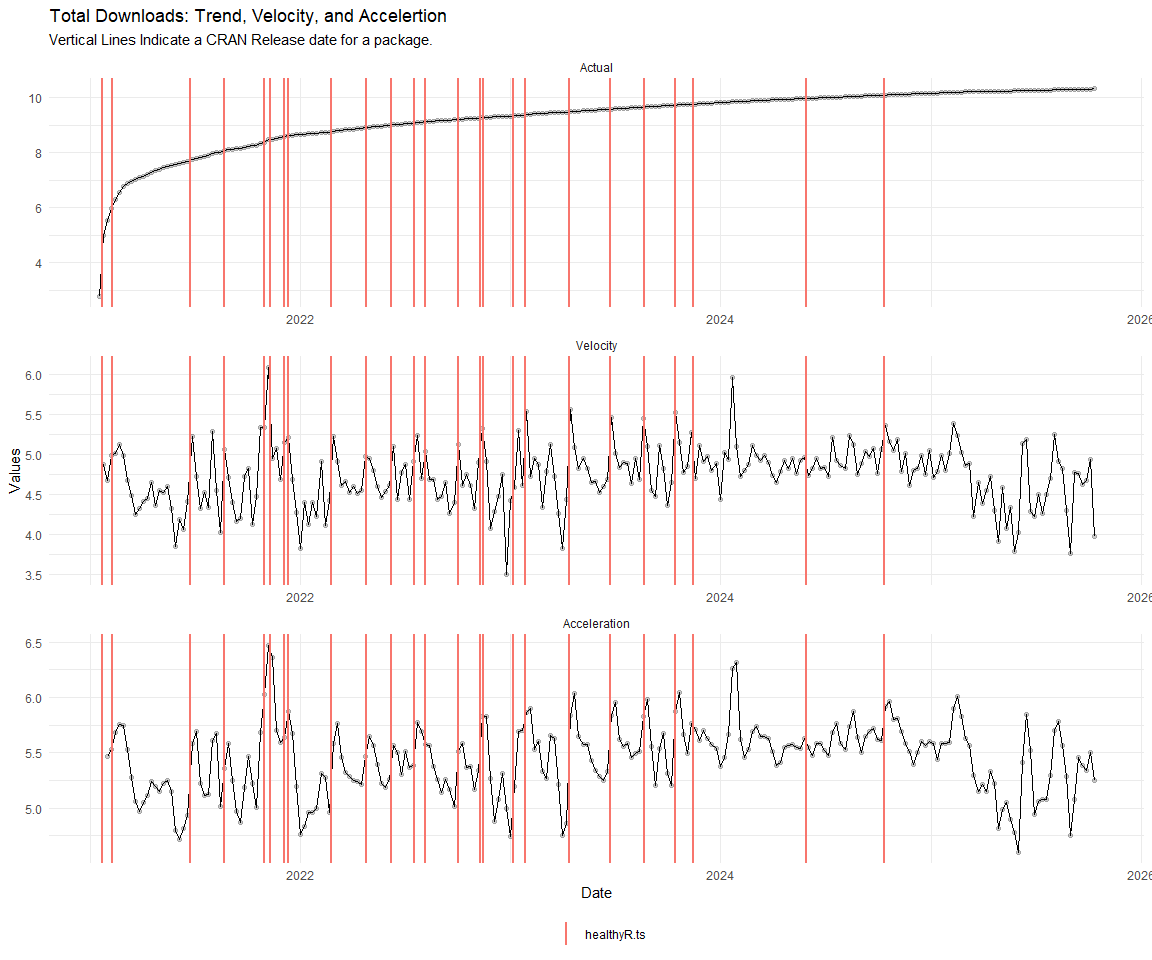
[[7]]
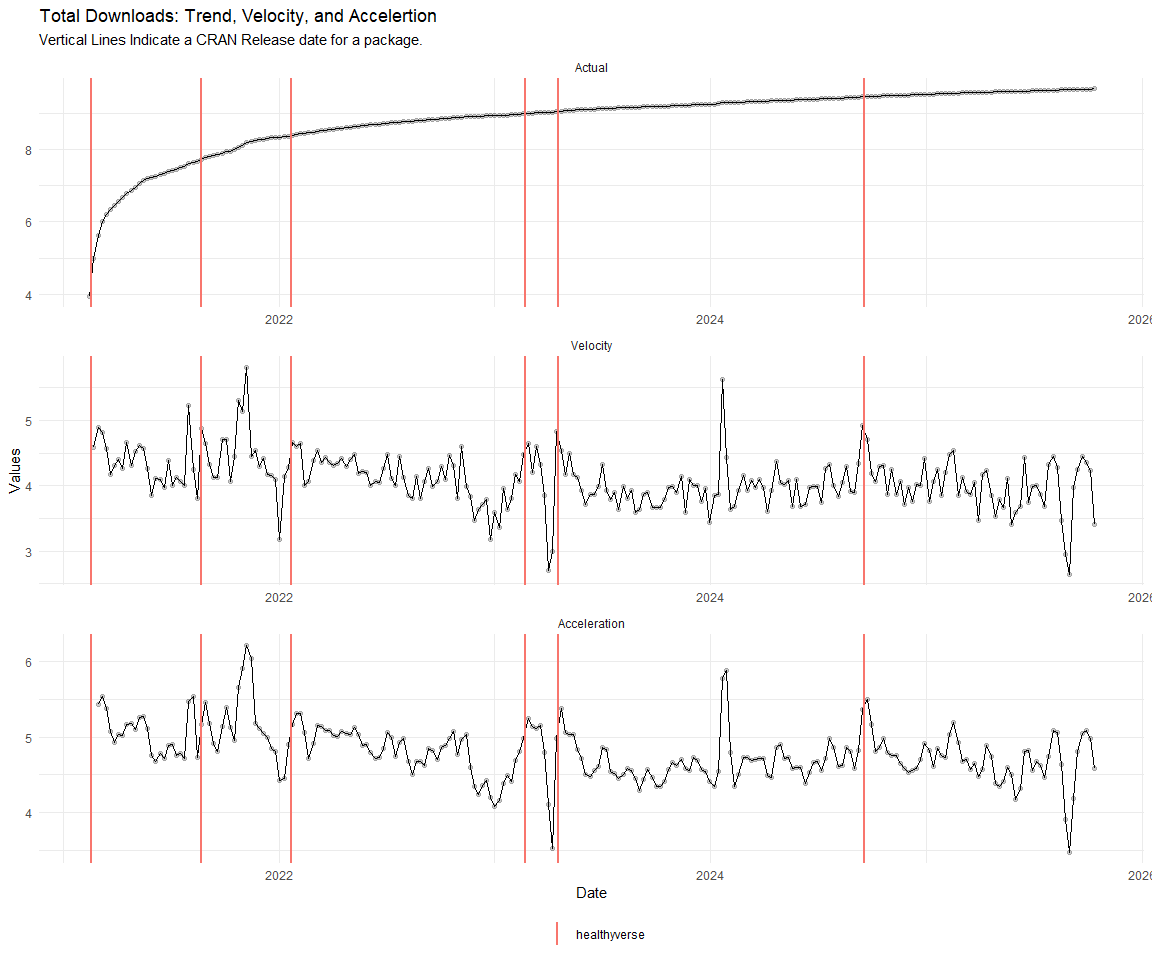
[[8]]
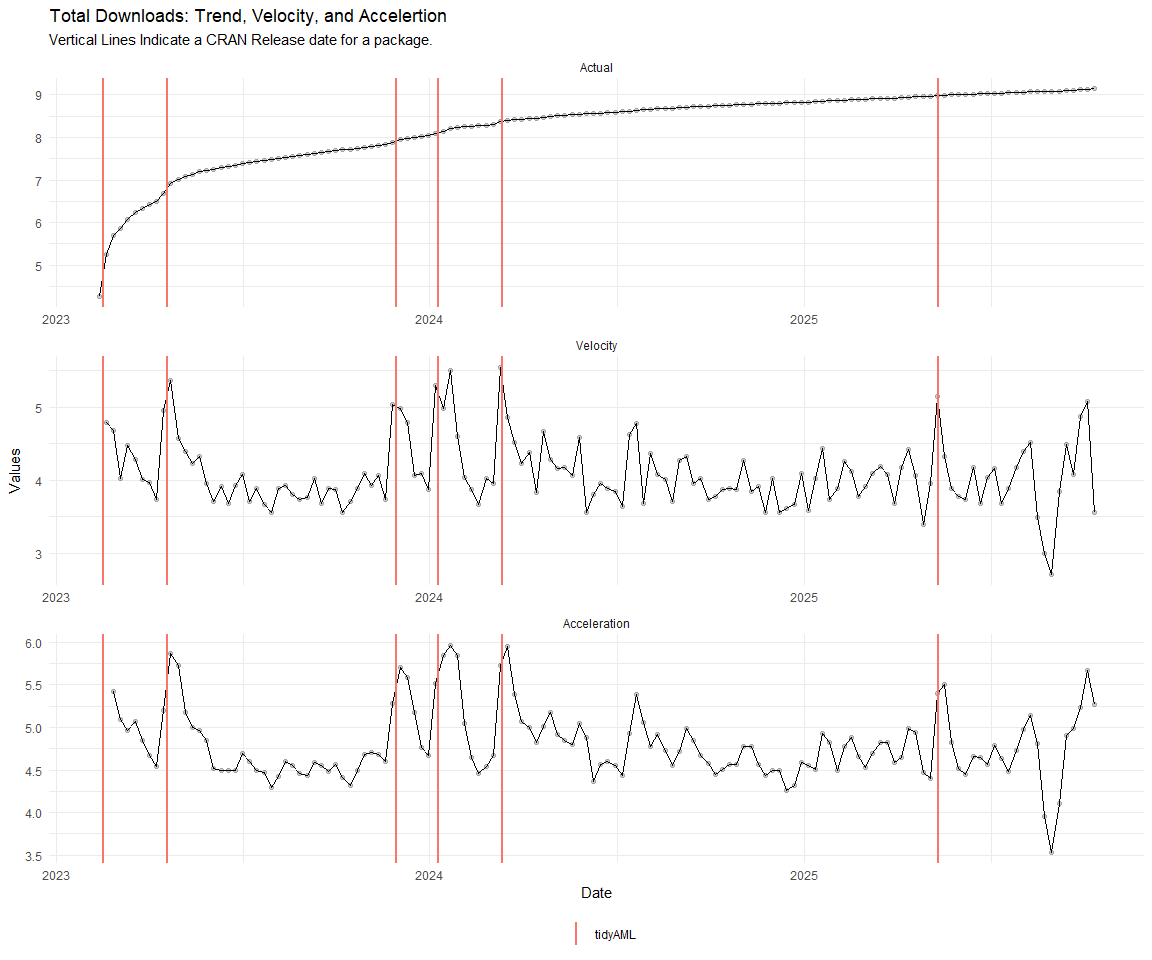
Now lets take a look at some time series decomposition graphs.
[[1]]
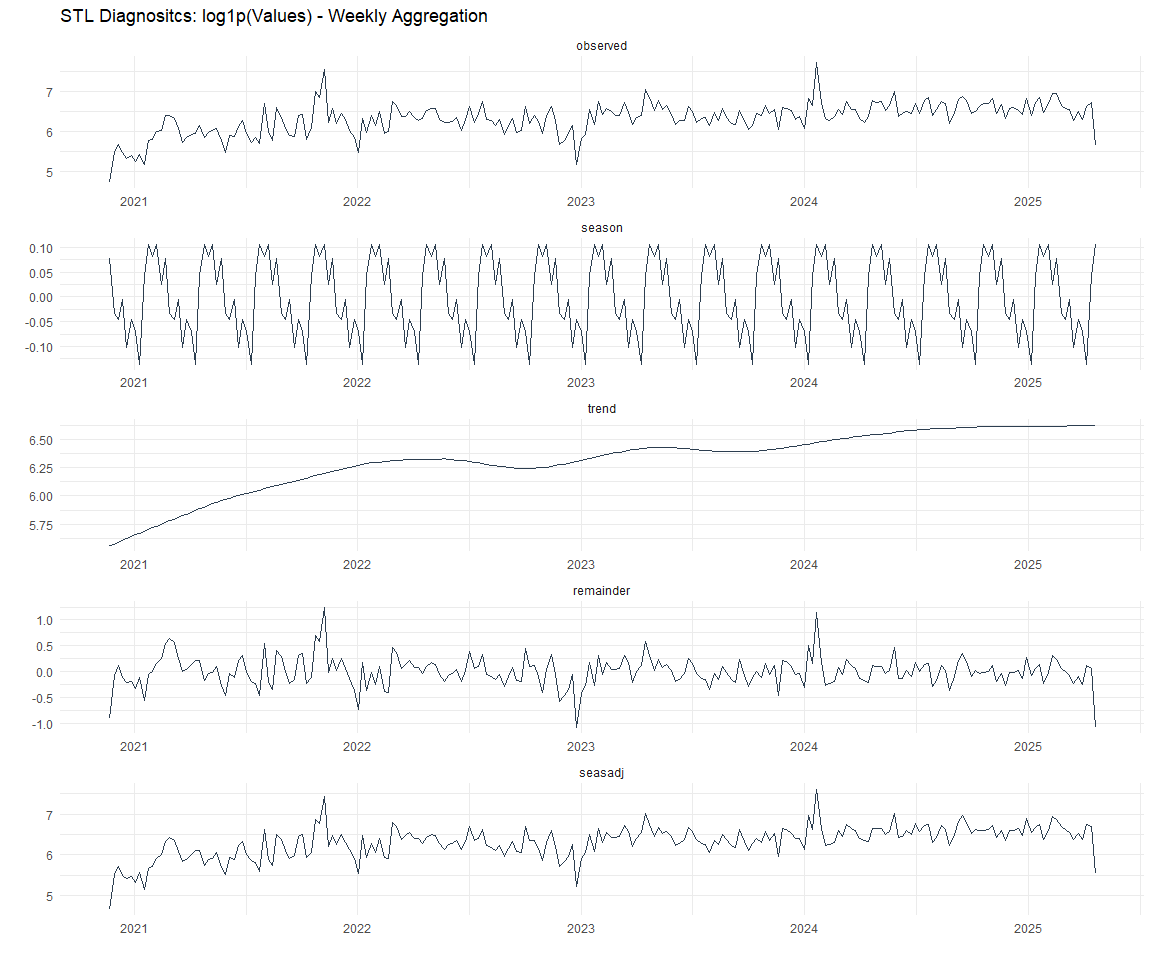
[[2]]
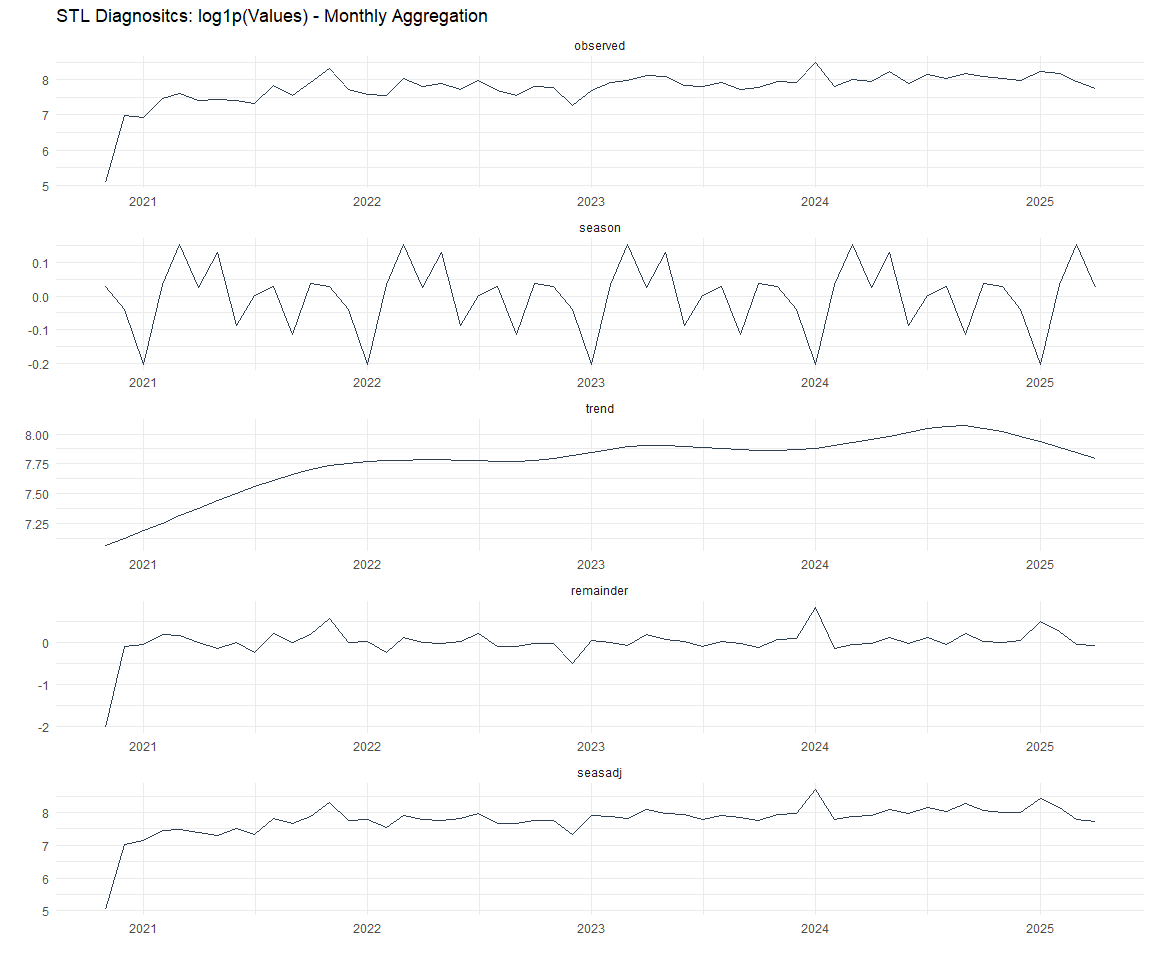
[[3]]
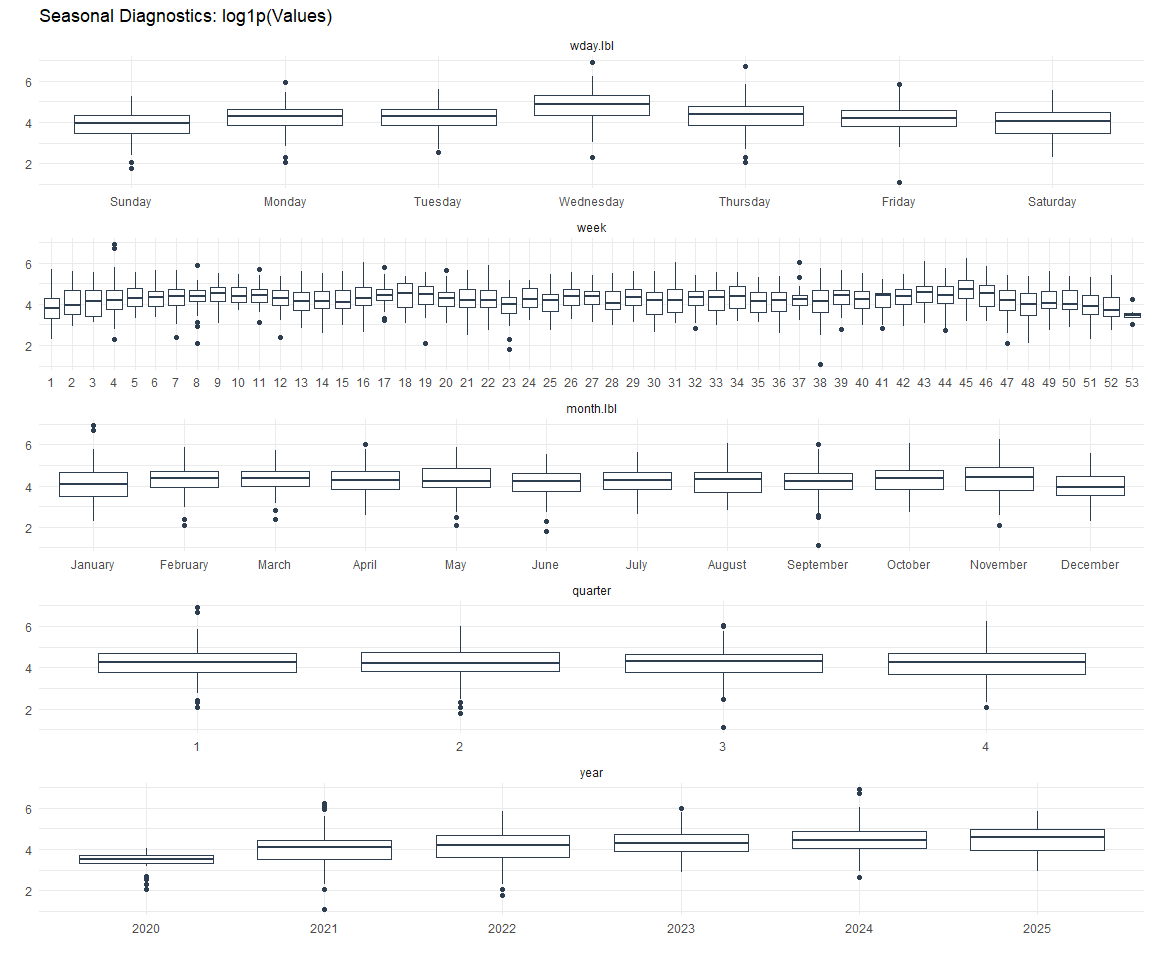
[[4]]
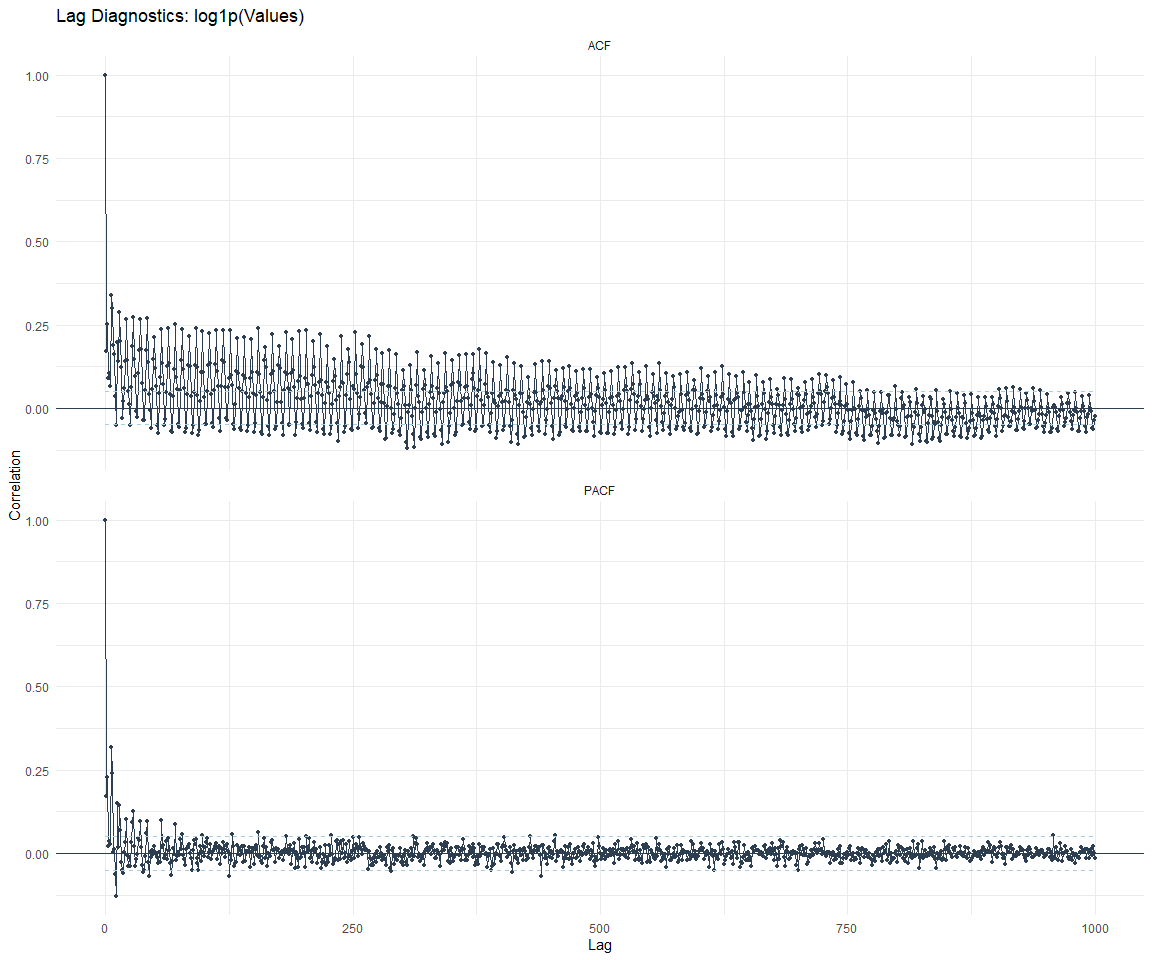
[[5]]
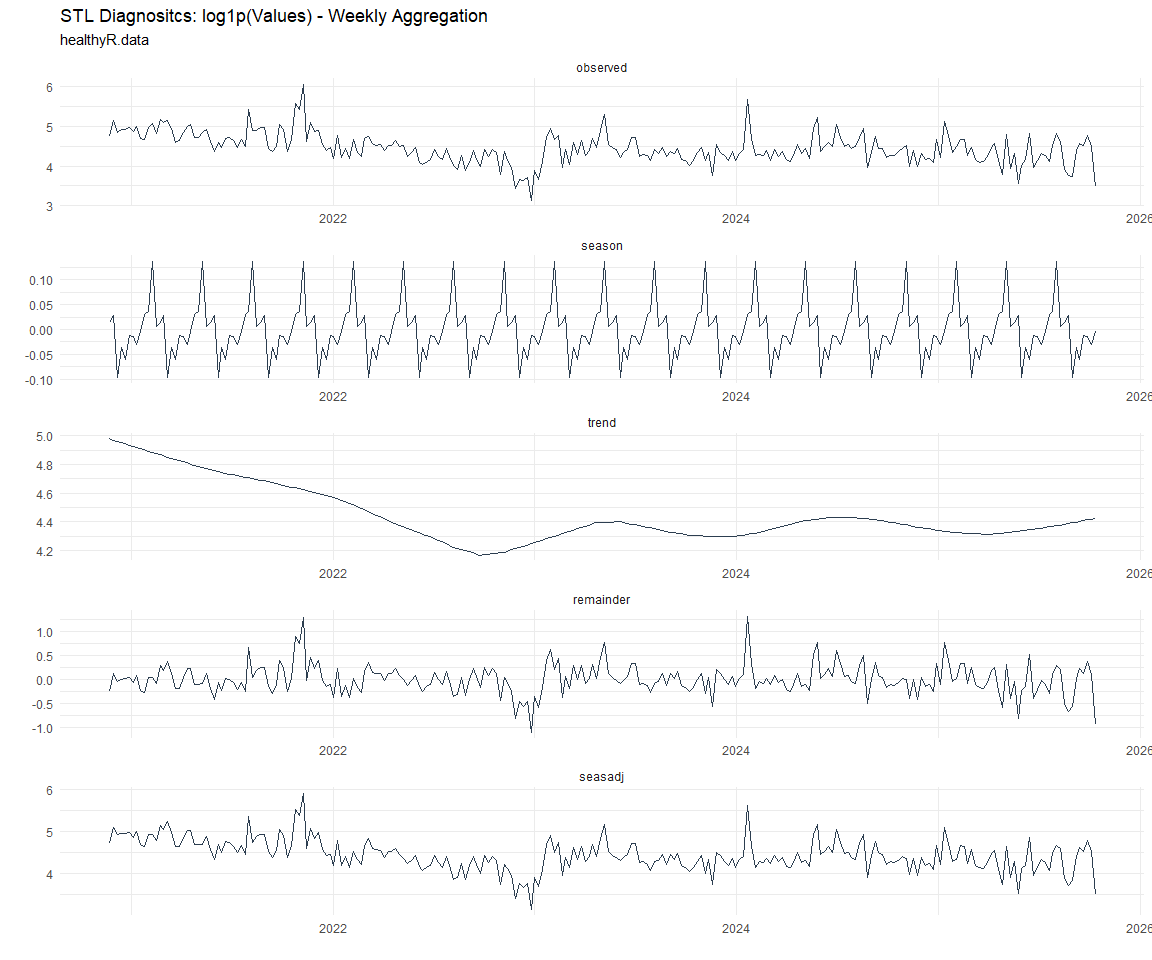
[[6]]
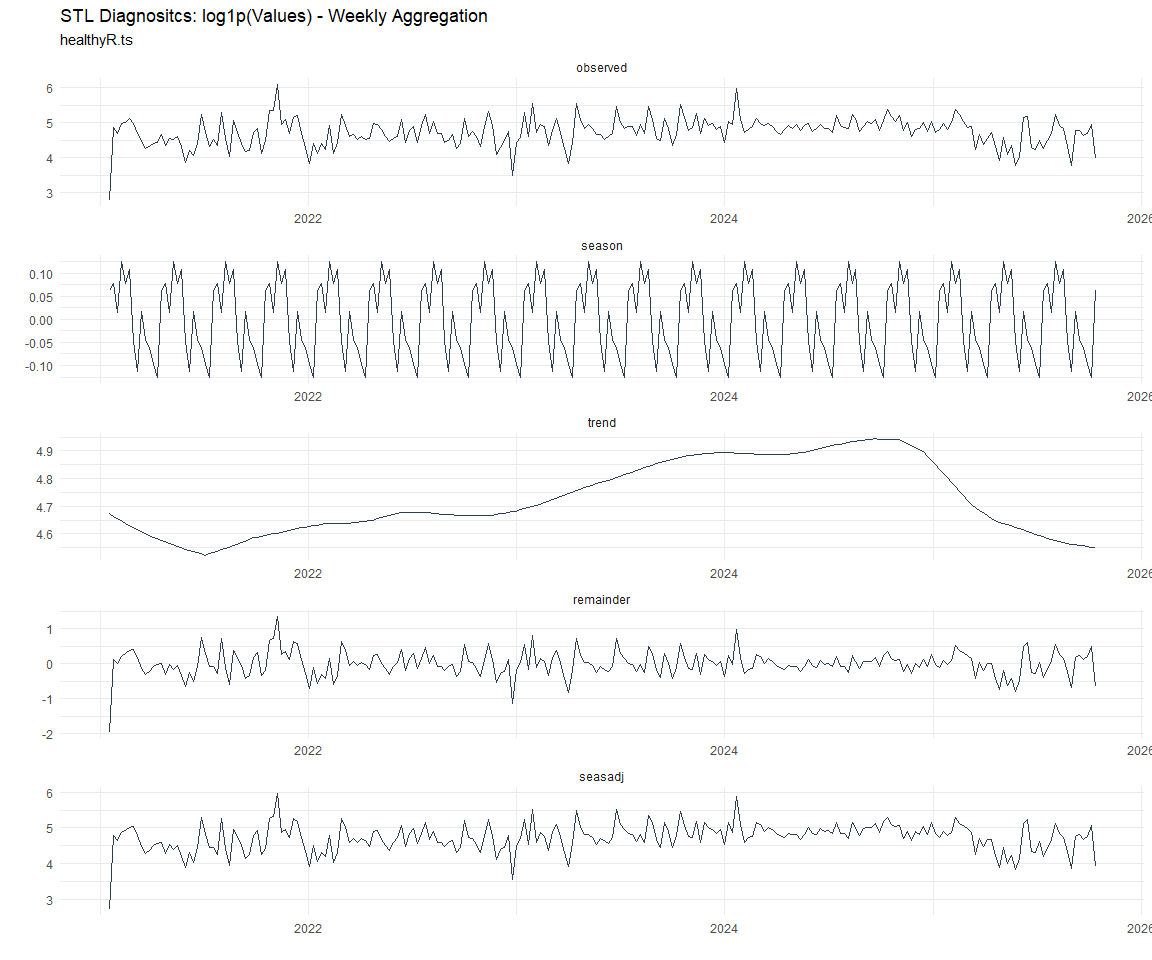
[[7]]
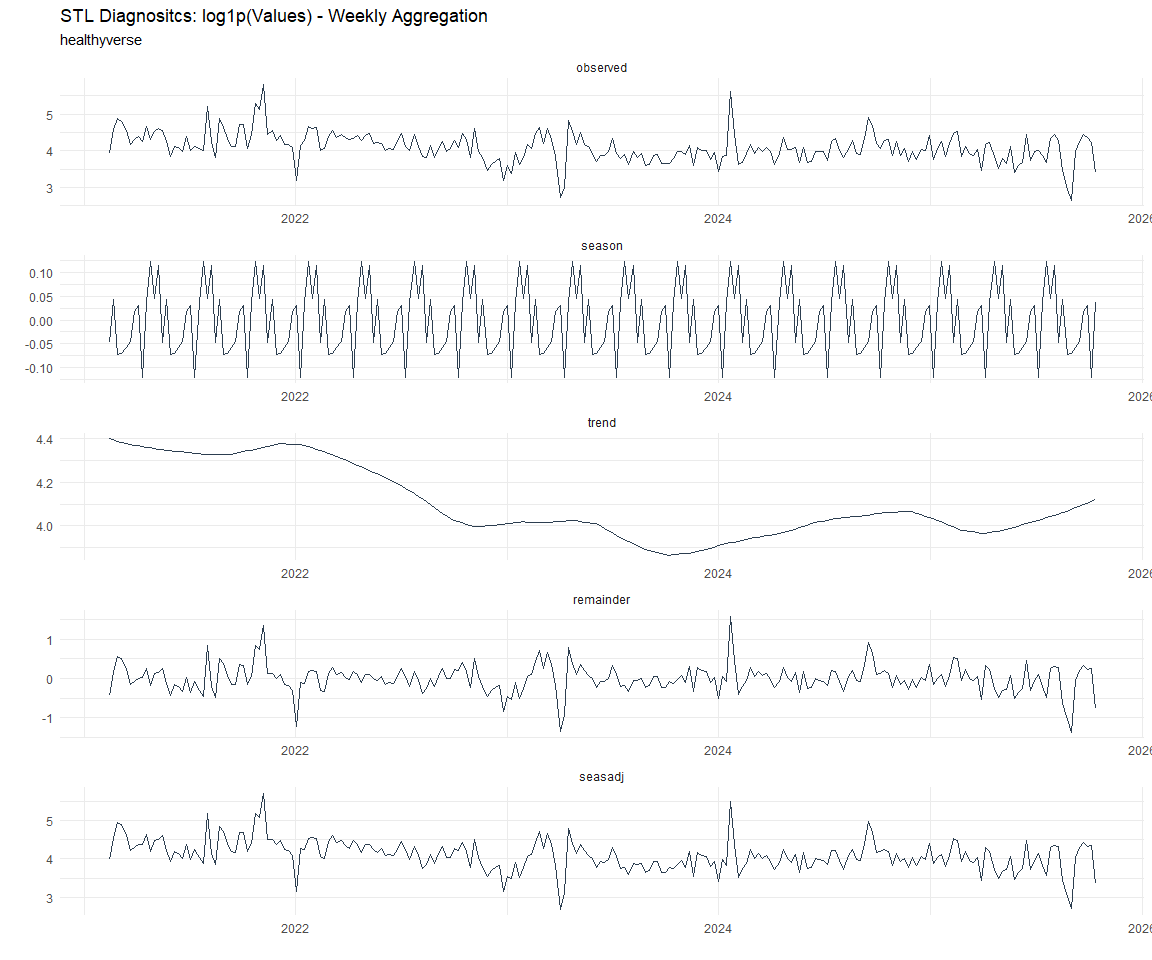
[[8]]
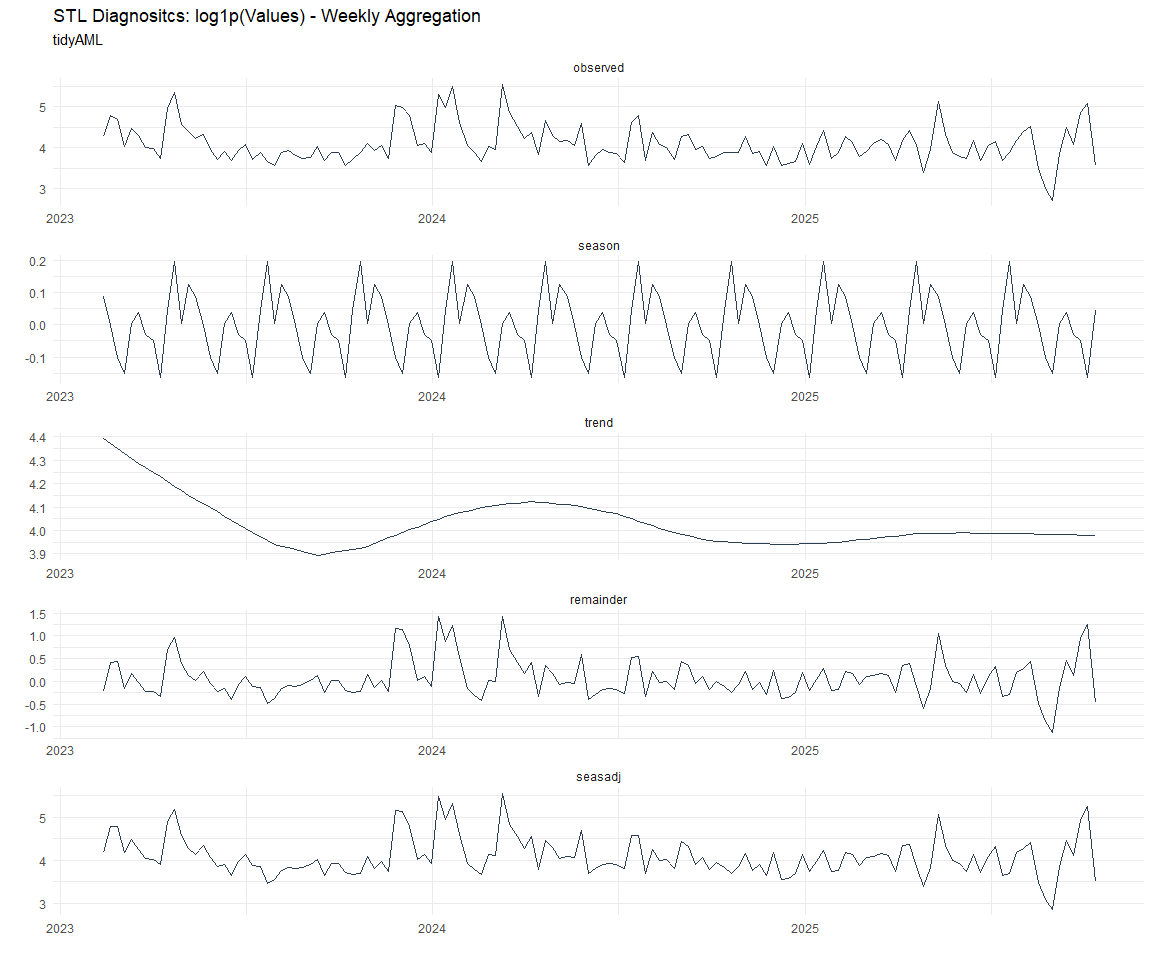
[[1]]
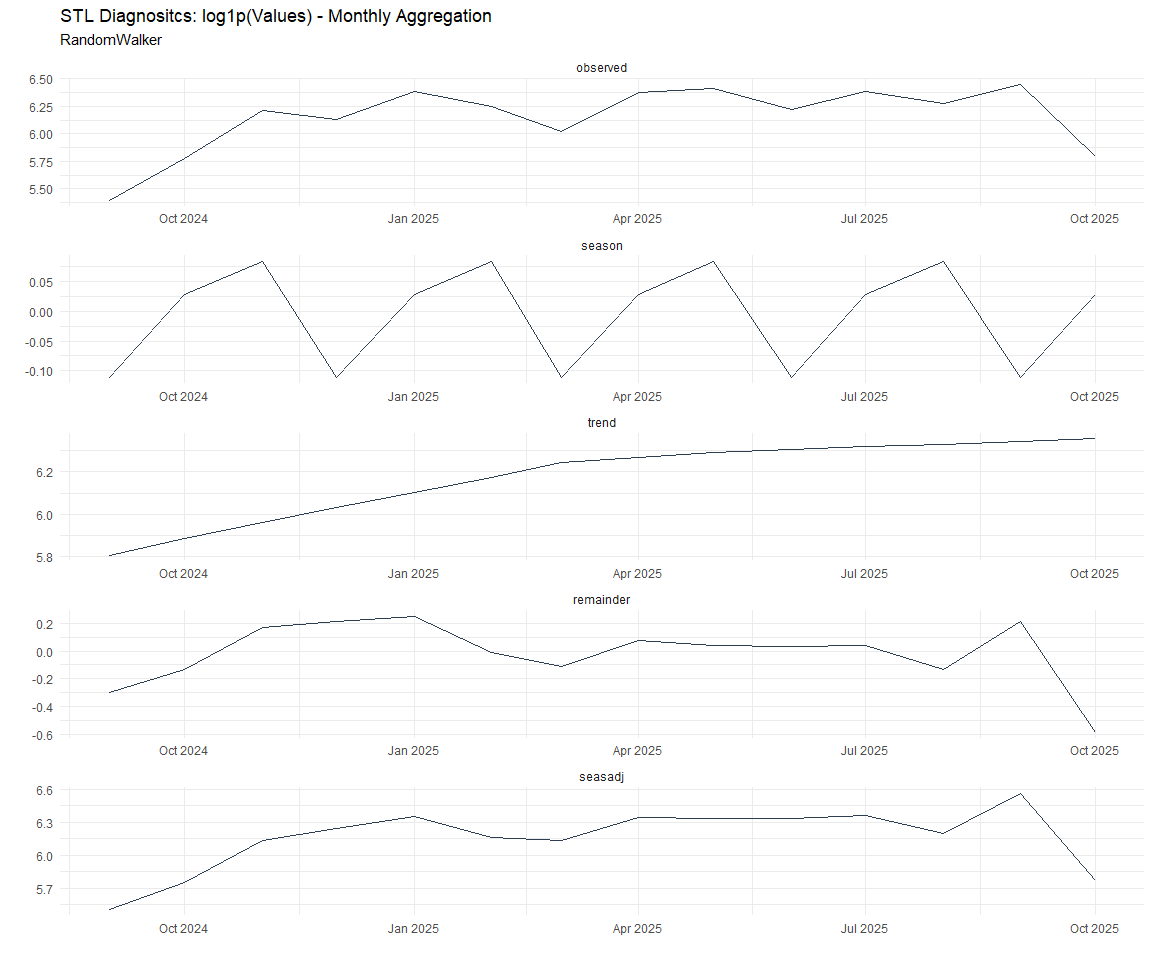
[[2]]
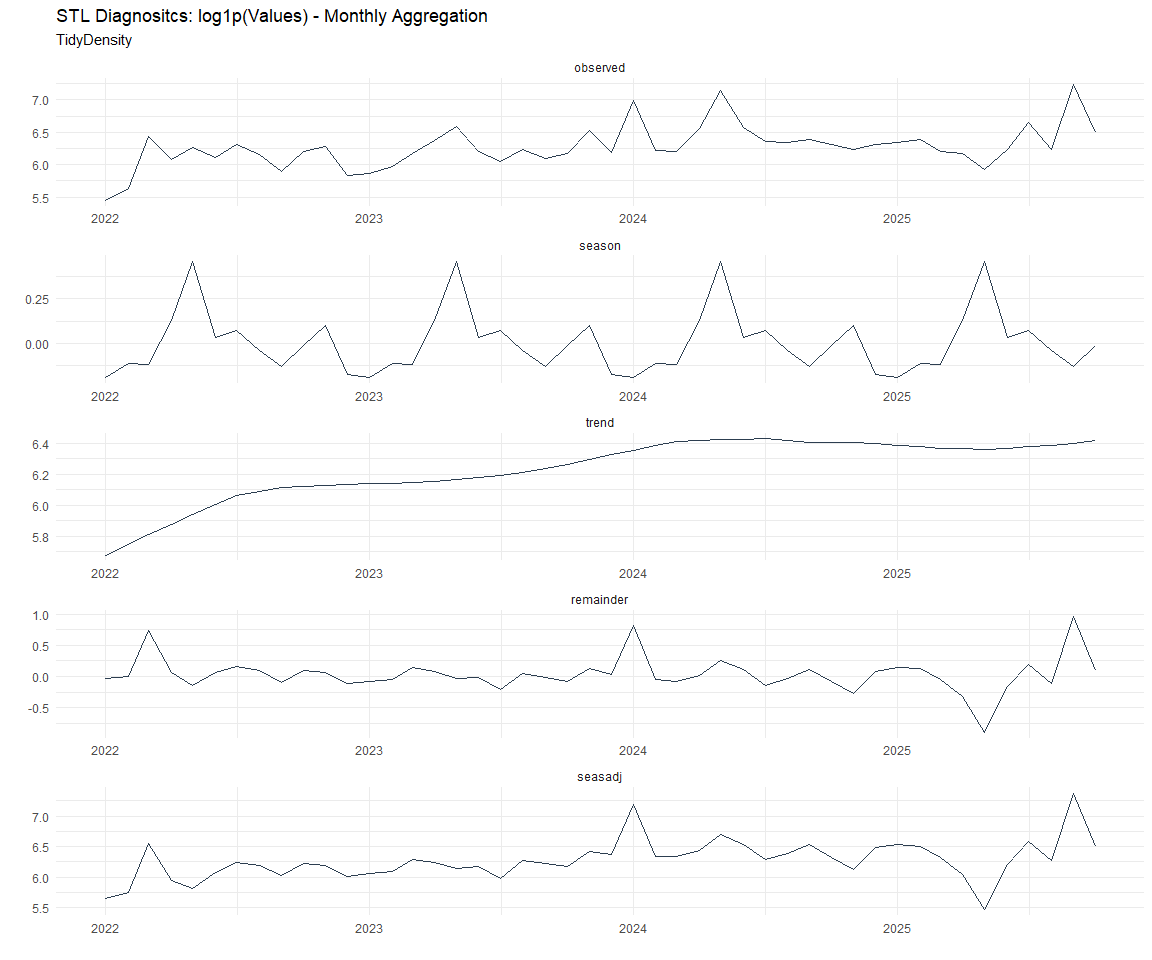
[[3]]
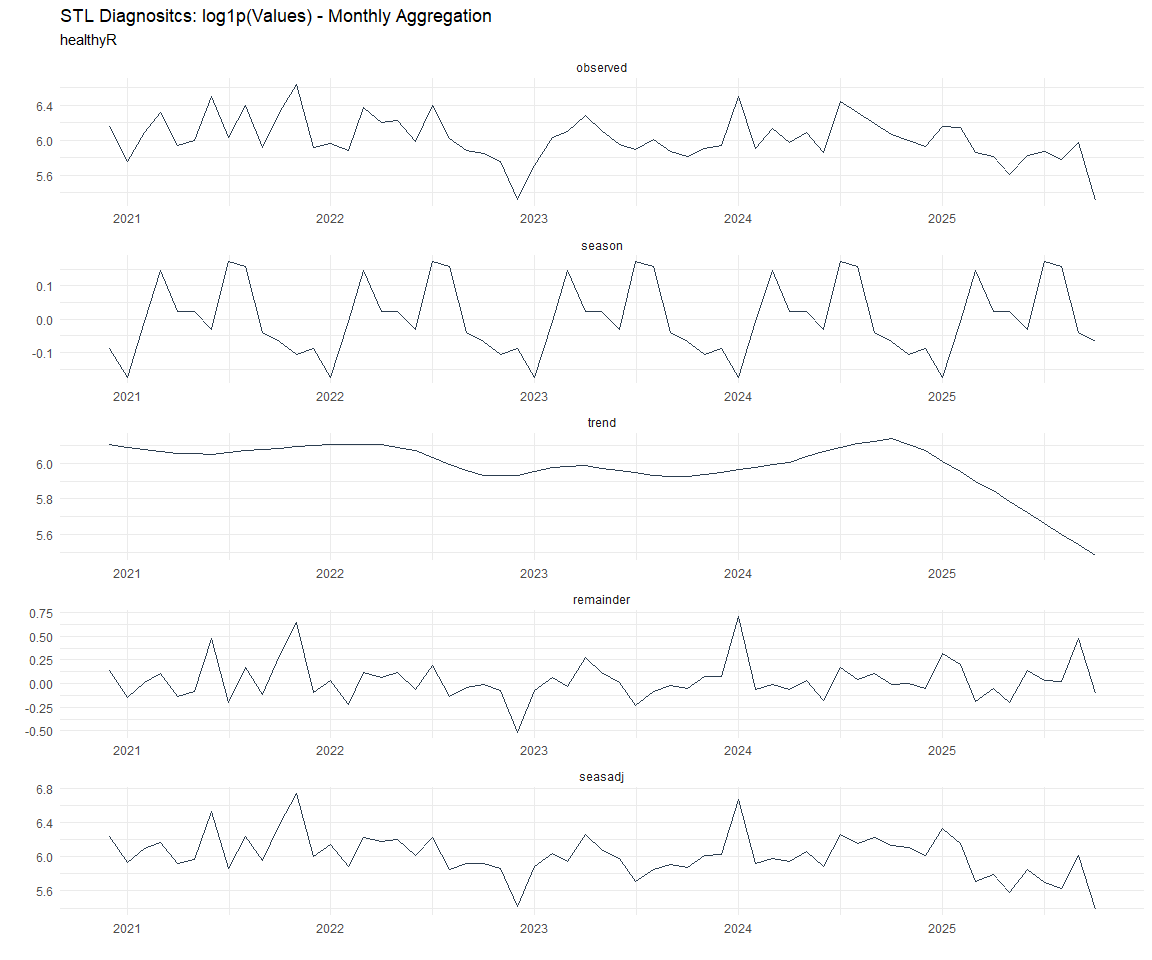
[[4]]
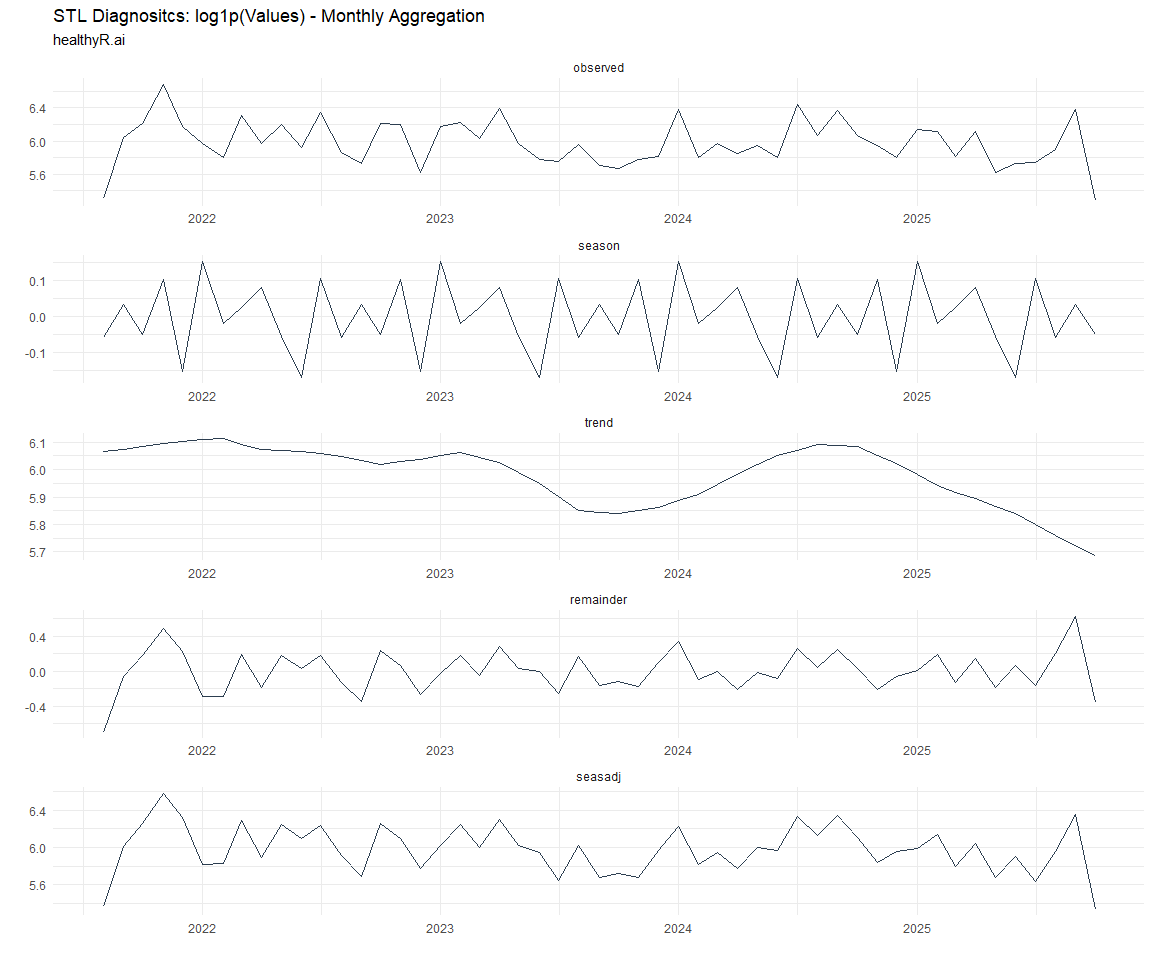
[[5]]
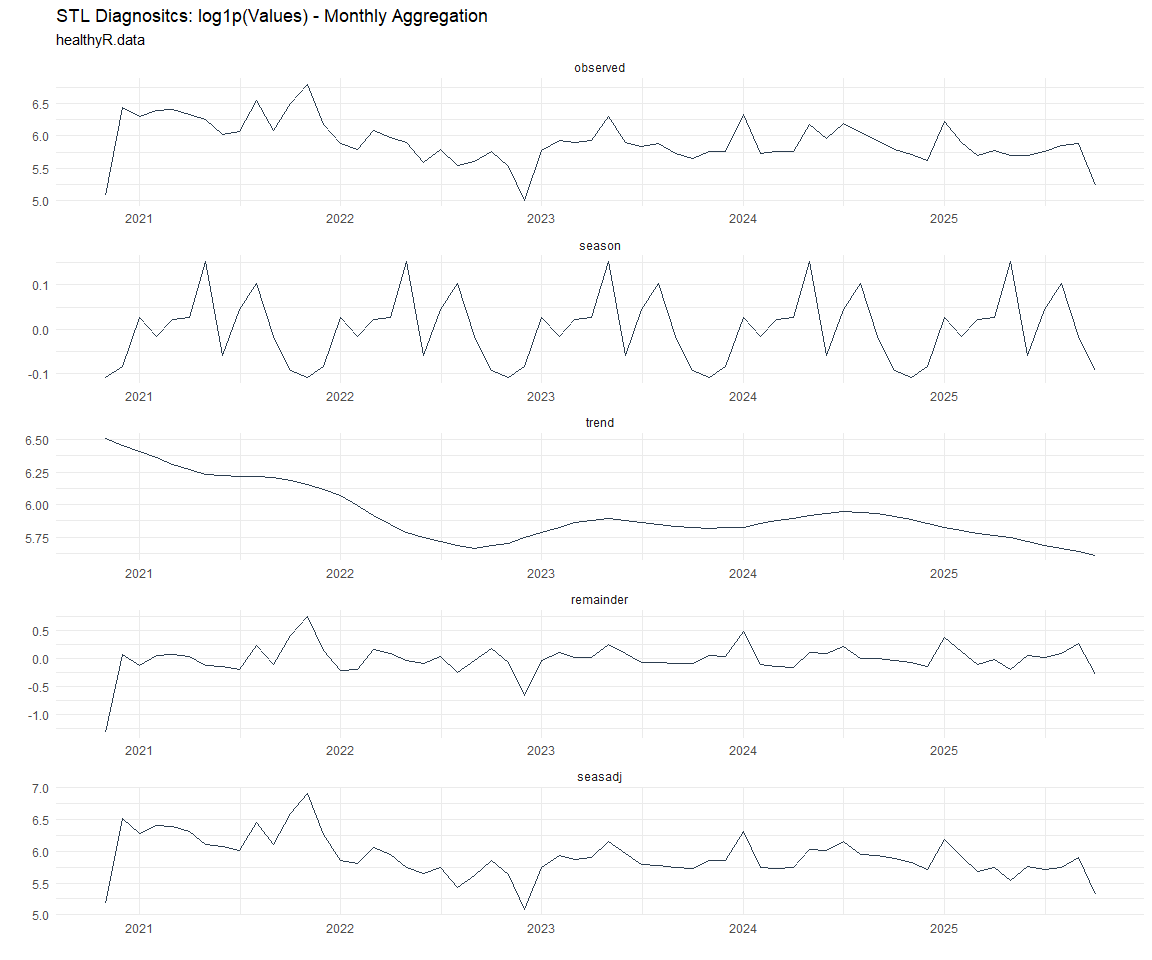
[[6]]
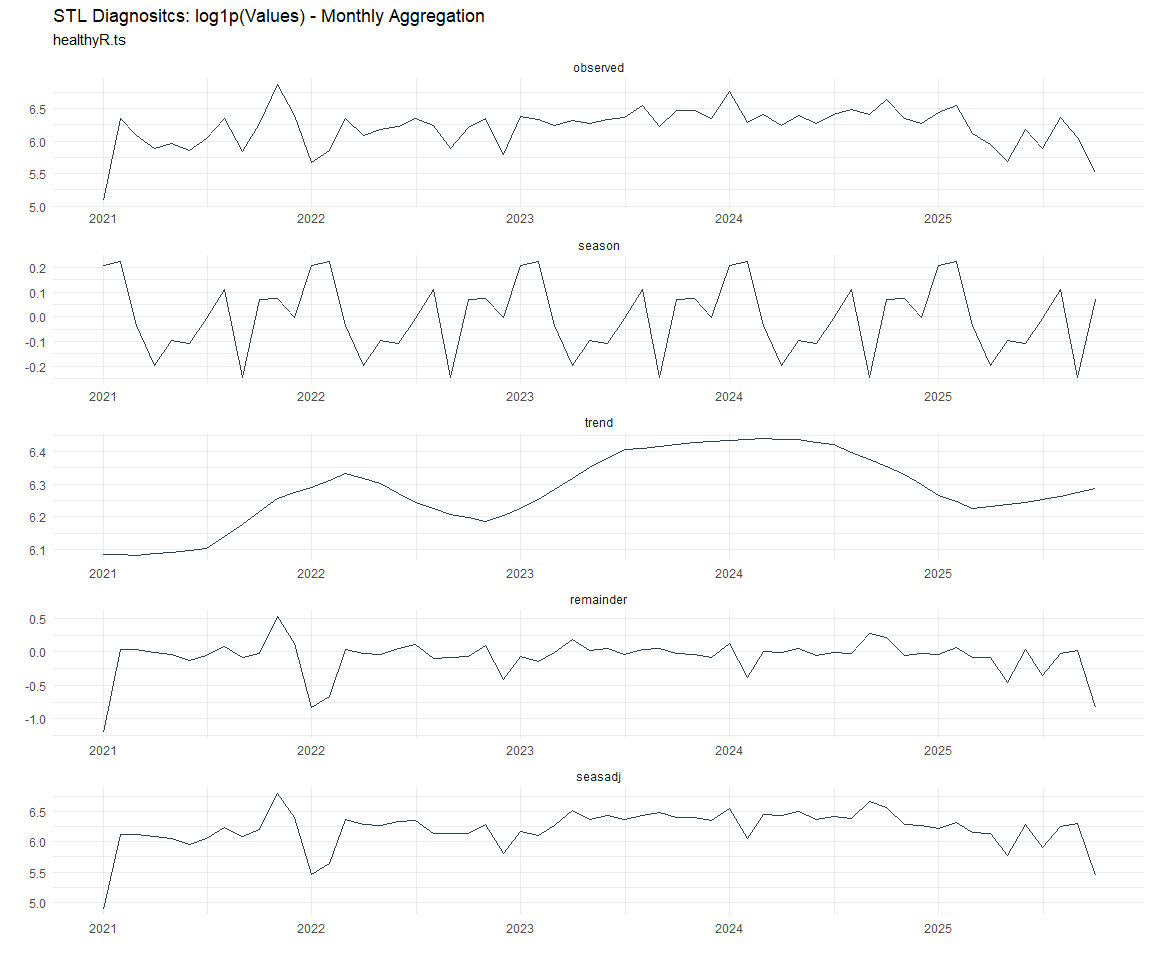
[[7]]
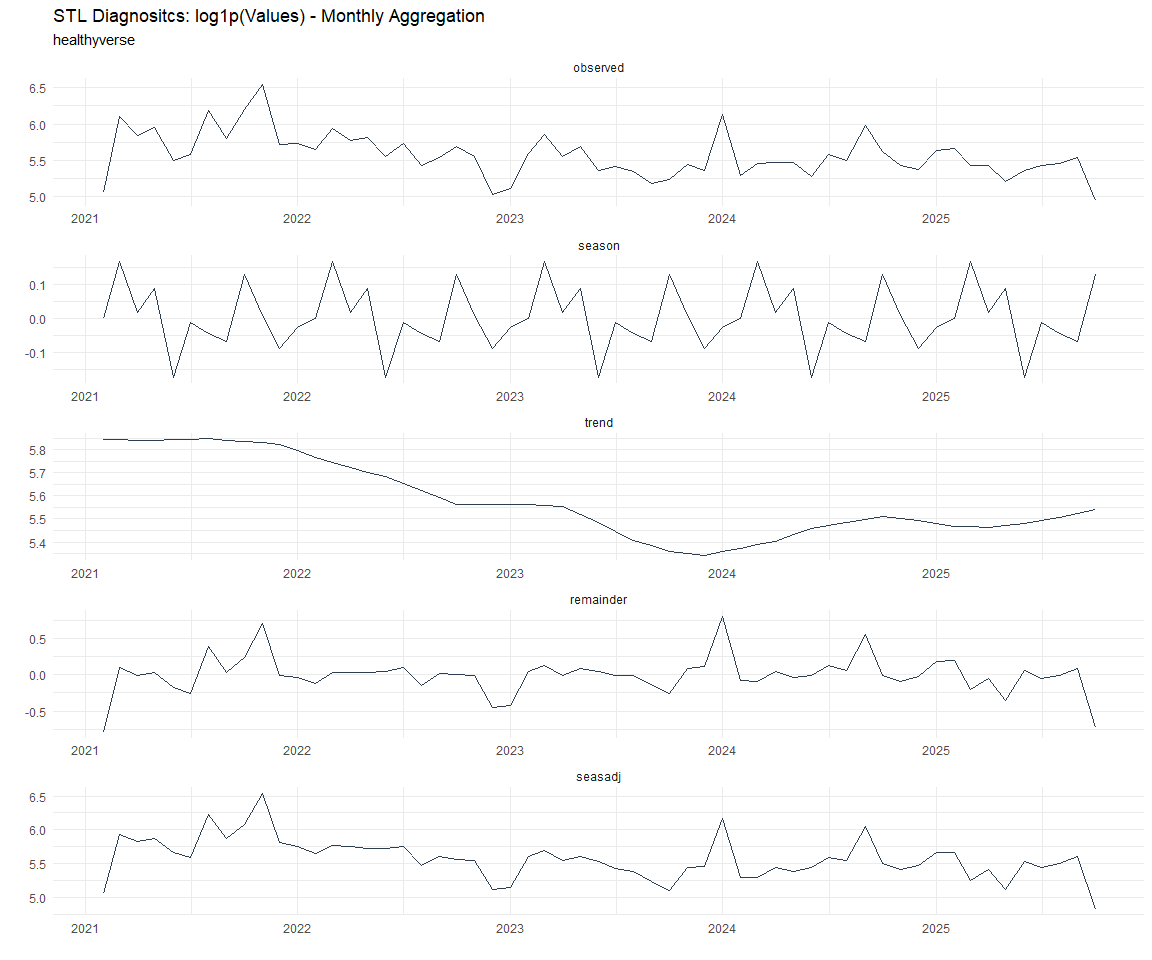
[[8]]
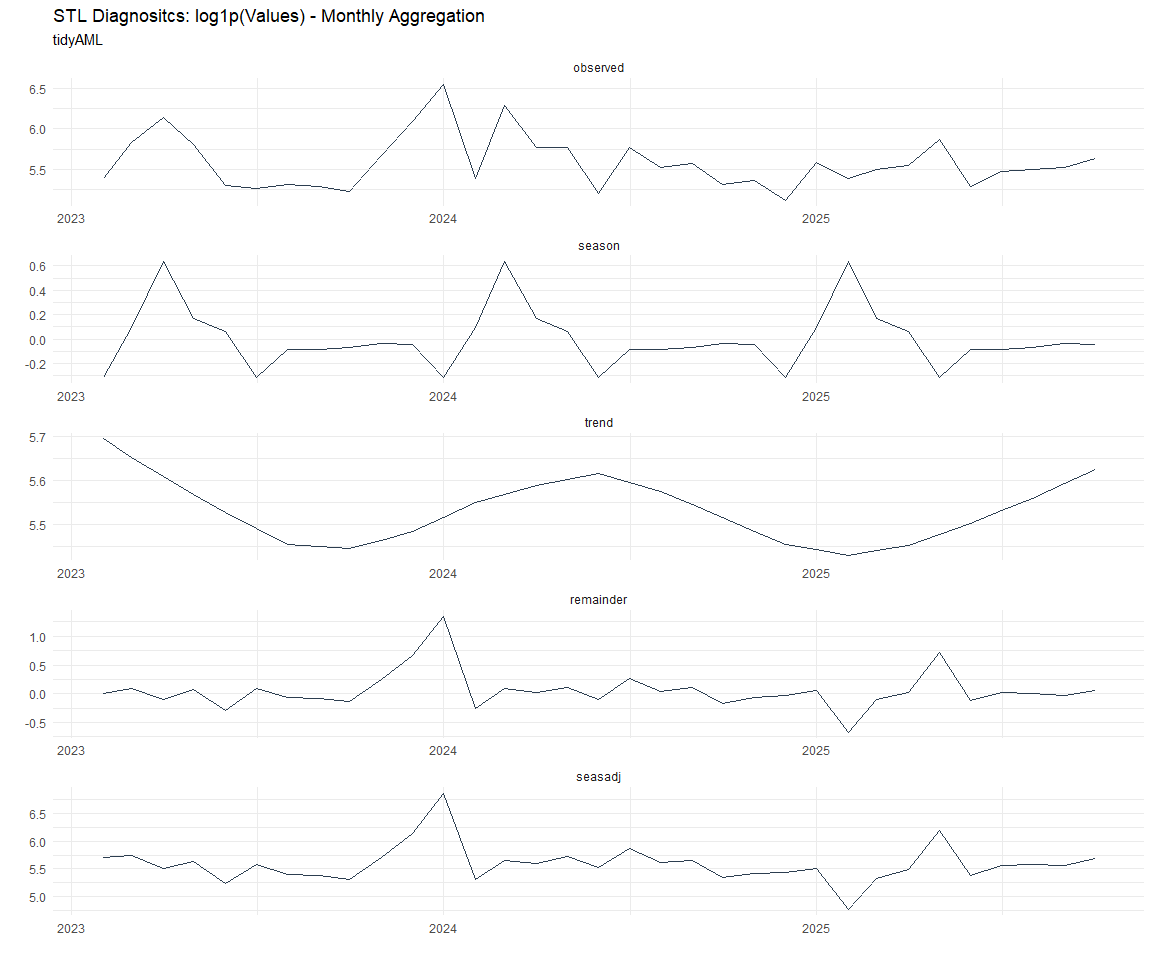
Seasonal Diagnostics:
[[1]]
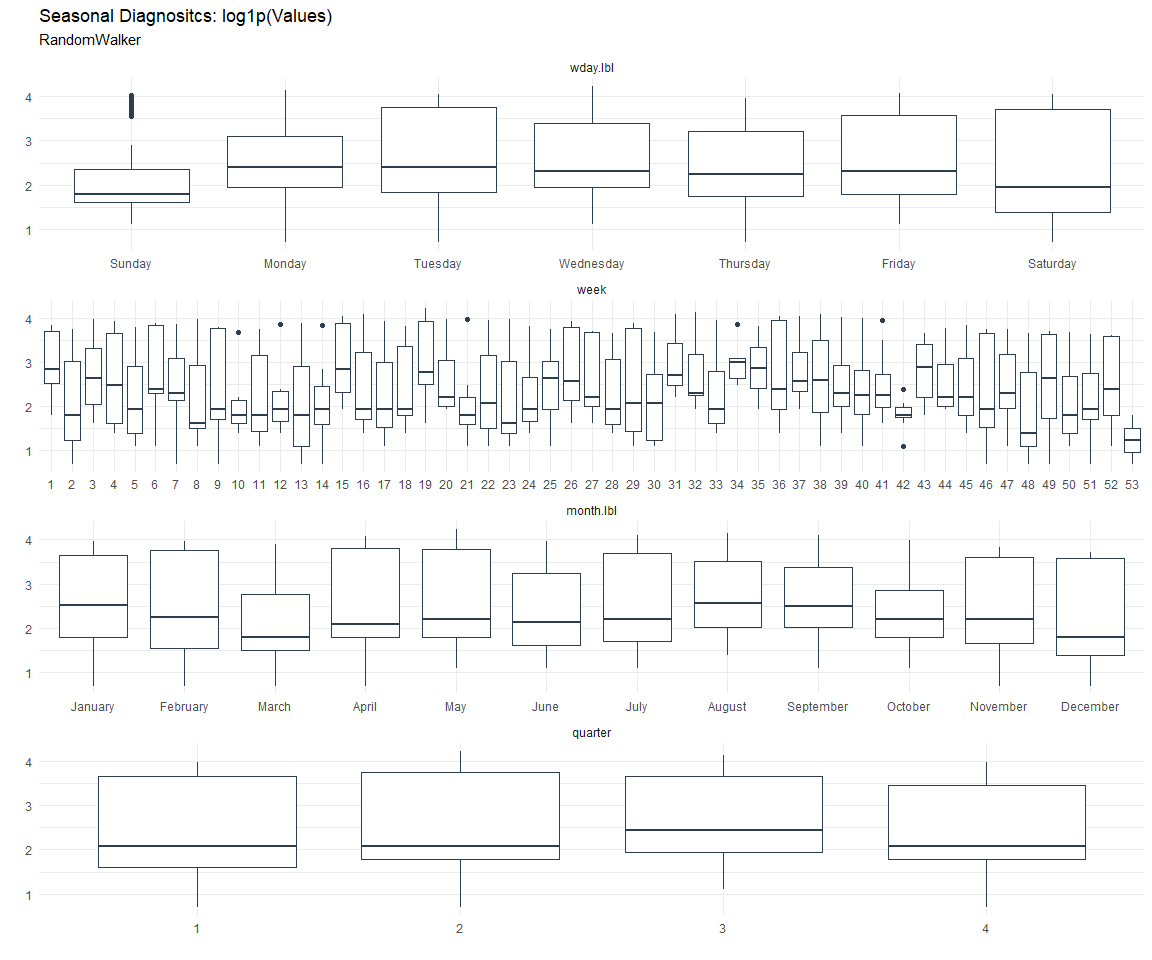
[[2]]
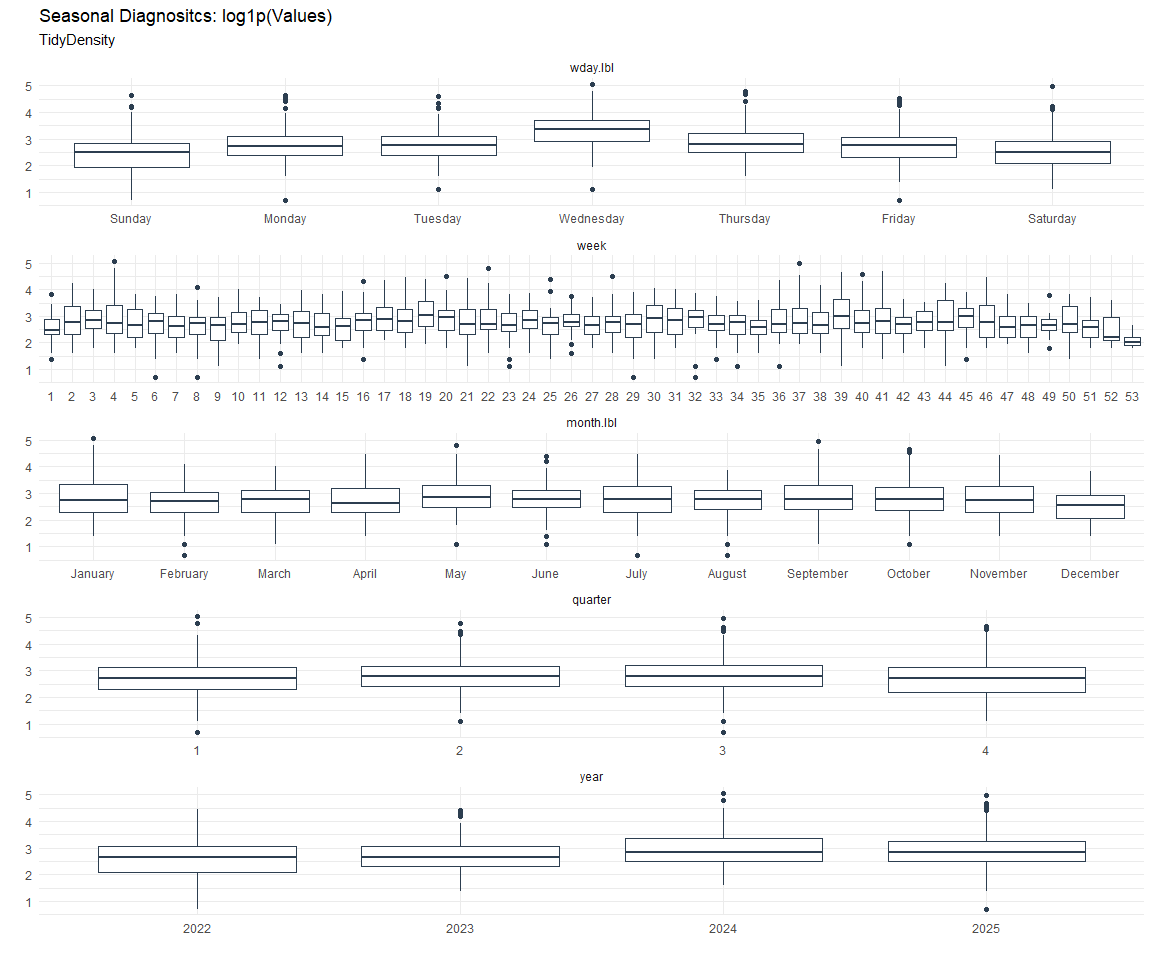
[[3]]
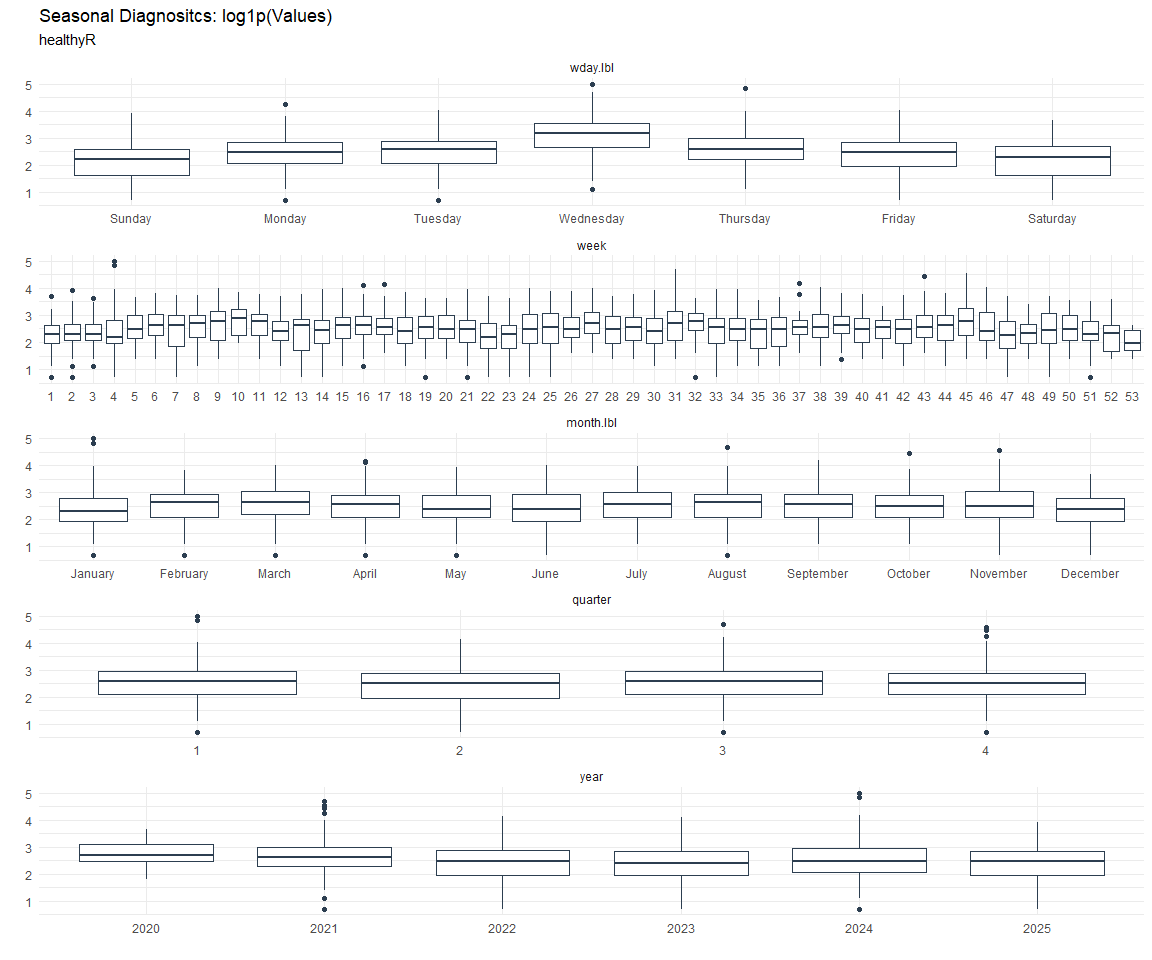
[[4]]
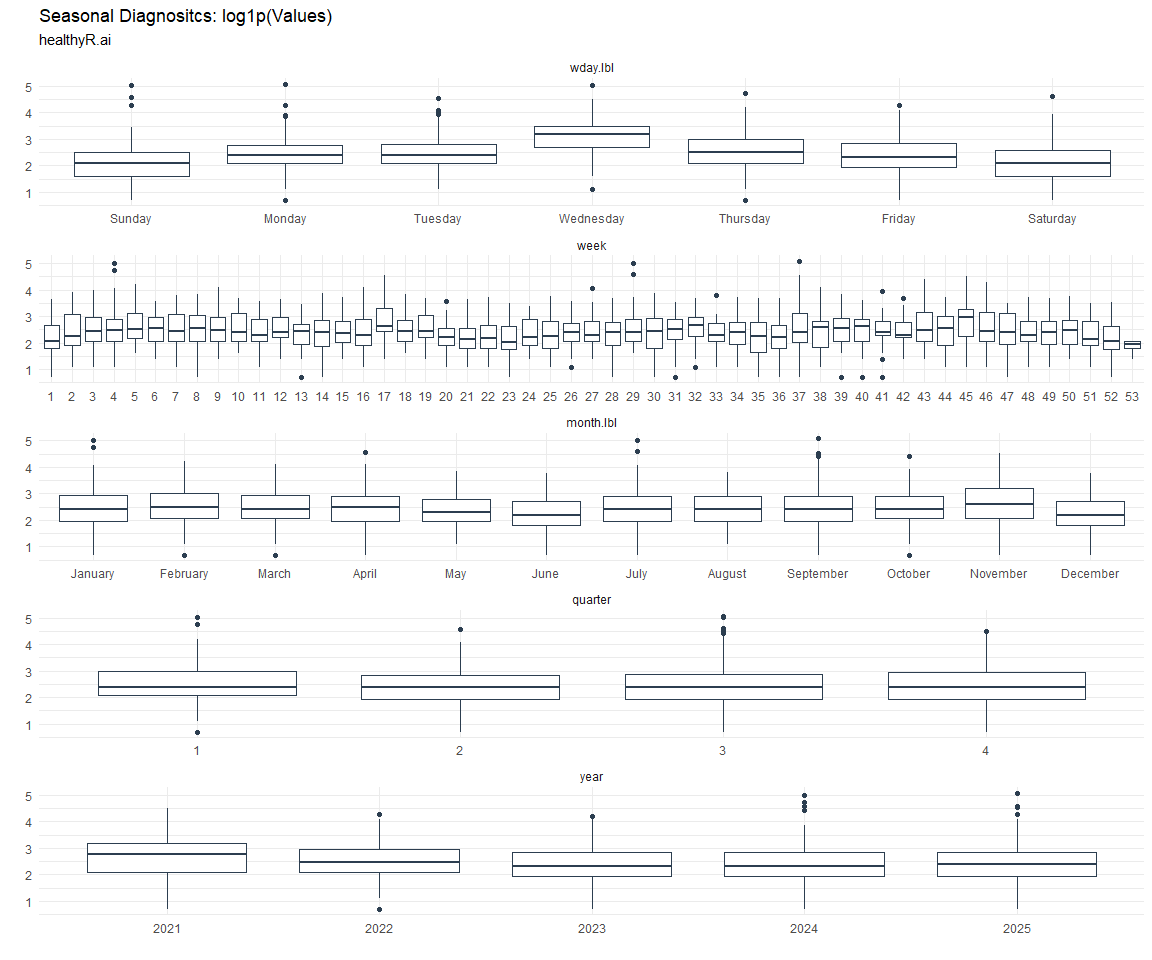
[[5]]
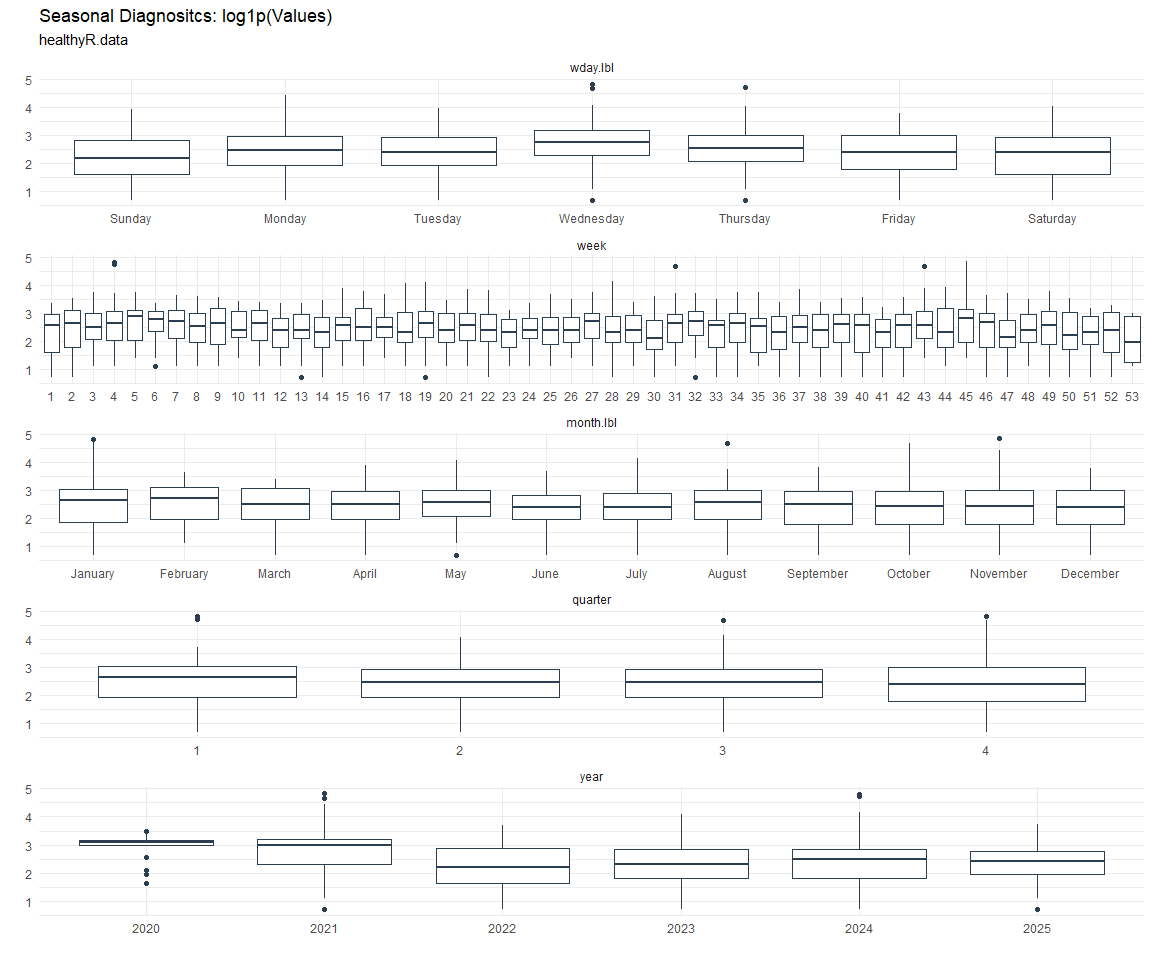
[[6]]
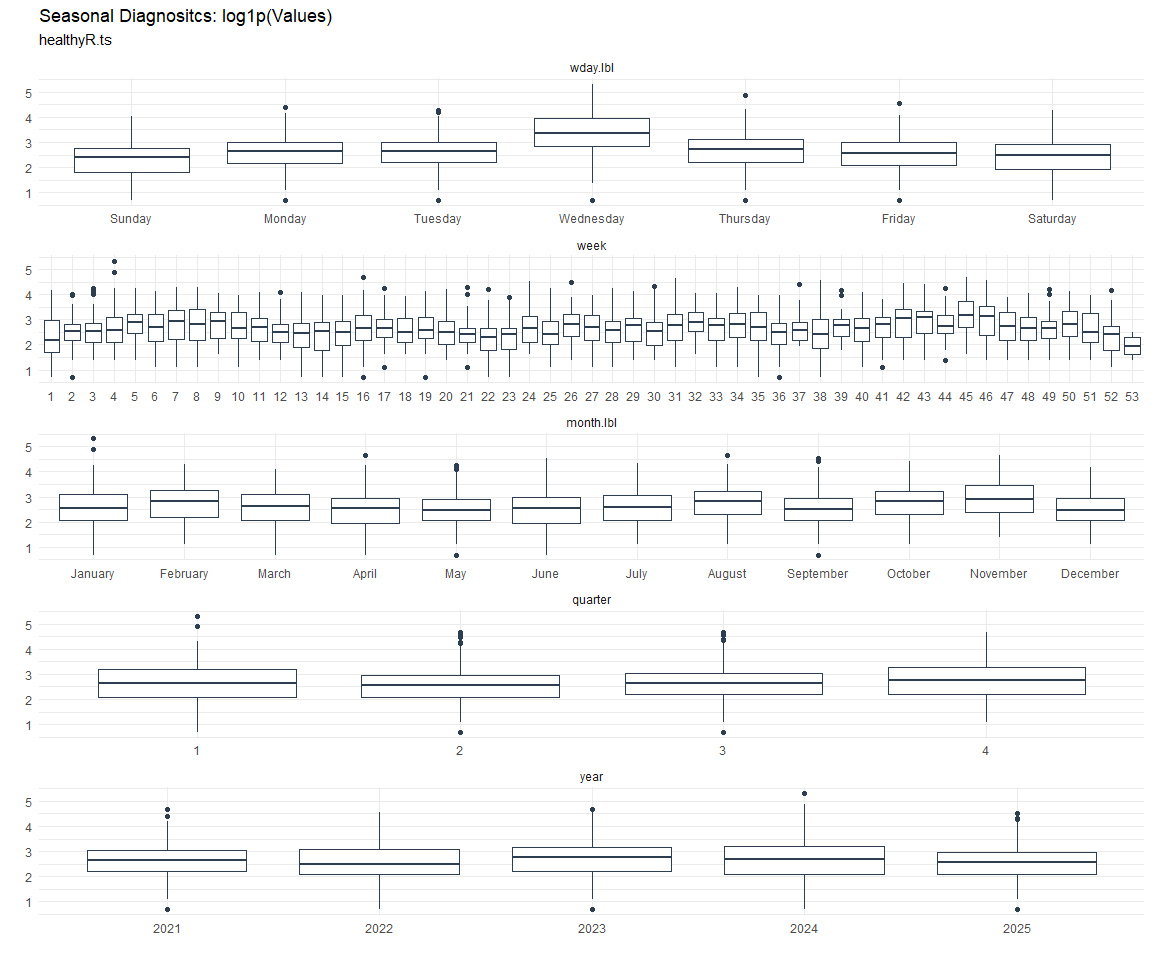
[[7]]
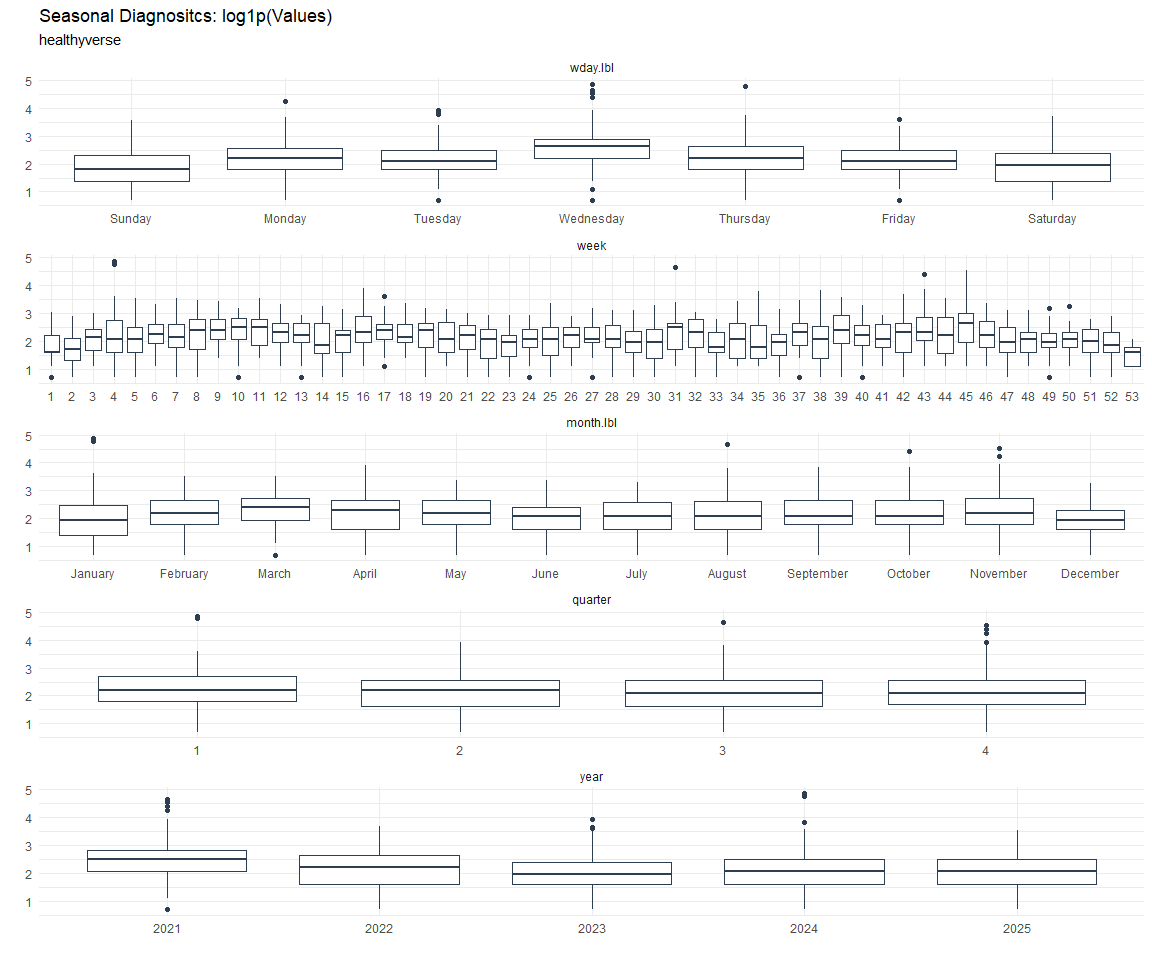
[[8]]
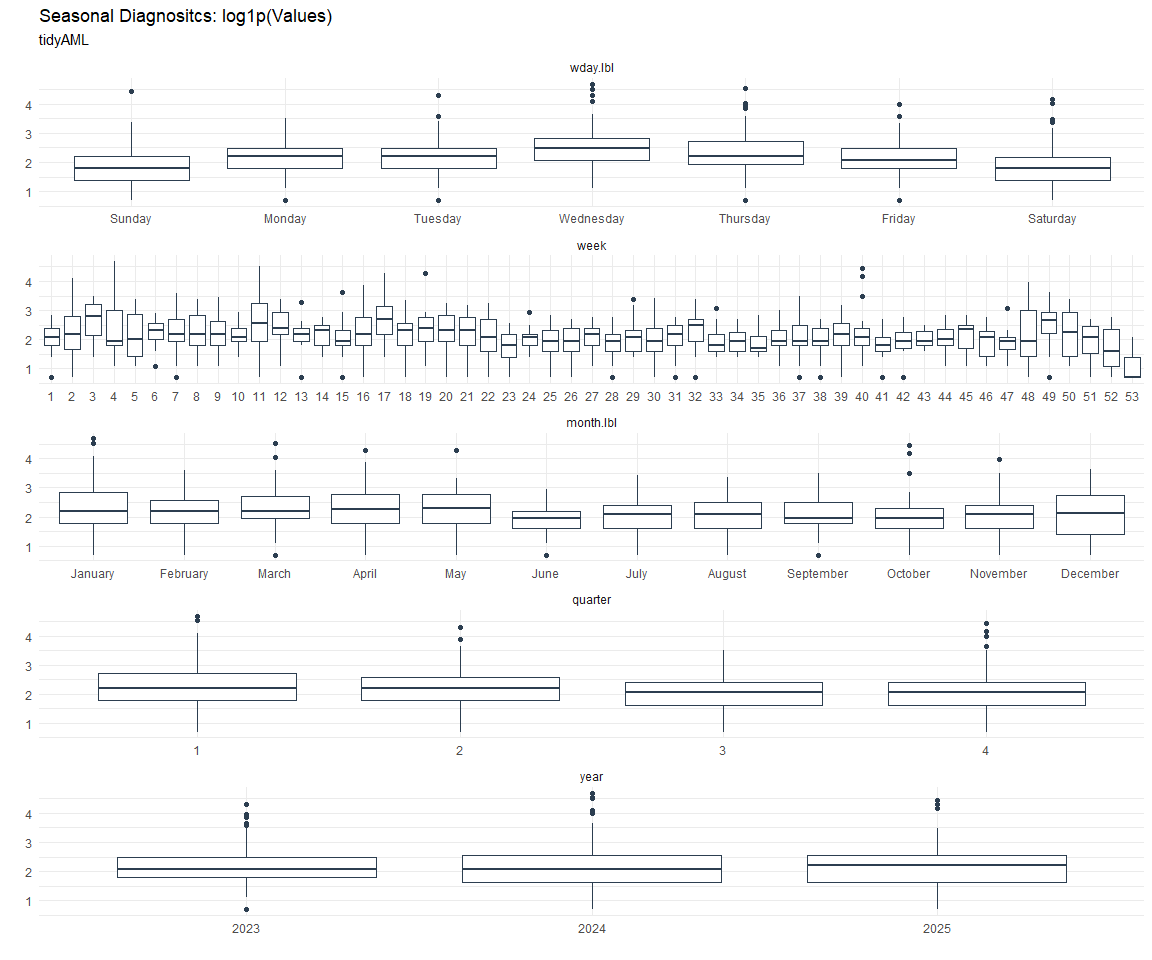
ACF and PACF Diagnostics:
[[1]]
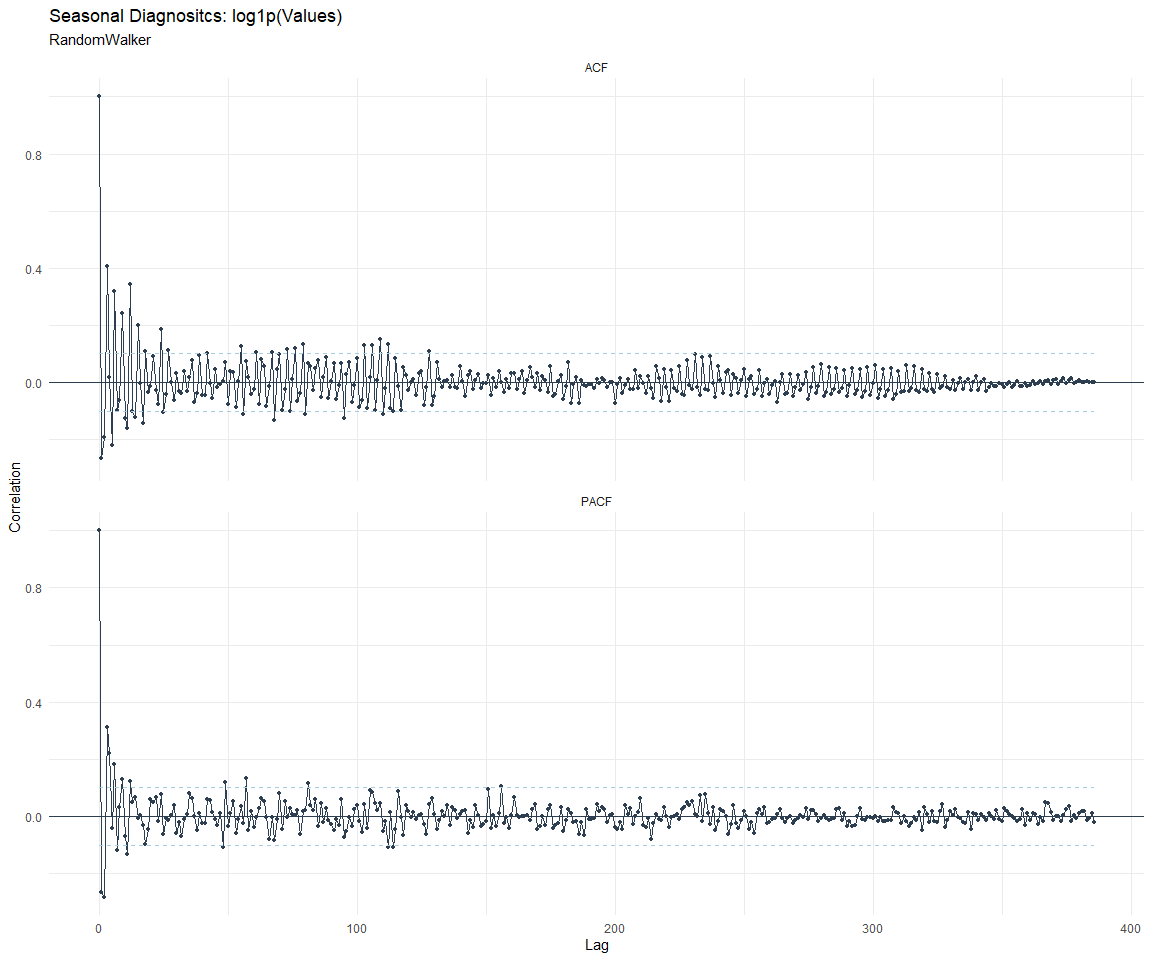
[[2]]
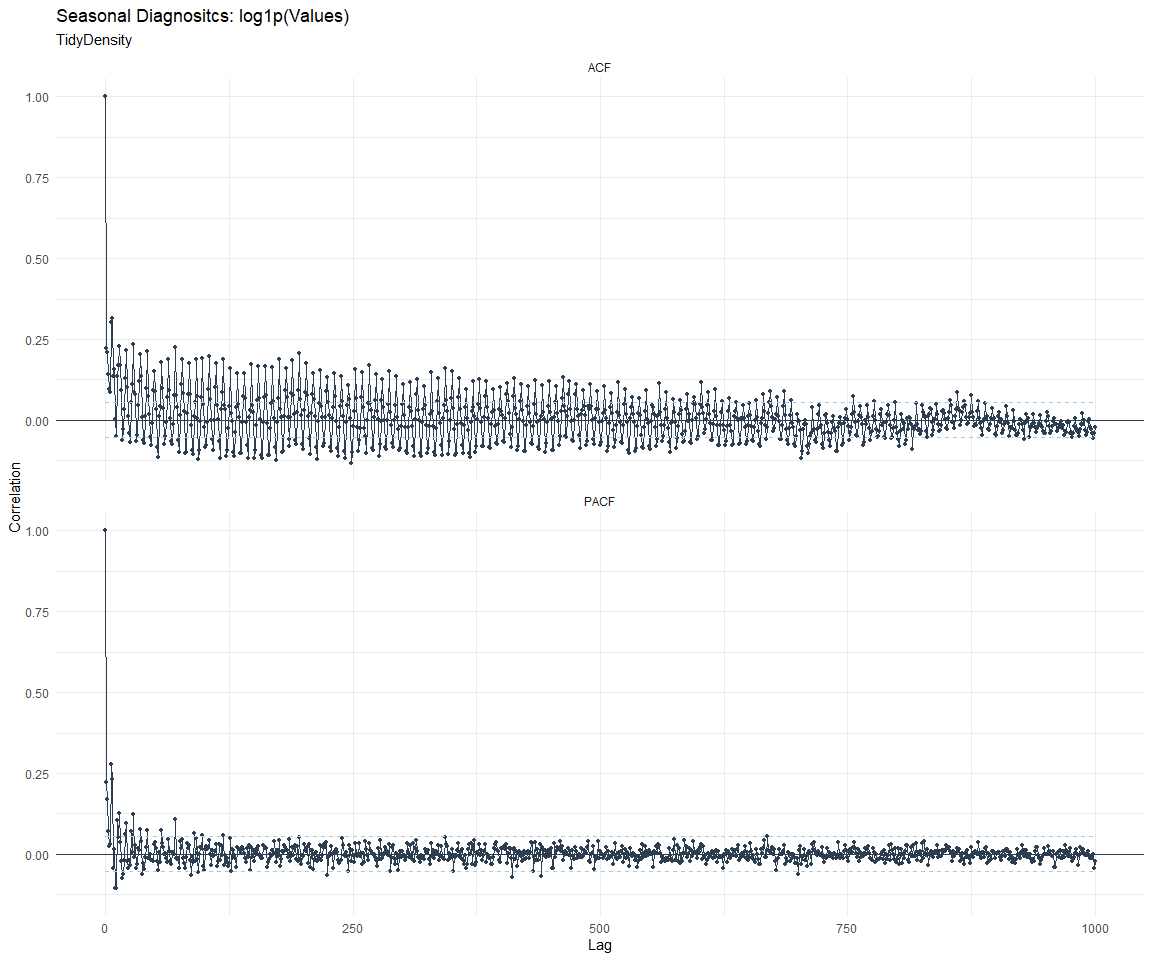
[[3]]
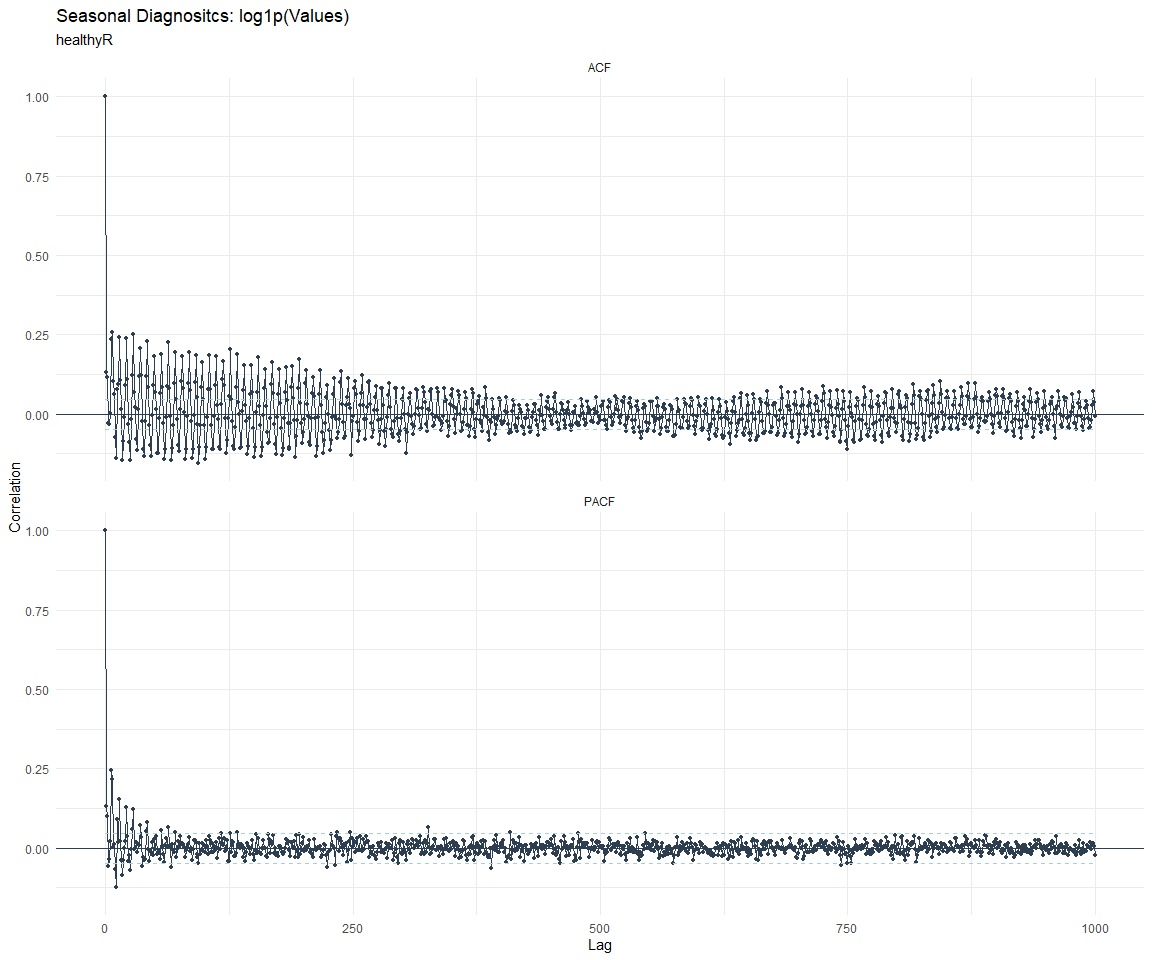
[[4]]
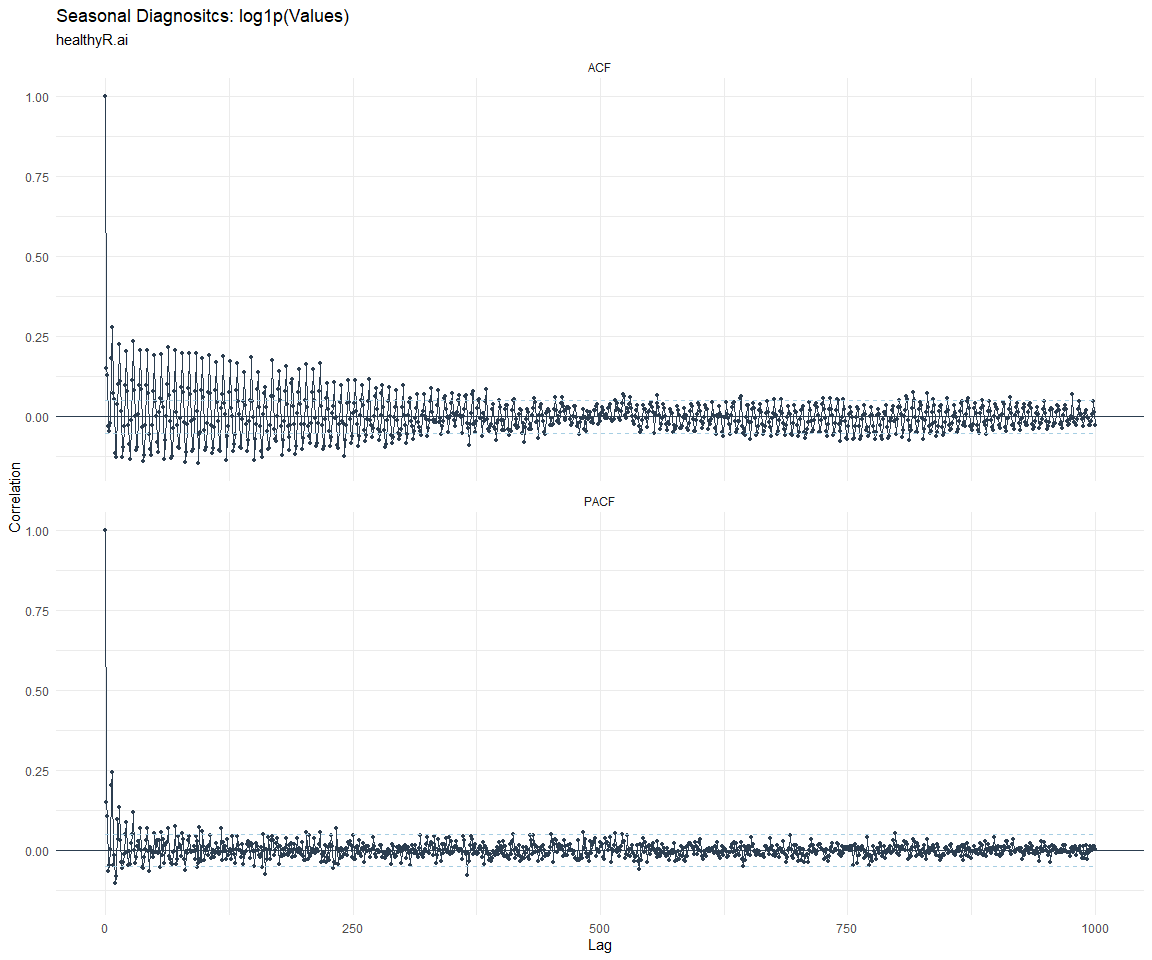
[[5]]
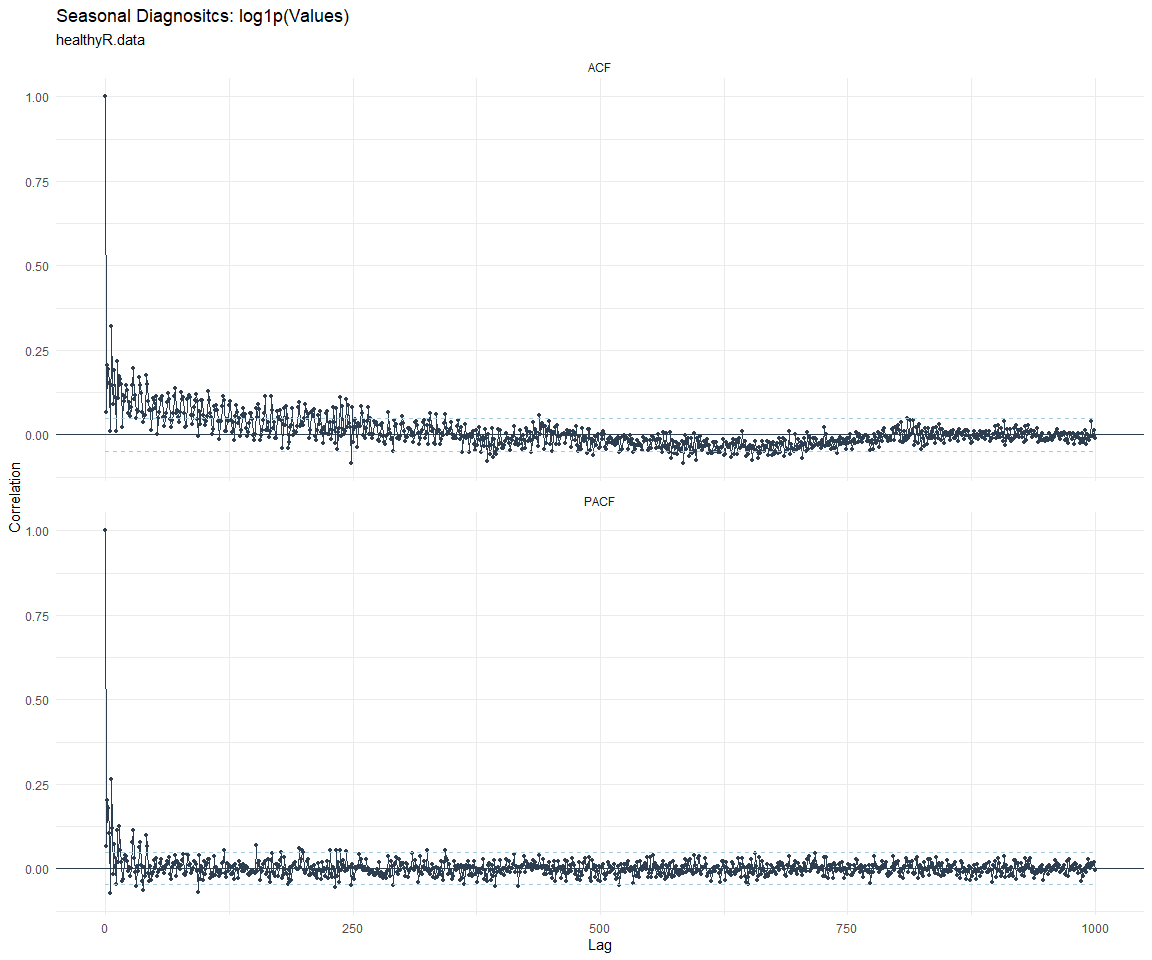
[[6]]
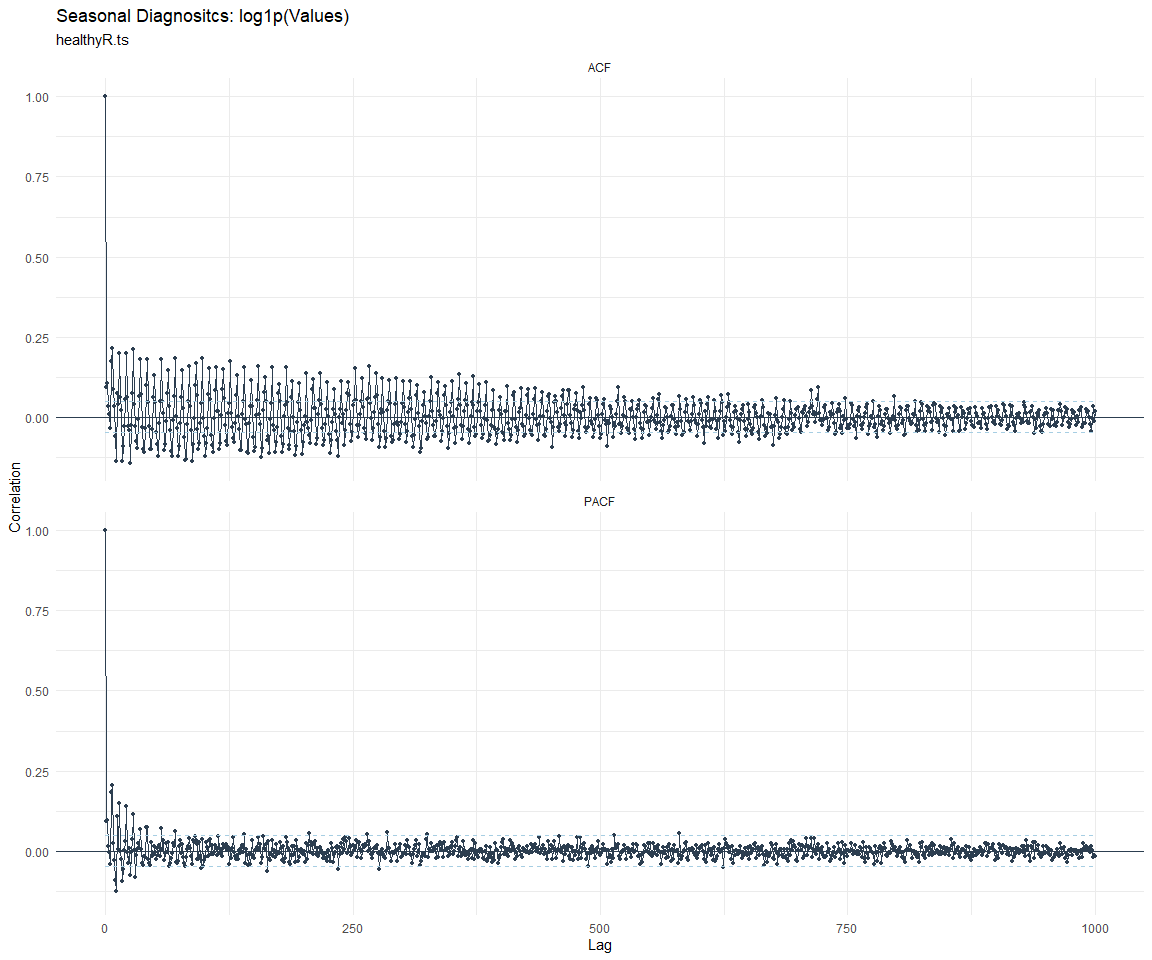
[[7]]
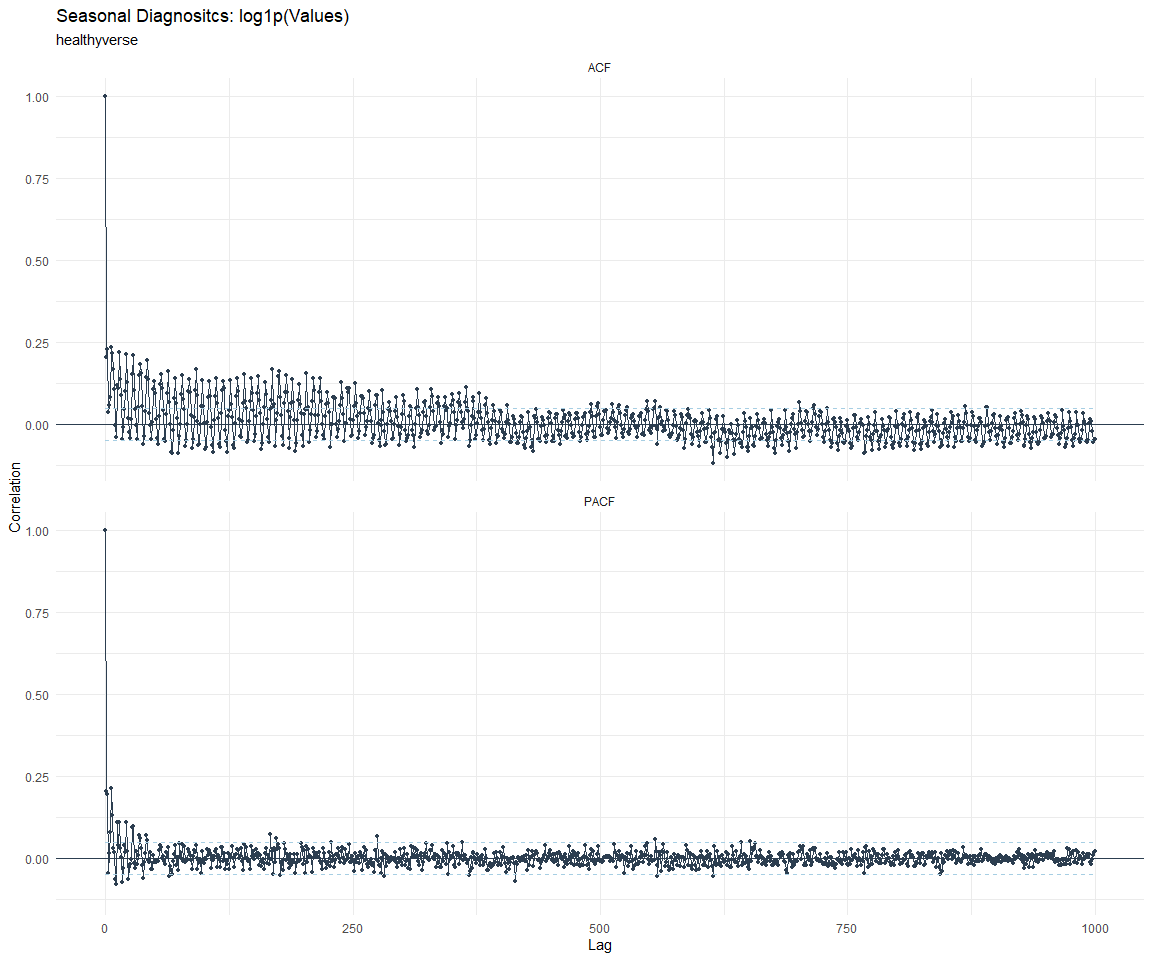
[[8]]
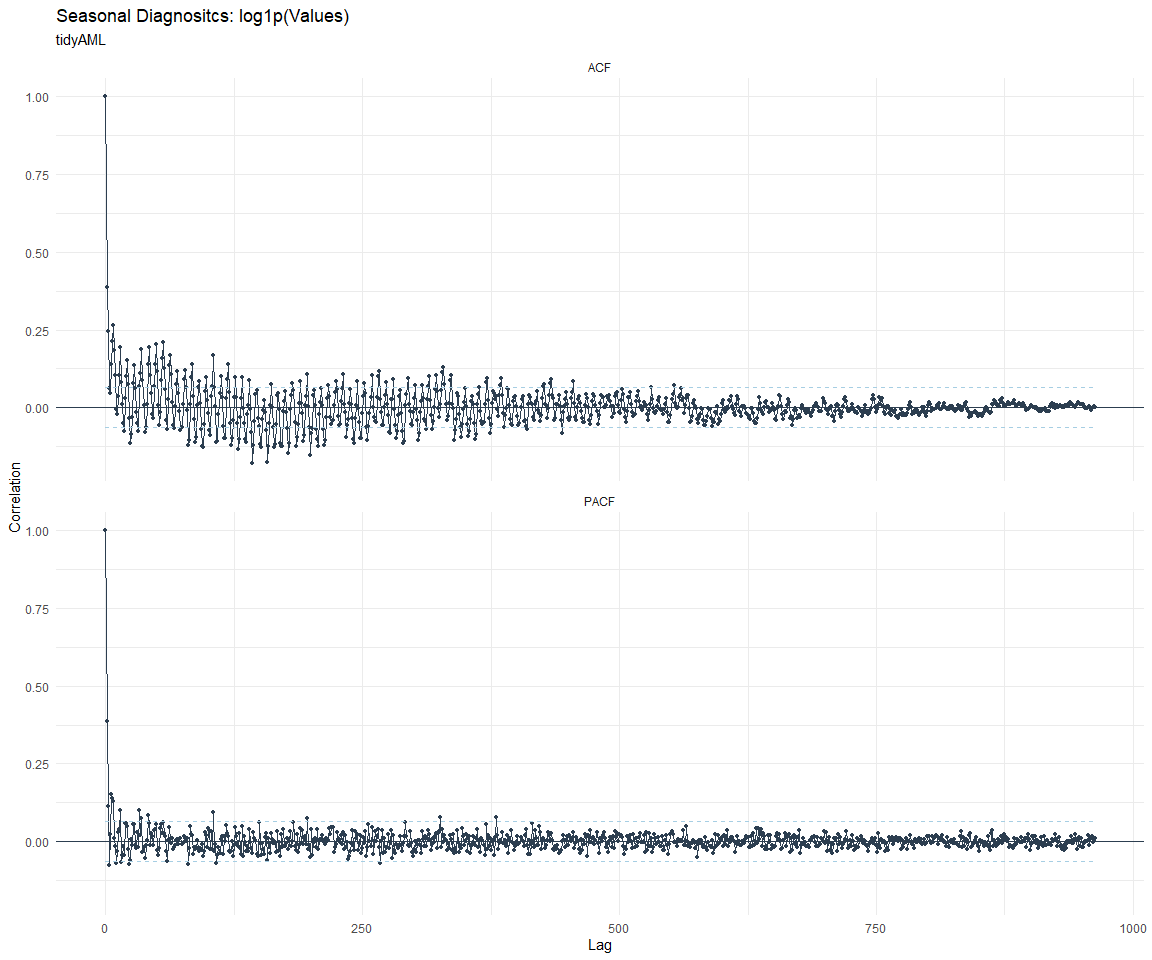
Feature Engineering
Now that we have our basic data and a shot of what it looks like, let’s
add some features to our data which can be very helpful in modeling.
Lets start by making a tibble that is aggregated by the day and
package, as we are going to be interested in forecasting the next 4
weeks or 28 days for each package. First lets get our base data.
Call:
stats::lm(formula = .formula, data = df)
Residuals:
Min 1Q Median 3Q Max
-146.94 -36.44 -11.32 26.88 820.25
Coefficients:
Estimate Std. Error
(Intercept) -1.877e+02 5.996e+01
date 1.146e-02 3.178e-03
lag(value, 1) 1.092e-01 2.314e-02
lag(value, 7) 8.822e-02 2.387e-02
lag(value, 14) 7.740e-02 2.380e-02
lag(value, 21) 8.287e-02 2.388e-02
lag(value, 28) 6.706e-02 2.380e-02
lag(value, 35) 5.175e-02 2.381e-02
lag(value, 42) 6.663e-02 2.395e-02
lag(value, 49) 6.118e-02 2.388e-02
month(date, label = TRUE).L -1.019e+01 4.991e+00
month(date, label = TRUE).Q 1.049e+00 4.900e+00
month(date, label = TRUE).C -1.537e+01 4.931e+00
month(date, label = TRUE)^4 -5.690e+00 4.921e+00
month(date, label = TRUE)^5 -6.391e+00 4.884e+00
month(date, label = TRUE)^6 1.430e+00 4.902e+00
month(date, label = TRUE)^7 -4.373e+00 4.840e+00
month(date, label = TRUE)^8 -4.005e+00 4.814e+00
month(date, label = TRUE)^9 2.794e+00 4.827e+00
month(date, label = TRUE)^10 9.289e-01 4.844e+00
month(date, label = TRUE)^11 -4.060e+00 4.830e+00
fourier_vec(date, type = "sin", K = 1, period = 7) -1.122e+01 2.206e+00
fourier_vec(date, type = "cos", K = 1, period = 7) 7.224e+00 2.285e+00
t value Pr(>|t|)
(Intercept) -3.131 0.001773 **
date 3.605 0.000320 ***
lag(value, 1) 4.716 2.59e-06 ***
lag(value, 7) 3.696 0.000225 ***
lag(value, 14) 3.251 0.001170 **
lag(value, 21) 3.470 0.000534 ***
lag(value, 28) 2.818 0.004885 **
lag(value, 35) 2.173 0.029895 *
lag(value, 42) 2.782 0.005463 **
lag(value, 49) 2.562 0.010487 *
month(date, label = TRUE).L -2.042 0.041293 *
month(date, label = TRUE).Q 0.214 0.830434
month(date, label = TRUE).C -3.116 0.001860 **
month(date, label = TRUE)^4 -1.156 0.247685
month(date, label = TRUE)^5 -1.309 0.190863
month(date, label = TRUE)^6 0.292 0.770471
month(date, label = TRUE)^7 -0.904 0.366329
month(date, label = TRUE)^8 -0.832 0.405543
month(date, label = TRUE)^9 0.579 0.562733
month(date, label = TRUE)^10 0.192 0.847938
month(date, label = TRUE)^11 -0.841 0.400689
fourier_vec(date, type = "sin", K = 1, period = 7) -5.083 4.10e-07 ***
fourier_vec(date, type = "cos", K = 1, period = 7) 3.162 0.001593 **
---
Signif. codes: 0 '***' 0.001 '**' 0.01 '*' 0.05 '.' 0.1 ' ' 1
Residual standard error: 59.25 on 1771 degrees of freedom
(49 observations deleted due to missingness)
Multiple R-squared: 0.2292, Adjusted R-squared: 0.2197
F-statistic: 23.94 on 22 and 1771 DF, p-value: < 2.2e-16
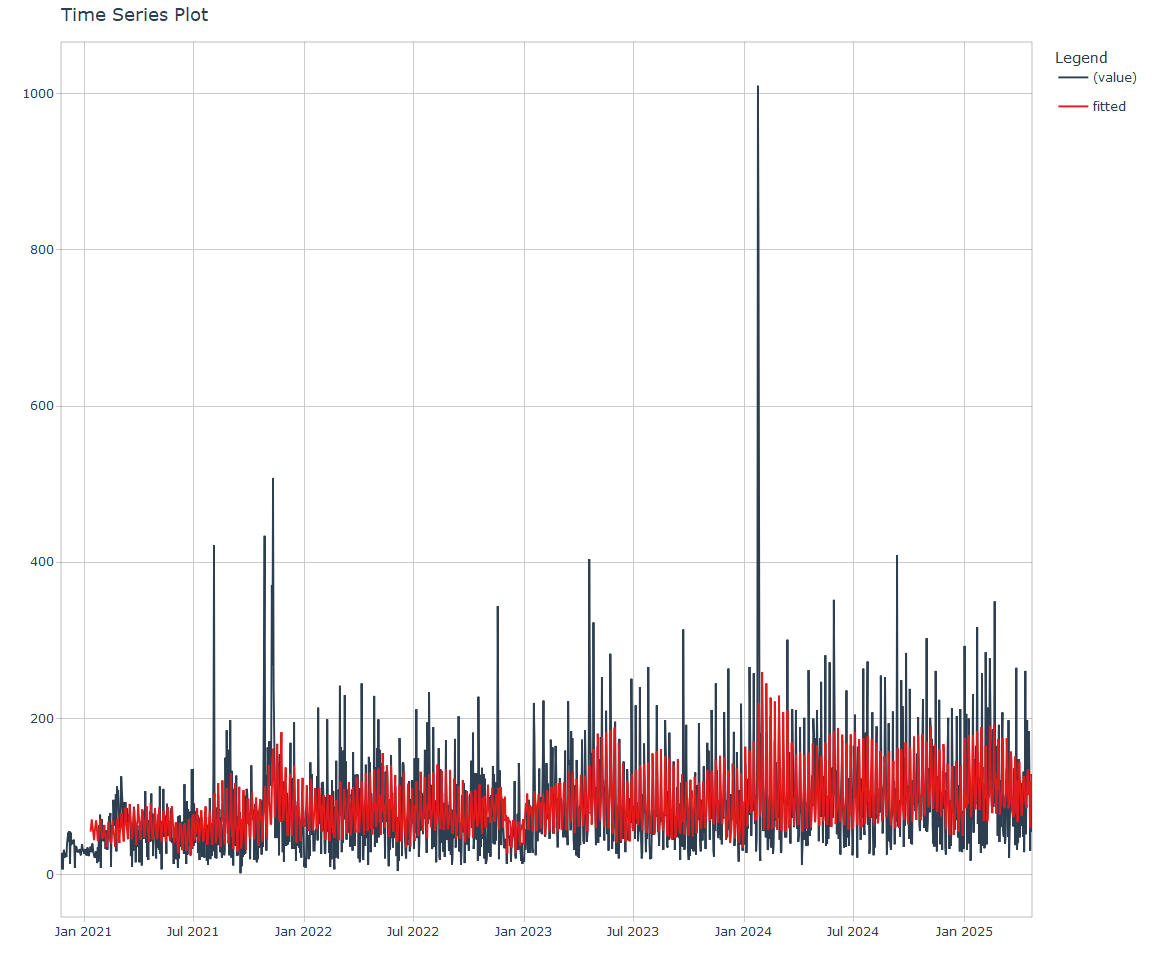
NNS Forecasting
This is something I have been wanting to try for a while. The NNS
package is a great package for forecasting time series data.
library(NNS)
data_list <- base_data |>
select(package, value) |>
group_split(package)
data_list |>
imap(
\(x, idx) {
obj <- x
x <- obj |> pull(value) |> tail(7*52)
train_set_size <- length(x) - 56
pkg <- obj |> pluck(1) |> unique()
# sf <- NNS.seas(x, modulo = 7, plot = FALSE)$periods
seas <- t(
sapply(
1:25,
function(i) c(
i,
sqrt(
mean((
NNS.ARMA(x,
h = 28,
training.set = train_set_size,
method = "lin",
seasonal.factor = i,
plot=FALSE
) - tail(x, 28)) ^ 2)))
)
)
colnames(seas) <- c("Period", "RMSE")
sf <- seas[which.min(seas[, 2]), 1]
cat(paste0("Package: ", pkg, "\n"))
NNS.ARMA.optim(
variable = x,
h = 28,
training.set = train_set_size,
#seasonal.factor = seq(12, 60, 7),
seasonal.factor = sf,
pred.int = 0.95,
plot = TRUE
)
title(
sub = paste0("\n",
"Package: ", pkg, " - NNS Optimization")
)
}
)
Package: healthyR
[1] "CURRNET METHOD: lin"
[1] "COPY LATEST PARAMETERS DIRECTLY FOR NNS.ARMA() IF ERROR:"
[1] "NNS.ARMA(... method = 'lin' , seasonal.factor = c( 1 ) ...)"
[1] "CURRENT lin OBJECTIVE FUNCTION = 243.478092455172"
[1] "BEST method = 'lin' PATH MEMBER = c( 1 )"
[1] "BEST lin OBJECTIVE FUNCTION = 243.478092455172"
[1] "CURRNET METHOD: nonlin"
[1] "COPY LATEST PARAMETERS DIRECTLY FOR NNS.ARMA() IF ERROR:"
[1] "NNS.ARMA(... method = 'nonlin' , seasonal.factor = c( 1 ) ...)"
[1] "CURRENT nonlin OBJECTIVE FUNCTION = 30.0366329894861"
[1] "BEST method = 'nonlin' PATH MEMBER = c( 1 )"
[1] "BEST nonlin OBJECTIVE FUNCTION = 30.0366329894861"
[1] "CURRNET METHOD: both"
[1] "COPY LATEST PARAMETERS DIRECTLY FOR NNS.ARMA() IF ERROR:"
[1] "NNS.ARMA(... method = 'both' , seasonal.factor = c( 1 ) ...)"
[1] "CURRENT both OBJECTIVE FUNCTION = 44.329328767277"
[1] "BEST method = 'both' PATH MEMBER = c( 1 )"
[1] "BEST both OBJECTIVE FUNCTION = 44.329328767277"
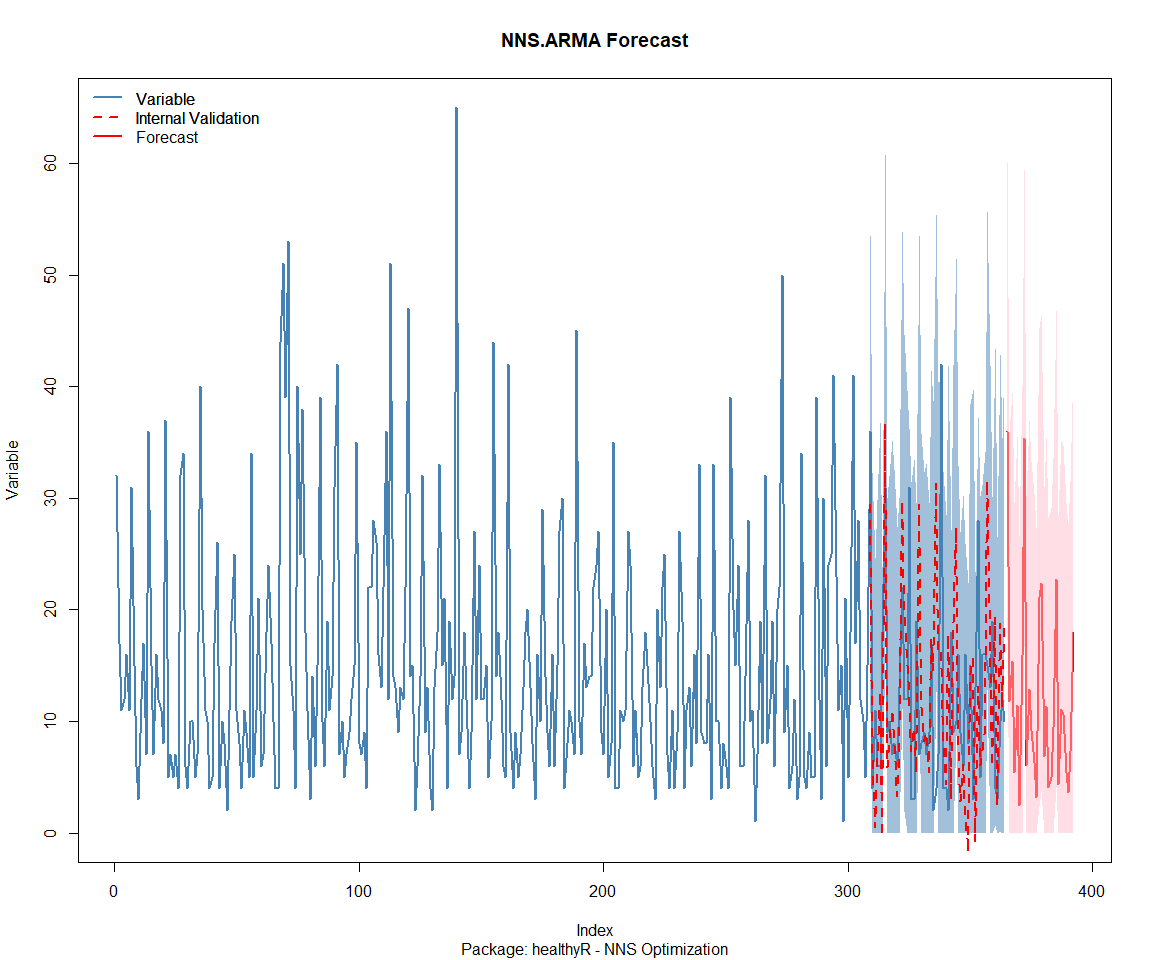
Package: healthyR.ai
[1] "CURRNET METHOD: lin"
[1] "COPY LATEST PARAMETERS DIRECTLY FOR NNS.ARMA() IF ERROR:"
[1] "NNS.ARMA(... method = 'lin' , seasonal.factor = c( 3 ) ...)"
[1] "CURRENT lin OBJECTIVE FUNCTION = 25.6385795145685"
[1] "BEST method = 'lin' PATH MEMBER = c( 3 )"
[1] "BEST lin OBJECTIVE FUNCTION = 25.6385795145685"
[1] "CURRNET METHOD: nonlin"
[1] "COPY LATEST PARAMETERS DIRECTLY FOR NNS.ARMA() IF ERROR:"
[1] "NNS.ARMA(... method = 'nonlin' , seasonal.factor = c( 3 ) ...)"
[1] "CURRENT nonlin OBJECTIVE FUNCTION = 20.7505942967418"
[1] "BEST method = 'nonlin' PATH MEMBER = c( 3 )"
[1] "BEST nonlin OBJECTIVE FUNCTION = 20.7505942967418"
[1] "CURRNET METHOD: both"
[1] "COPY LATEST PARAMETERS DIRECTLY FOR NNS.ARMA() IF ERROR:"
[1] "NNS.ARMA(... method = 'both' , seasonal.factor = c( 3 ) ...)"
[1] "CURRENT both OBJECTIVE FUNCTION = 33.8876693481393"
[1] "BEST method = 'both' PATH MEMBER = c( 3 )"
[1] "BEST both OBJECTIVE FUNCTION = 33.8876693481393"
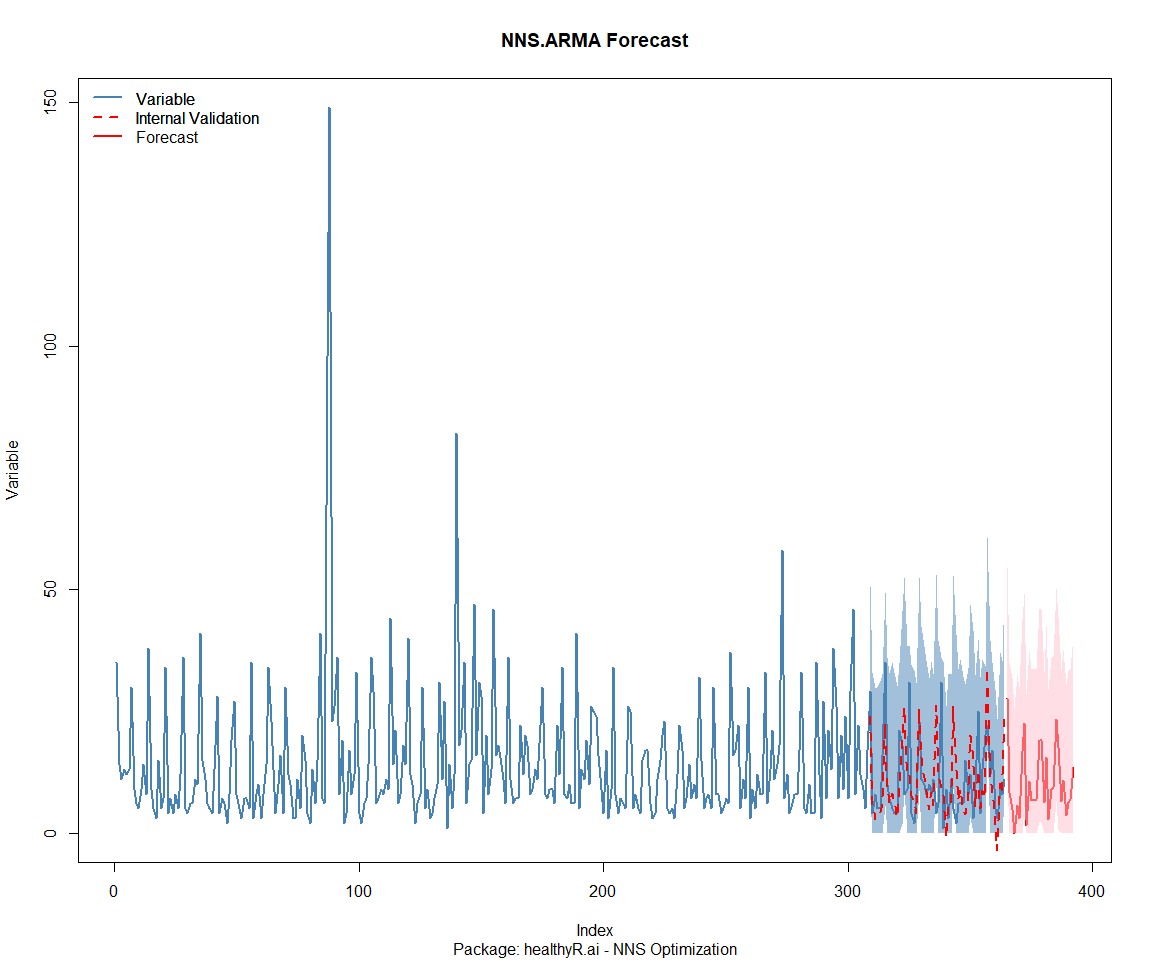
Package: healthyR.data
[1] "CURRNET METHOD: lin"
[1] "COPY LATEST PARAMETERS DIRECTLY FOR NNS.ARMA() IF ERROR:"
[1] "NNS.ARMA(... method = 'lin' , seasonal.factor = c( 5 ) ...)"
[1] "CURRENT lin OBJECTIVE FUNCTION = 21.0668758514447"
[1] "BEST method = 'lin' PATH MEMBER = c( 5 )"
[1] "BEST lin OBJECTIVE FUNCTION = 21.0668758514447"
[1] "CURRNET METHOD: nonlin"
[1] "COPY LATEST PARAMETERS DIRECTLY FOR NNS.ARMA() IF ERROR:"
[1] "NNS.ARMA(... method = 'nonlin' , seasonal.factor = c( 5 ) ...)"
[1] "CURRENT nonlin OBJECTIVE FUNCTION = 4.34974531506221"
[1] "BEST method = 'nonlin' PATH MEMBER = c( 5 )"
[1] "BEST nonlin OBJECTIVE FUNCTION = 4.34974531506221"
[1] "CURRNET METHOD: both"
[1] "COPY LATEST PARAMETERS DIRECTLY FOR NNS.ARMA() IF ERROR:"
[1] "NNS.ARMA(... method = 'both' , seasonal.factor = c( 5 ) ...)"
[1] "CURRENT both OBJECTIVE FUNCTION = 6.40297197837678"
[1] "BEST method = 'both' PATH MEMBER = c( 5 )"
[1] "BEST both OBJECTIVE FUNCTION = 6.40297197837678"
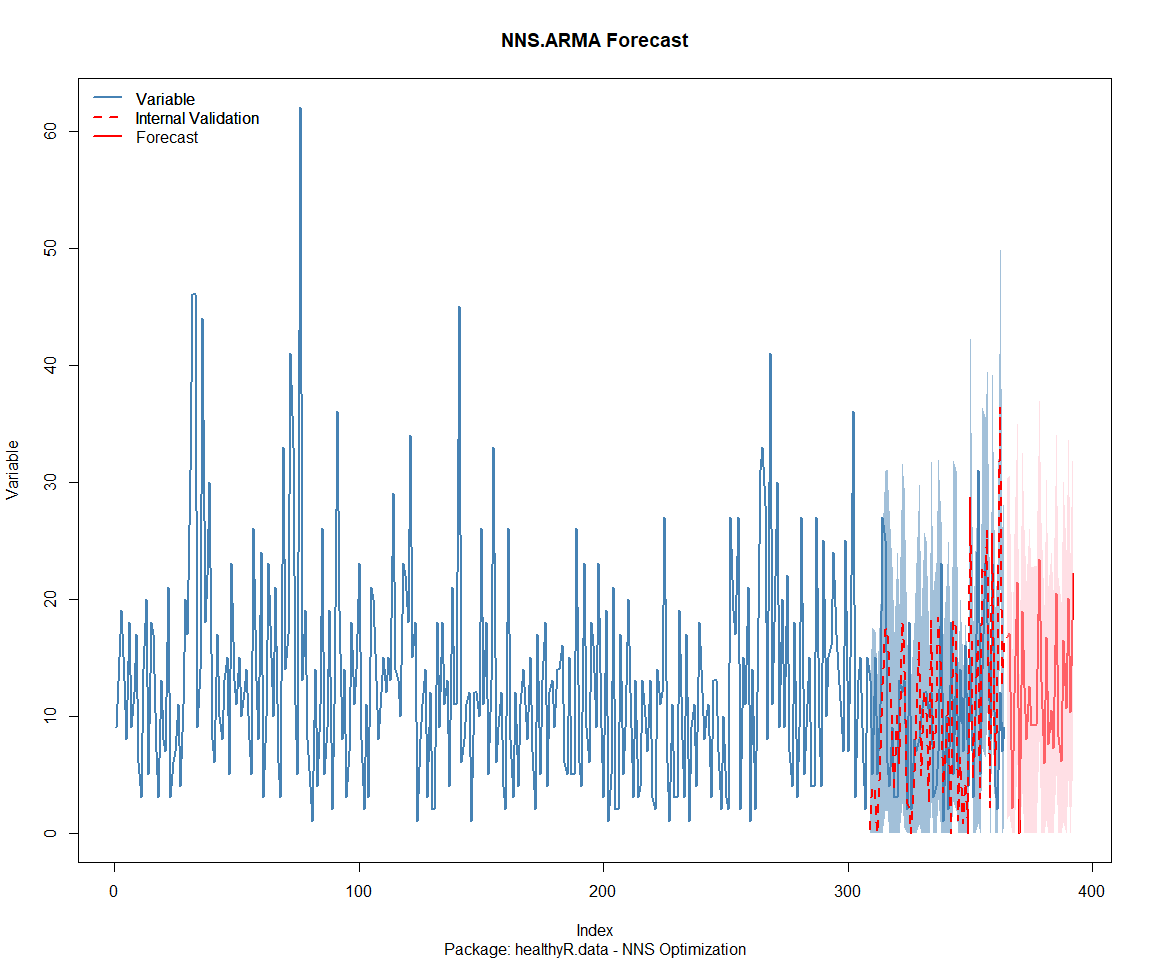
Package: healthyR.ts
[1] "CURRNET METHOD: lin"
[1] "COPY LATEST PARAMETERS DIRECTLY FOR NNS.ARMA() IF ERROR:"
[1] "NNS.ARMA(... method = 'lin' , seasonal.factor = c( 19 ) ...)"
[1] "CURRENT lin OBJECTIVE FUNCTION = 18.1201913399835"
[1] "BEST method = 'lin' PATH MEMBER = c( 19 )"
[1] "BEST lin OBJECTIVE FUNCTION = 18.1201913399835"
[1] "CURRNET METHOD: nonlin"
[1] "COPY LATEST PARAMETERS DIRECTLY FOR NNS.ARMA() IF ERROR:"
[1] "NNS.ARMA(... method = 'nonlin' , seasonal.factor = c( 19 ) ...)"
[1] "CURRENT nonlin OBJECTIVE FUNCTION = 21.1594070337835"
[1] "BEST method = 'nonlin' PATH MEMBER = c( 19 )"
[1] "BEST nonlin OBJECTIVE FUNCTION = 21.1594070337835"
[1] "CURRNET METHOD: both"
[1] "COPY LATEST PARAMETERS DIRECTLY FOR NNS.ARMA() IF ERROR:"
[1] "NNS.ARMA(... method = 'both' , seasonal.factor = c( 19 ) ...)"
[1] "CURRENT both OBJECTIVE FUNCTION = 22.3002416739308"
[1] "BEST method = 'both' PATH MEMBER = c( 19 )"
[1] "BEST both OBJECTIVE FUNCTION = 22.3002416739308"
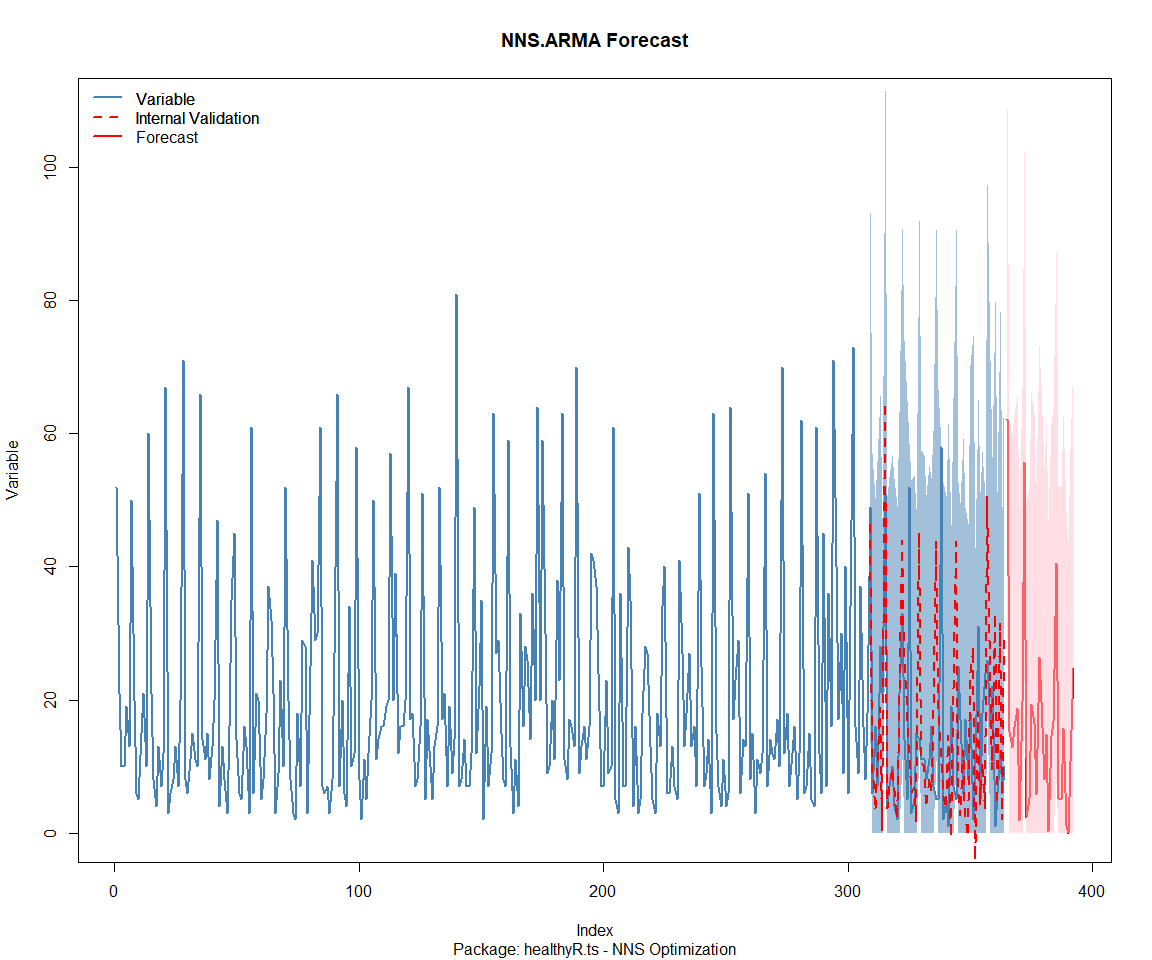
Package: healthyverse
[1] "CURRNET METHOD: lin"
[1] "COPY LATEST PARAMETERS DIRECTLY FOR NNS.ARMA() IF ERROR:"
[1] "NNS.ARMA(... method = 'lin' , seasonal.factor = c( 4 ) ...)"
[1] "CURRENT lin OBJECTIVE FUNCTION = 8.00358885549315"
[1] "BEST method = 'lin' PATH MEMBER = c( 4 )"
[1] "BEST lin OBJECTIVE FUNCTION = 8.00358885549315"
[1] "CURRNET METHOD: nonlin"
[1] "COPY LATEST PARAMETERS DIRECTLY FOR NNS.ARMA() IF ERROR:"
[1] "NNS.ARMA(... method = 'nonlin' , seasonal.factor = c( 4 ) ...)"
[1] "CURRENT nonlin OBJECTIVE FUNCTION = 9.44183272187358"
[1] "BEST method = 'nonlin' PATH MEMBER = c( 4 )"
[1] "BEST nonlin OBJECTIVE FUNCTION = 9.44183272187358"
[1] "CURRNET METHOD: both"
[1] "COPY LATEST PARAMETERS DIRECTLY FOR NNS.ARMA() IF ERROR:"
[1] "NNS.ARMA(... method = 'both' , seasonal.factor = c( 4 ) ...)"
[1] "CURRENT both OBJECTIVE FUNCTION = 9.34700411858771"
[1] "BEST method = 'both' PATH MEMBER = c( 4 )"
[1] "BEST both OBJECTIVE FUNCTION = 9.34700411858771"
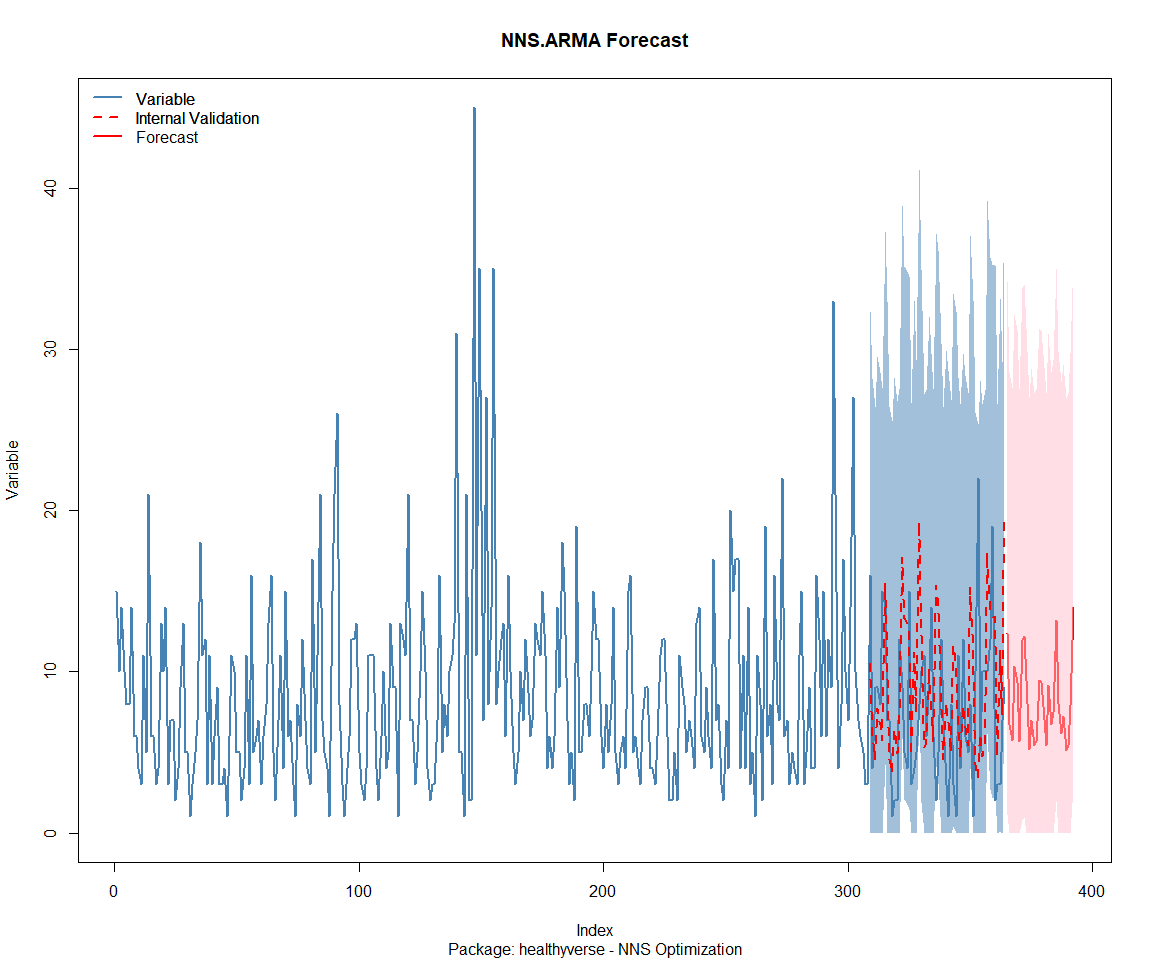
Package: RandomWalker
[1] "CURRNET METHOD: lin"
[1] "COPY LATEST PARAMETERS DIRECTLY FOR NNS.ARMA() IF ERROR:"
[1] "NNS.ARMA(... method = 'lin' , seasonal.factor = c( 23 ) ...)"
[1] "CURRENT lin OBJECTIVE FUNCTION = 8.40842745185813"
[1] "BEST method = 'lin' PATH MEMBER = c( 23 )"
[1] "BEST lin OBJECTIVE FUNCTION = 8.40842745185813"
[1] "CURRNET METHOD: nonlin"
[1] "COPY LATEST PARAMETERS DIRECTLY FOR NNS.ARMA() IF ERROR:"
[1] "NNS.ARMA(... method = 'nonlin' , seasonal.factor = c( 23 ) ...)"
[1] "CURRENT nonlin OBJECTIVE FUNCTION = 5.09413538684205"
[1] "BEST method = 'nonlin' PATH MEMBER = c( 23 )"
[1] "BEST nonlin OBJECTIVE FUNCTION = 5.09413538684205"
[1] "CURRNET METHOD: both"
[1] "COPY LATEST PARAMETERS DIRECTLY FOR NNS.ARMA() IF ERROR:"
[1] "NNS.ARMA(... method = 'both' , seasonal.factor = c( 23 ) ...)"
[1] "CURRENT both OBJECTIVE FUNCTION = 5.36082929195022"
[1] "BEST method = 'both' PATH MEMBER = c( 23 )"
[1] "BEST both OBJECTIVE FUNCTION = 5.36082929195022"
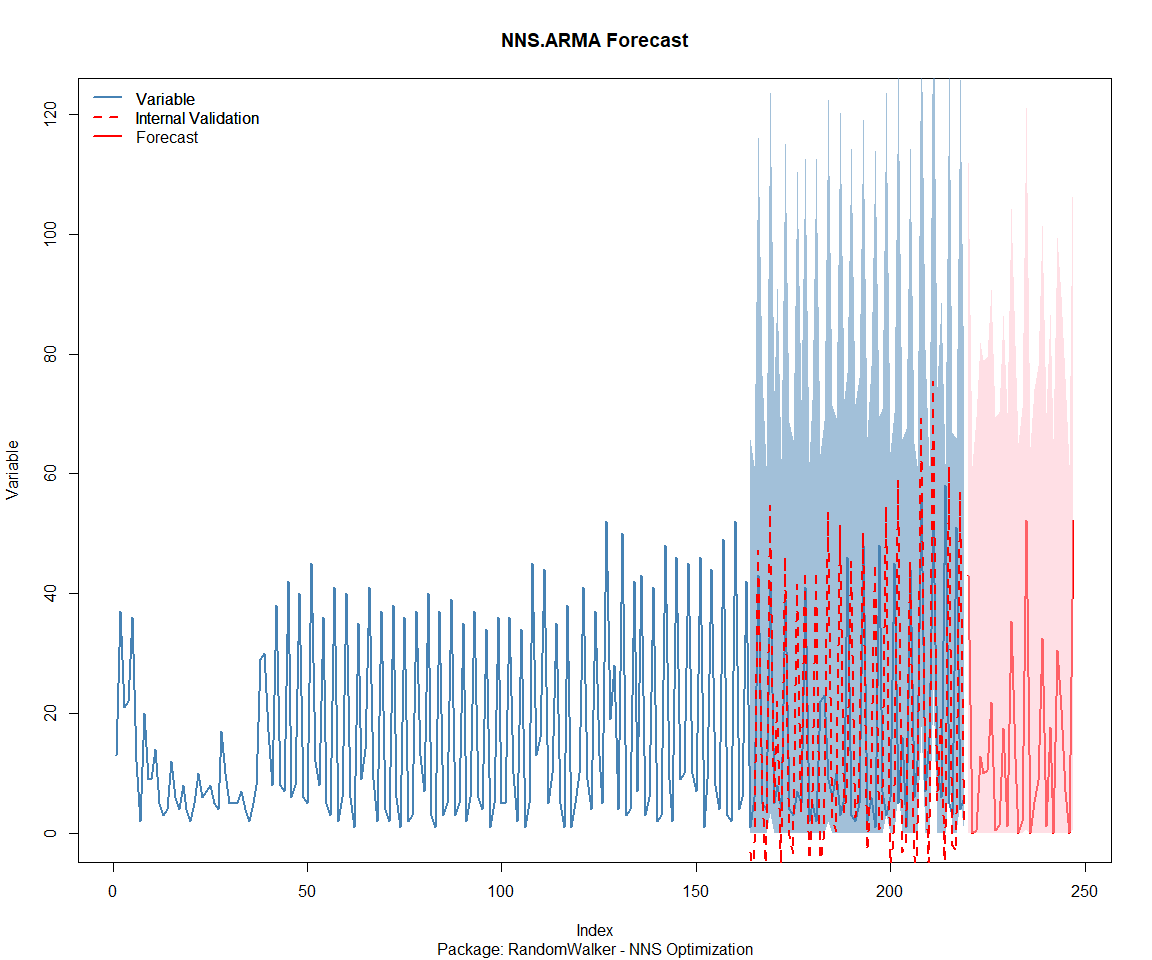
Package: tidyAML
[1] "CURRNET METHOD: lin"
[1] "COPY LATEST PARAMETERS DIRECTLY FOR NNS.ARMA() IF ERROR:"
[1] "NNS.ARMA(... method = 'lin' , seasonal.factor = c( 1 ) ...)"
[1] "CURRENT lin OBJECTIVE FUNCTION = 146.027591079304"
[1] "BEST method = 'lin' PATH MEMBER = c( 1 )"
[1] "BEST lin OBJECTIVE FUNCTION = 146.027591079304"
[1] "CURRNET METHOD: nonlin"
[1] "COPY LATEST PARAMETERS DIRECTLY FOR NNS.ARMA() IF ERROR:"
[1] "NNS.ARMA(... method = 'nonlin' , seasonal.factor = c( 1 ) ...)"
[1] "CURRENT nonlin OBJECTIVE FUNCTION = 115.524785880856"
[1] "BEST method = 'nonlin' PATH MEMBER = c( 1 )"
[1] "BEST nonlin OBJECTIVE FUNCTION = 115.524785880856"
[1] "CURRNET METHOD: both"
[1] "COPY LATEST PARAMETERS DIRECTLY FOR NNS.ARMA() IF ERROR:"
[1] "NNS.ARMA(... method = 'both' , seasonal.factor = c( 1 ) ...)"
[1] "CURRENT both OBJECTIVE FUNCTION = 127.863994530314"
[1] "BEST method = 'both' PATH MEMBER = c( 1 )"
[1] "BEST both OBJECTIVE FUNCTION = 127.863994530314"
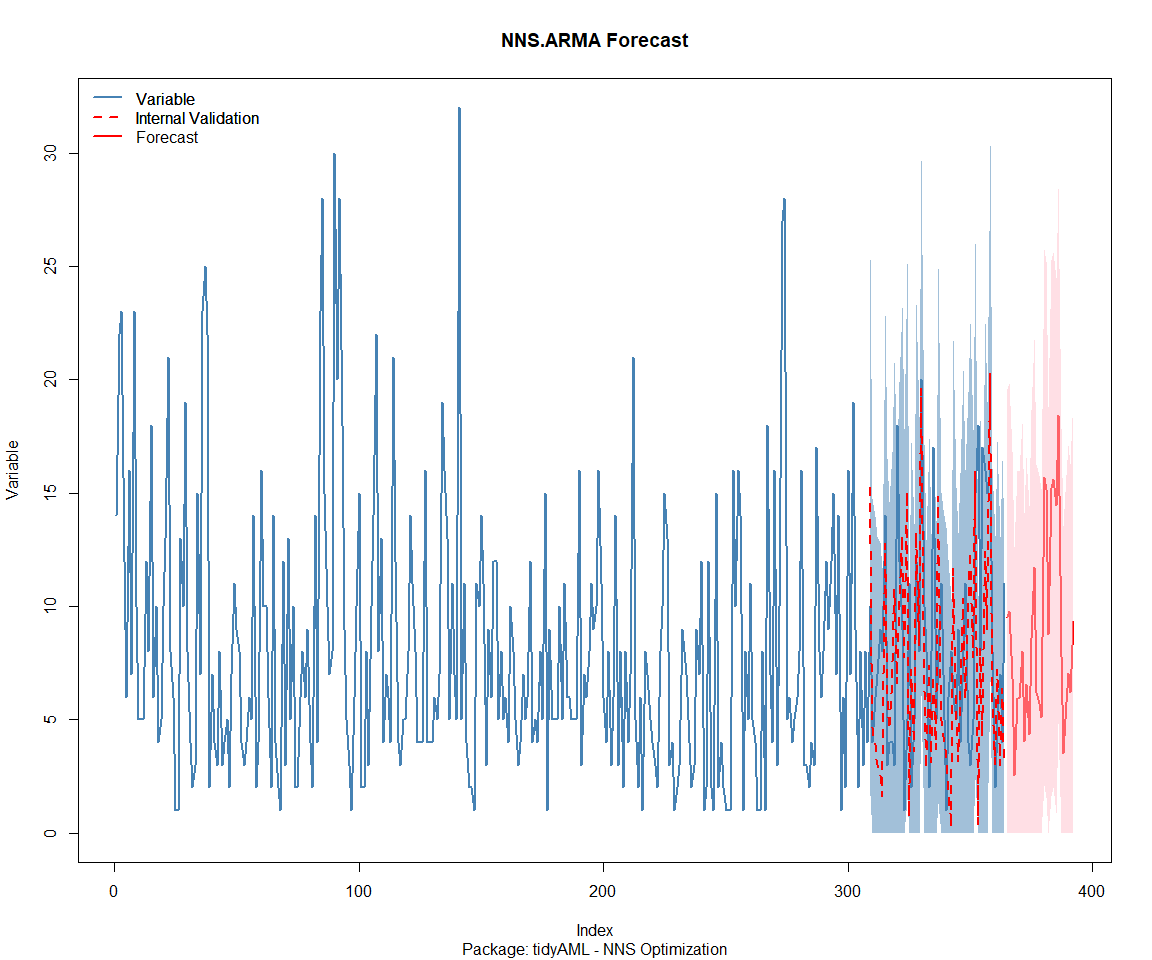
Package: TidyDensity
[1] "CURRNET METHOD: lin"
[1] "COPY LATEST PARAMETERS DIRECTLY FOR NNS.ARMA() IF ERROR:"
[1] "NNS.ARMA(... method = 'lin' , seasonal.factor = c( 7 ) ...)"
[1] "CURRENT lin OBJECTIVE FUNCTION = 11.180346607479"
[1] "BEST method = 'lin' PATH MEMBER = c( 7 )"
[1] "BEST lin OBJECTIVE FUNCTION = 11.180346607479"
[1] "CURRNET METHOD: nonlin"
[1] "COPY LATEST PARAMETERS DIRECTLY FOR NNS.ARMA() IF ERROR:"
[1] "NNS.ARMA(... method = 'nonlin' , seasonal.factor = c( 7 ) ...)"
[1] "CURRENT nonlin OBJECTIVE FUNCTION = 11.1248767024303"
[1] "BEST method = 'nonlin' PATH MEMBER = c( 7 )"
[1] "BEST nonlin OBJECTIVE FUNCTION = 11.1248767024303"
[1] "CURRNET METHOD: both"
[1] "COPY LATEST PARAMETERS DIRECTLY FOR NNS.ARMA() IF ERROR:"
[1] "NNS.ARMA(... method = 'both' , seasonal.factor = c( 7 ) ...)"
[1] "CURRENT both OBJECTIVE FUNCTION = 13.2981575724137"
[1] "BEST method = 'both' PATH MEMBER = c( 7 )"
[1] "BEST both OBJECTIVE FUNCTION = 13.2981575724137"
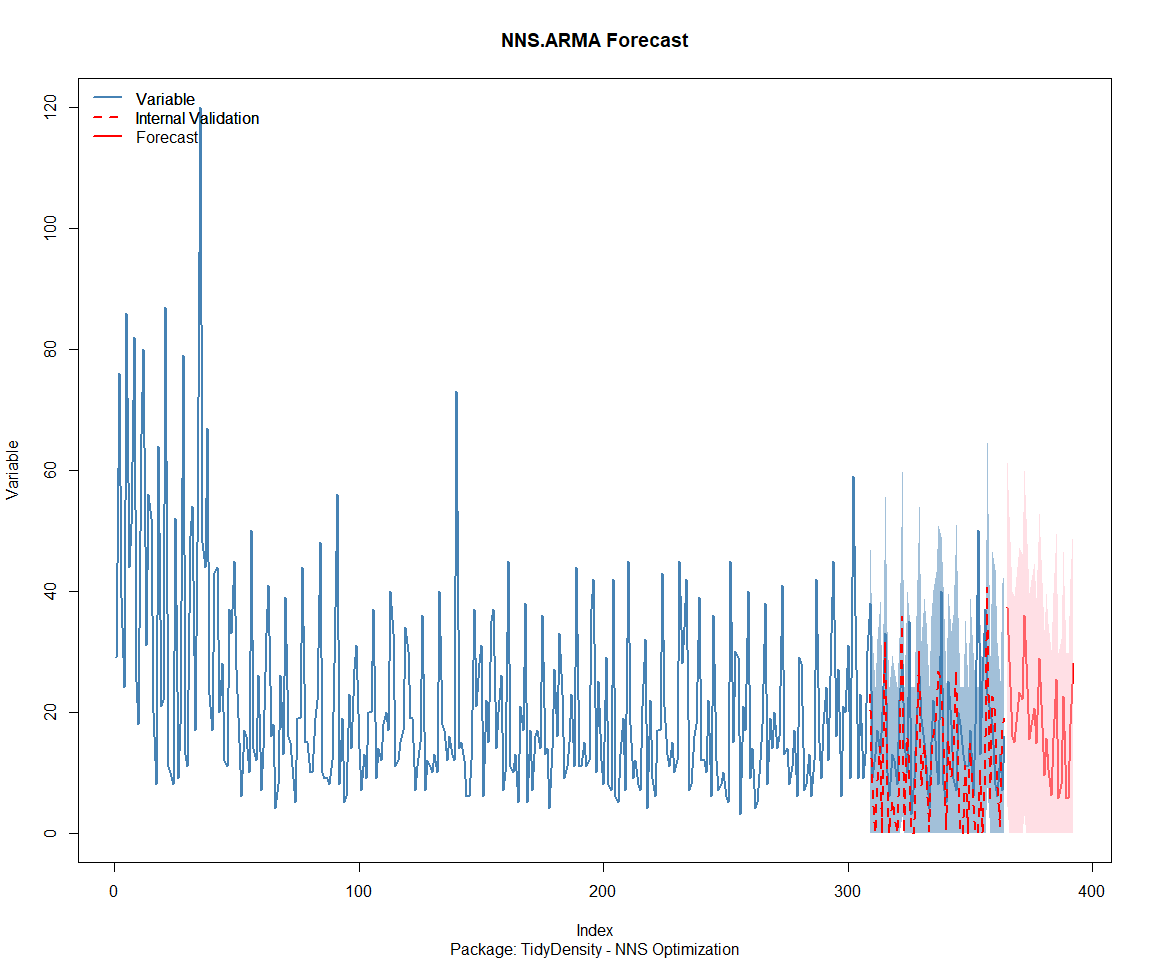
[[1]]
NULL
[[2]]
NULL
[[3]]
NULL
[[4]]
NULL
[[5]]
NULL
[[6]]
NULL
[[7]]
NULL
[[8]]
NULL
Pre-Processing
Now we are going to do some basic pre-processing.
data_padded_tbl <- base_data %>%
pad_by_time(
.date_var = date,
.pad_value = 0
)
# Get log interval and standardization parameters
log_params <- liv(data_padded_tbl$value, limit_lower = 0, offset = 1, silent = TRUE)
limit_lower <- log_params$limit_lower
limit_upper <- log_params$limit_upper
offset <- log_params$offset
data_liv_tbl <- data_padded_tbl %>%
# Get log interval transform
mutate(value_trans = liv(value, limit_lower = 0, offset = 1, silent = TRUE)$log_scaled)
# Get Standardization Params
std_params <- standard_vec(data_liv_tbl$value_trans, silent = TRUE)
std_mean <- std_params$mean
std_sd <- std_params$sd
data_transformed_tbl <- data_liv_tbl %>%
group_by(package) %>%
# get standardization
mutate(value_trans = standard_vec(value_trans, silent = TRUE)$standard_scaled) %>%
tk_augment_fourier(
.date_var = date,
.periods = c(7, 14, 30, 90, 180),
.K = 2
) %>%
tk_augment_timeseries_signature(
.date_var = date
) %>%
ungroup() %>%
select(-c(value, -year.iso))
Since this is panel data we can follow one of two different modeling strategies. We can search for a global model in the panel data or we can use nested forecasting finding the best model for each of the time series. Since we only have 5 panels, we will use nested forecasting.
To do this we will use the nest_timeseries and
split_nested_timeseries functions to create a nested tibble.
horizon <- 4*7
nested_data_tbl <- data_transformed_tbl %>%
# 0. Filter out column where package is NA
filter(!is.na(package)) %>%
# 1. Extending: We'll predict n days into the future.
extend_timeseries(
.id_var = package,
.date_var = date,
.length_future = horizon
) %>%
# 2. Nesting: We'll group by id, and create a future dataset
# that forecasts n days of extended data and
# an actual dataset that contains n*2 days
nest_timeseries(
.id_var = package,
.length_future = horizon
#.length_actual = horizon*2
) %>%
# 3. Splitting: We'll take the actual data and create splits
# for accuracy and confidence interval estimation of n das (test)
# and the rest is training data
split_nested_timeseries(
.length_test = horizon
)
nested_data_tbl
# A tibble: 8 × 4
package .actual_data .future_data .splits
<fct> <list> <list> <list>
1 healthyR.data <tibble [1,835 × 50]> <tibble [28 × 50]> <split [1807|28]>
2 healthyR <tibble [1,826 × 50]> <tibble [28 × 50]> <split [1798|28]>
3 healthyR.ts <tibble [1,771 × 50]> <tibble [28 × 50]> <split [1743|28]>
4 healthyverse <tibble [1,742 × 50]> <tibble [28 × 50]> <split [1714|28]>
5 healthyR.ai <tibble [1,568 × 50]> <tibble [28 × 50]> <split [1540|28]>
6 TidyDensity <tibble [1,419 × 50]> <tibble [28 × 50]> <split [1391|28]>
7 tidyAML <tibble [1,026 × 50]> <tibble [28 × 50]> <split [998|28]>
8 RandomWalker <tibble [449 × 50]> <tibble [28 × 50]> <split [421|28]>
Now it is time to make some recipes and models using the modeltime workflow.
Modeltime Workflow
Recipe Object
recipe_base <- recipe(
value_trans ~ .
, data = extract_nested_test_split(nested_data_tbl)
)
recipe_base
recipe_date <- recipe(
value_trans ~ date
, data = extract_nested_test_split(nested_data_tbl)
)
Models
# Models ------------------------------------------------------------------
# Auto ARIMA --------------------------------------------------------------
model_spec_arima_no_boost <- arima_reg() %>%
set_engine(engine = "auto_arima")
wflw_auto_arima <- workflow() %>%
add_recipe(recipe = recipe_date) %>%
add_model(model_spec_arima_no_boost)
# NNETAR ------------------------------------------------------------------
model_spec_nnetar <- nnetar_reg(
mode = "regression"
, seasonal_period = "auto"
) %>%
set_engine("nnetar")
wflw_nnetar <- workflow() %>%
add_recipe(recipe = recipe_base) %>%
add_model(model_spec_nnetar)
# TSLM --------------------------------------------------------------------
model_spec_lm <- linear_reg() %>%
set_engine("lm")
wflw_lm <- workflow() %>%
add_recipe(recipe = recipe_base) %>%
add_model(model_spec_lm)
# MARS --------------------------------------------------------------------
model_spec_mars <- mars(mode = "regression") %>%
set_engine("earth")
wflw_mars <- workflow() %>%
add_recipe(recipe = recipe_date) %>%
add_model(model_spec_mars)
Nested Modeltime Tables
nested_modeltime_tbl <- modeltime_nested_fit(
# Nested Data
nested_data = nested_data_tbl,
control = control_nested_fit(
verbose = TRUE,
allow_par = FALSE
),
# Add workflows
wflw_auto_arima,
wflw_lm,
wflw_mars,
wflw_nnetar
)
nested_modeltime_tbl <- nested_modeltime_tbl[!is.na(nested_modeltime_tbl$package),]
Model Accuracy
nested_modeltime_tbl %>%
extract_nested_test_accuracy() %>%
filter(!is.na(package)) %>%
knitr::kable()
| package | .model_id | .model_desc | .type | mae | mape | mase | smape | rmse | rsq |
|---|---|---|---|---|---|---|---|---|---|
| healthyR.data | 1 | ARIMA | Test | 0.6295378 | 142.71893 | 0.6832193 | 133.8406 | 0.7205613 | 0.1066485 |
| healthyR.data | 2 | LM | Test | 0.6421498 | 212.15756 | 0.6969067 | 114.8769 | 0.7788429 | 0.0029393 |
| healthyR.data | 3 | EARTH | Test | 1.4793042 | 704.58514 | 1.6054463 | 119.9178 | 1.7286596 | 0.0535162 |
| healthyR.data | 4 | NNAR | Test | 0.7094235 | 224.58871 | 0.7699169 | 130.5761 | 0.8322777 | 0.0018386 |
| healthyR | 1 | ARIMA | Test | 0.5590016 | 218.89165 | 0.8119011 | 138.4364 | 0.7092469 | 0.0332536 |
| healthyR | 2 | LM | Test | 0.5584064 | 444.28955 | 0.8110366 | 112.1494 | 0.6825985 | 0.0544181 |
| healthyR | 3 | EARTH | Test | 0.7594535 | 818.04051 | 1.1030399 | 105.1129 | 0.9259031 | 0.0891325 |
| healthyR | 4 | NNAR | Test | 0.5810239 | 290.55244 | 0.8438865 | 133.4932 | 0.6928366 | 0.0408093 |
| healthyR.ts | 1 | ARIMA | Test | 0.6083277 | 119.69416 | 0.7093934 | 146.4844 | 0.7583060 | 0.0302680 |
| healthyR.ts | 2 | LM | Test | 0.7334489 | 185.73691 | 0.8553019 | 137.8295 | 0.8885957 | 0.0079987 |
| healthyR.ts | 3 | EARTH | Test | 0.5557010 | 130.21659 | 0.6480235 | 103.7069 | 0.7284684 | 0.0004797 |
| healthyR.ts | 4 | NNAR | Test | 0.8468405 | 183.64304 | 0.9875321 | 157.4683 | 1.0213269 | 0.0598094 |
| healthyverse | 1 | ARIMA | Test | 0.7100772 | 85.04524 | 0.6903345 | 132.0528 | 0.9259873 | 0.0340838 |
| healthyverse | 2 | LM | Test | 0.8052442 | 134.10717 | 0.7828555 | 121.8219 | 0.9451966 | 0.0003340 |
| healthyverse | 3 | EARTH | Test | 0.9790064 | 240.17660 | 0.9517864 | 106.7423 | 1.1598628 | 0.2271117 |
| healthyverse | 4 | NNAR | Test | 0.7323805 | 124.13894 | 0.7120176 | 128.3646 | 0.8545041 | 0.0883922 |
| healthyR.ai | 1 | ARIMA | Test | 0.8303134 | 97.33738 | 1.0363633 | 178.5921 | 0.9915573 | 0.4814802 |
| healthyR.ai | 2 | LM | Test | 1.0765458 | 190.24565 | 1.3437005 | 155.5457 | 1.2798128 | 0.0953732 |
| healthyR.ai | 3 | EARTH | Test | 0.8416255 | 111.82412 | 1.0504826 | 151.7271 | 1.0074093 | 0.2959586 |
| healthyR.ai | 4 | NNAR | Test | 1.1067304 | 194.12150 | 1.3813757 | 160.8017 | 1.2905852 | 0.0026308 |
| TidyDensity | 1 | ARIMA | Test | 1.1282701 | 232.81935 | 0.7062059 | 166.8137 | 1.2344122 | 0.1118411 |
| TidyDensity | 2 | LM | Test | 0.9732163 | 136.55889 | 0.6091547 | 162.0322 | 1.1653704 | 0.0027889 |
| TidyDensity | 3 | EARTH | Test | 1.0424516 | 167.14861 | 0.6524904 | 174.6130 | 1.1744119 | 0.0321696 |
| TidyDensity | 4 | NNAR | Test | 1.0461327 | 166.46550 | 0.6547945 | 157.7004 | 1.1785186 | 0.0233588 |
| tidyAML | 1 | ARIMA | Test | 0.5256984 | 123.75762 | 0.6236111 | 126.3257 | 0.6753641 | 0.0522170 |
| tidyAML | 2 | LM | Test | 0.6420028 | 280.31938 | 0.7615774 | 140.3228 | 0.7936177 | 0.0306975 |
| tidyAML | 3 | EARTH | Test | 1.2405593 | 637.67625 | 1.4716166 | 127.5621 | 1.4459581 | 0.0990013 |
| tidyAML | 4 | NNAR | Test | 0.7106039 | 349.70407 | 0.8429557 | 122.4697 | 0.8418906 | 0.0133717 |
| RandomWalker | 1 | ARIMA | Test | 0.6990402 | 124.77274 | 0.6667399 | 158.1787 | 0.7969401 | 0.2363105 |
| RandomWalker | 2 | LM | Test | 0.7390193 | 134.96611 | 0.7048717 | 151.5084 | 0.9042367 | 0.0078612 |
| RandomWalker | 3 | EARTH | Test | 0.8839719 | 221.99772 | 0.8431266 | 163.8289 | 0.9438590 | 0.0853449 |
| RandomWalker | 4 | NNAR | Test | 0.7113354 | 117.44345 | 0.6784670 | 145.1600 | 0.8925960 | 0.0099587 |
Plot Models
nested_modeltime_tbl %>%
extract_nested_test_forecast() %>%
group_by(package) %>%
filter_by_time(.date_var = .index, .start_date = max(.index) - 60) %>%
ungroup() %>%
plot_modeltime_forecast(
.interactive = FALSE,
.conf_interval_show = FALSE,
.facet_scales = "free"
) +
theme_minimal() +
facet_wrap(~ package, nrow = 3) +
theme(legend.position = "bottom")
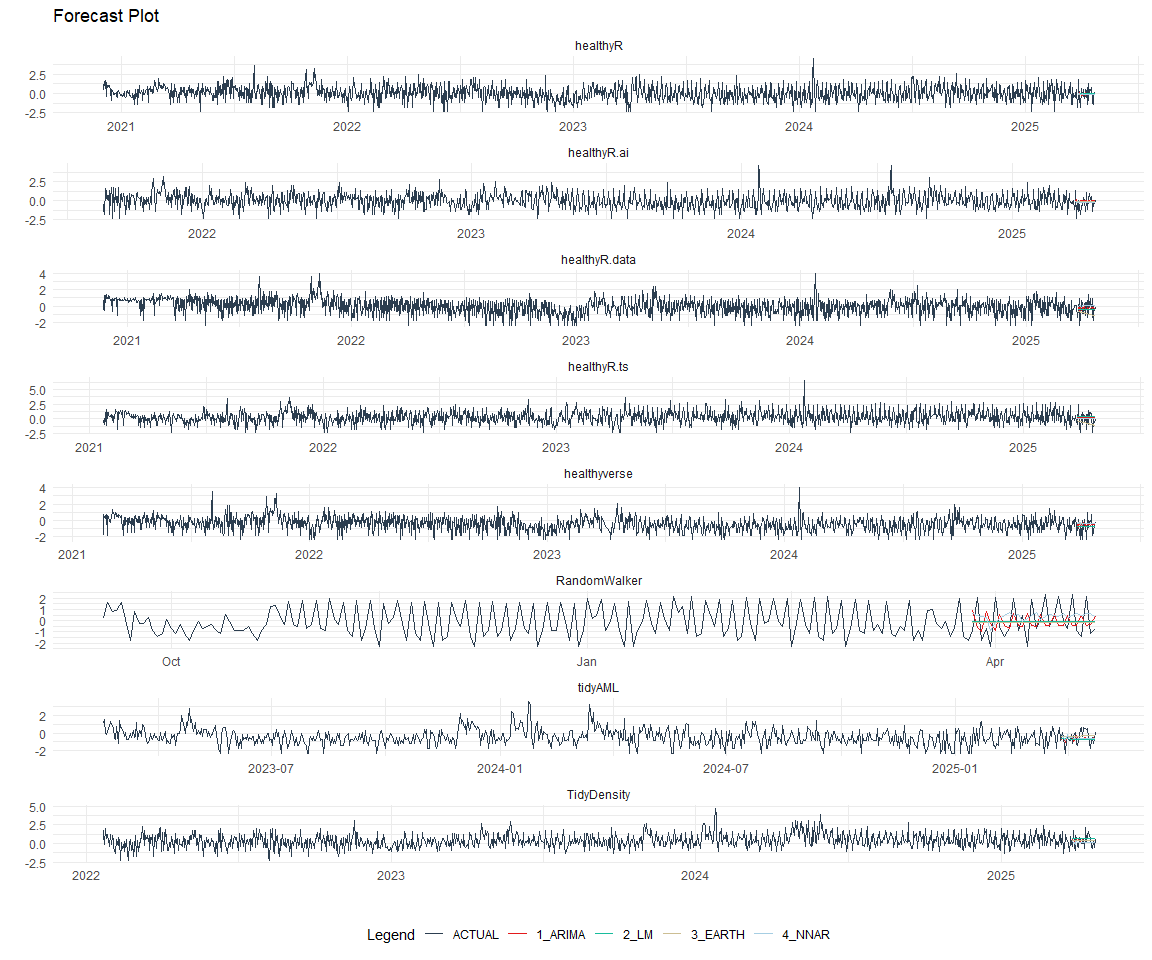
Best Model
best_nested_modeltime_tbl <- nested_modeltime_tbl %>%
modeltime_nested_select_best(
metric = "rmse",
minimize = TRUE,
filter_test_forecasts = TRUE
)
best_nested_modeltime_tbl %>%
extract_nested_best_model_report()
# Nested Modeltime Table
# A tibble: 8 × 10
package .model_id .model_desc .type mae mape mase smape rmse rsq
<fct> <int> <chr> <chr> <dbl> <dbl> <dbl> <dbl> <dbl> <dbl>
1 healthyR.da… 1 ARIMA Test 0.630 143. 0.683 134. 0.721 1.07e-1
2 healthyR 2 LM Test 0.558 444. 0.811 112. 0.683 5.44e-2
3 healthyR.ts 3 EARTH Test 0.556 130. 0.648 104. 0.728 4.80e-4
4 healthyverse 4 NNAR Test 0.732 124. 0.712 128. 0.855 8.84e-2
5 healthyR.ai 1 ARIMA Test 0.830 97.3 1.04 179. 0.992 4.81e-1
6 TidyDensity 2 LM Test 0.973 137. 0.609 162. 1.17 2.79e-3
7 tidyAML 1 ARIMA Test 0.526 124. 0.624 126. 0.675 5.22e-2
8 RandomWalker 1 ARIMA Test 0.699 125. 0.667 158. 0.797 2.36e-1
best_nested_modeltime_tbl %>%
extract_nested_test_forecast() %>%
#filter(!is.na(.model_id)) %>%
group_by(package) %>%
filter_by_time(.date_var = .index, .start_date = max(.index) - 60) %>%
ungroup() %>%
plot_modeltime_forecast(
.interactive = FALSE,
.conf_interval_alpha = 0.2,
.facet_scales = "free"
) +
facet_wrap(~ package, nrow = 3) +
theme_minimal() +
theme(legend.position = "bottom")
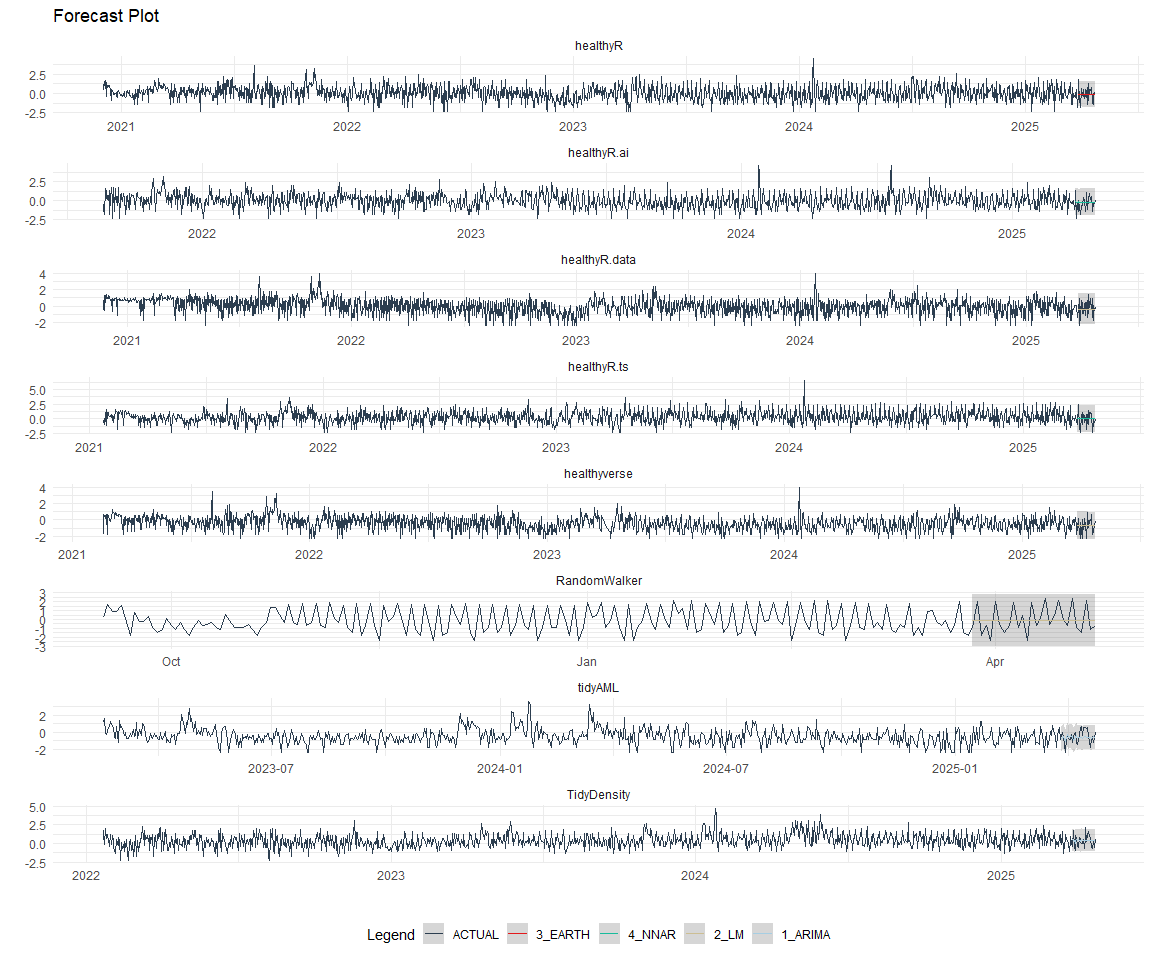
Refitting and Future Forecast
Now that we have the best models, we can make our future forecasts.
nested_modeltime_refit_tbl <- best_nested_modeltime_tbl %>%
modeltime_nested_refit(
control = control_nested_refit(verbose = TRUE)
)
nested_modeltime_refit_tbl
# Nested Modeltime Table
# A tibble: 8 × 5
package .actual_data .future_data .splits .modeltime_tables
<fct> <list> <list> <list> <list>
1 healthyR.data <tibble> <tibble> <split [1807|28]> <mdl_tm_t [1 × 5]>
2 healthyR <tibble> <tibble> <split [1798|28]> <mdl_tm_t [1 × 5]>
3 healthyR.ts <tibble> <tibble> <split [1743|28]> <mdl_tm_t [1 × 5]>
4 healthyverse <tibble> <tibble> <split [1714|28]> <mdl_tm_t [1 × 5]>
5 healthyR.ai <tibble> <tibble> <split [1540|28]> <mdl_tm_t [1 × 5]>
6 TidyDensity <tibble> <tibble> <split [1391|28]> <mdl_tm_t [1 × 5]>
7 tidyAML <tibble> <tibble> <split [998|28]> <mdl_tm_t [1 × 5]>
8 RandomWalker <tibble> <tibble> <split [421|28]> <mdl_tm_t [1 × 5]>
nested_modeltime_refit_tbl %>%
extract_nested_future_forecast() %>%
group_by(package) %>%
mutate(across(.value:.conf_hi, .fns = ~ standard_inv_vec(
x = .,
mean = std_mean,
sd = std_sd
)$standard_inverse_value)) %>%
mutate(across(.value:.conf_hi, .fns = ~ liiv(
x = .,
limit_lower = limit_lower,
limit_upper = limit_upper,
offset = offset
)$rescaled_v)) %>%
filter_by_time(.date_var = .index, .start_date = max(.index) - 60) %>%
ungroup() %>%
plot_modeltime_forecast(
.interactive = FALSE,
.conf_interval_alpha = 0.2,
.facet_scales = "free"
) +
facet_wrap(~ package, nrow = 3) +
theme_minimal() +
theme(legend.position = "bottom")
